Cambium Networks XN12 WIRELESS LAN ARRAY User Manual
Xirrus, Inc. WIRELESS LAN ARRAY
Contents
- 1. Users Manual 1of5
- 2. Users Manual 2of5
- 3. Users Manual 3of5
- 4. Users Manual 4of5
- 5. Users Manual 5of5
- 6. A Pages 1 to 125 from ArrayGuide Rel4 SS Dec02 2008
- 7. B Pages 126 to 225 from ArrayGuide Rel 4 SS Dec02 2008
- 8. C Pages 226 to 350 from ArrayGuide Rel4 SS Dec02 2008
- 9. D Pages 351 to 496 from ArrayGuide Rel4 SS Dec02 2008 Small 5
- 10. XN Guide small 1 of 5 revised
A Pages 1 to 125 from ArrayGuide Rel4 SS Dec02 2008
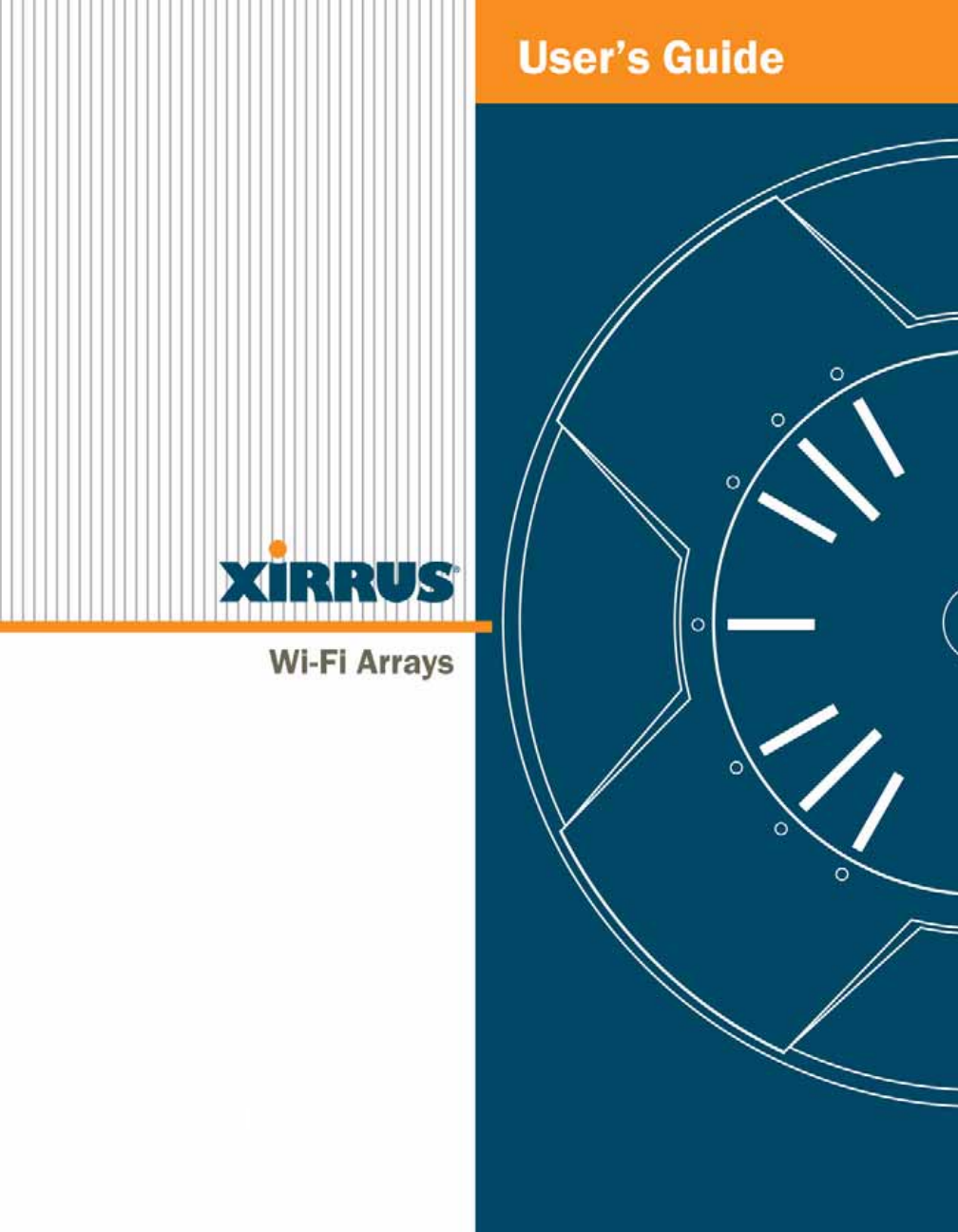
December 2, 2008

All rights reserved. This document may not be reproduced or
disclosed in whole or in part by any means without the written
consent of Xirrus, Inc.
Part Number: 800-0006-001
(Revision S)
Wi-Fi Array
XN16, XN12, XN8, XN4
XS16, XS12, XS8, XS4
XS-3900, XS-3700, XS-3500
™

Trademarks
is a registered trademark of Xirrus, Inc. All other trademarks and brand
names are marks of their respective holders.
Please see Legal Notices, Warnings, Compliance Statements, and Warranty and
License Agreements in “Appendix E: Notices” on page 431.
Xirrus, Inc.
2101 Corporate Center Drive
Thousand Oaks, CA 91320
USA
Tel: 1.805.262.1600
1.800.947.7871 Toll Free in the US
Fax: 1.866.462.3980
www.xirrus.com

Wi-Fi Array
Table of Contents i
Table of Contents
List of Figures...................................................................................... xi
Introduction......................................................................................... 1
The Xirrus Family of Products ............................................................................... 2
Nomenclature .................................................................................................... 4
About this User’s Guide ..........................................................................................4
Organization ...................................................................................................... 4
Notes and Cautions ..........................................................................................6
Screen Images .................................................................................................... 6
Your User’s Guide as a PDF Document ........................................................ 6
Hyperlinks ......................................................................................................... 7
Window or Page? .............................................................................................. 7
Why Choose the Xirrus Wi-Fi Array? ................................................................... 7
Wi-Fi Array Product Overview .............................................................................8
Enterprise Class Security .................................................................................9
Wi-Fi Array Product Family ........................................................................... 9
XN Family of Arrays ................................................................................. 9
XS Family of Arrays ................................................................................ 10
Deployment Flexibility .................................................................................. 11
Power over Gigabit Ethernet (PoGE) (Optional) ................................12
Enterprise Class Management ...................................................................... 13
Key Features and Benefits ..................................................................................... 16
High Capacity and High Performance ........................................................16
Extended Coverage .........................................................................................17
Flexible Coverage Schemes .................................................................... 18
Non-Overlapping Channels ..........................................................................18
Secure Wireless Access ..................................................................................18
Applications Enablement .............................................................................. 19
SDMA Optimization ...................................................................................... 19
Fast Roaming ................................................................................................... 19
Easy Deployment ............................................................................................ 19
Product Specifications—XN16, XN12, and XN8 ...............................................20
Product Specifications—XN4 xxxx ...................................................................... 27

Wi-Fi Array
ii Table of Contents
Product Specifications—XS16/XS-3900, XS12, and
XS8/XS-3700 ........................................................................................................... 34
Product Specifications—XS4/XS-3500 ............................................................... 39
Installing the Wi-Fi Array................................................................. 45
Installation Prerequisites ...................................................................................... 45
Optional Network Components ................................................................... 47
Client Requirements ....................................................................................... 47
Planning Your Installation .................................................................................... 48
General Deployment Considerations ..........................................................48
Coverage and Capacity Planning .................................................................50
Placement ..................................................................................................50
RF Patterns ................................................................................................51
Capacity and Cell Sizes ...........................................................................52
Fine Tuning Cell Sizes ............................................................................. 53
Roaming Considerations ........................................................................ 54
Allocating Channels ................................................................................ 54
Deployment Examples ............................................................................ 57
IEEE 802.11n Deployment Considerations ................................................. 59
MIMO (Multiple-In Multiple-Out) ........................................................ 60
Multiple Data Streams—Spatial Multiplexing .................................... 61
Channel Bonding .....................................................................................63
Improved MAC Throughput ................................................................. 64
Short Guard Interval ...............................................................................64
Obtaining Higher Data Rates .................................................................65
802.11n Capacity ......................................................................................66
Failover Planning ............................................................................................ 67
Port Failover Protection ..........................................................................67
Switch Failover Protection .....................................................................68
Power Planning ............................................................................................... 69
AC Power .................................................................................................. 69
Power over Gigabit Ethernet .................................................................69
Security Planning ............................................................................................ 70
Wireless Encryption ................................................................................ 70
Authentication ......................................................................................... 70
Meeting PCI DSS Standards ...................................................................71
Meeting FIPS Standards .........................................................................71

Wi-Fi Array
Table of Contents iii
Port Requirements ..........................................................................................72
Network Management Planning ..................................................................75
WDS Planning .................................................................................................76
Deployment Summary ...................................................................................79
Installation Workflow ...........................................................................................80
Unpacking the Wi-Fi Array ..................................................................................81
Installing Your Wi-Fi Array ..................................................................................83
Choosing a Location .......................................................................................83
Wiring Considerations ............................................................................ 84
Mounting the Array on a Ceiling ................................................................. 86
Attaching the T-Bar Clips to the Template .......................................... 86
Secure the T-Bar Clips to the Ceiling Support Grid ...........................87
Installing the Mounting Plate ................................................................ 88
Connecting the Cables—AC Option ..................................................... 89
Connecting the Cables—PoGE Option .................................................90
Attaching the Array to the Mounting Plate ......................................... 92
Securing the Array ...................................................................................94
Dismounting the Array ...........................................................................95
Mounting Array on a Wall (All models except 4-port Arrays) ................ 96
Kit Contents (Wall Mount Assembly) ..................................................96
Tools Required .........................................................................................96
Mark the Wall Position ........................................................................... 97
Install the SNAPTOGGLE™ Toggle Bolts ...........................................98
Attach the Mounting Plate to the Wall Mounting Bracket ................99
Attach the Wall Mounting Bracket/Plate Assembly to the Wall ..... 99
Mount the Array .................................................................................... 100
Mounting the Wi-Fi Array on a Wall (XS4 and XS-3500) .......................101
Kit Contents (Wall Mount Assembly) ................................................101
Tools Required .......................................................................................101
Mark the Wall Position ......................................................................... 102
Install the SNAPTOGGLE™ Toggle Bolts .........................................102
Attach the Mounting Plate to the Wall Mounting Bracket ..............104
Attach the Wall Mounting Bracket/Plate Assembly to the Wall ... 105
Mount the Array .................................................................................... 106
Removing the Array .............................................................................. 107
Powering Up the Wi-Fi Array ............................................................................ 107
Array LED Operating Sequences ............................................................... 108

Wi-Fi Array
iv Table of Contents
LED Boot Sequence ............................................................................... 108
LED Operation when Array is Running ............................................109
Establishing Communication with the Array ..................................................110
Using the Serial Port .....................................................................................110
Using the Ethernet Ports .............................................................................. 110
Logging In ......................................................................................................111
Performing the Express Setup Procedure ......................................................... 112
Procedure for Performing an Express Setup ............................................112
The Web Management Interface................................................ 119
An Overview ........................................................................................................120
Structure of the WMI ........................................................................................... 121
User Interface .......................................................................................................123
Utility Buttons ........................................................................................124
Logging In ............................................................................................................. 126
Applying Configuration Changes .....................................................................126
Character Restrictions .................................................................................. 126
Viewing Status on the Wi-Fi Array............................................... 127
Array Status Windows ........................................................................................ 127
Array Summary ............................................................................................ 128
Content of the Array Summary Window .......................................... 129
Array Information ........................................................................................ 132
Array Configuration ..................................................................................... 132
Admin History .............................................................................................. 134
Network Status Windows ...................................................................................134
Network Map ................................................................................................ 135
Content of the Network Map Window .............................................. 135
Spanning Tree Status .................................................................................... 136
Routing Table ................................................................................................ 138
ARP Table ......................................................................................................138
DHCP Leases .................................................................................................139
Connection Tracking/NAT ......................................................................... 139
CDP Neighbors ............................................................................................. 140
RF Monitor Windows .......................................................................................... 141
IAPs ................................................................................................................. 142
Spectrum Analyzer ...................................................................................... 143

Wi-Fi Array
Table of Contents v
Intrusion Detection ......................................................................................147
Station Status Windows ...................................................................................... 149
Stations ...........................................................................................................150
Location Map ................................................................................................. 151
RSSI ................................................................................................................. 156
Signal-to-Noise Ratio (SNR) ........................................................................158
Noise Floor ..................................................................................................... 160
Max by IAP .................................................................................................... 162
Statistics Windows ............................................................................................... 163
IAP Statistics Summary ................................................................................ 163
Per-IAP Statistics ........................................................................................... 164
Network Statistics .........................................................................................166
VLAN Statistics ............................................................................................. 167
WDS Statistics ................................................................................................ 168
Filter Statistics ............................................................................................... 169
Station Statistics ............................................................................................ 169
Per-Station Statistics ..................................................................................... 170
System Log Window ........................................................................................... 171
Configuring the Wi-Fi Array.......................................................... 173
Express Setup ........................................................................................................ 174
Network ................................................................................................................. 180
Network Interfaces ......................................................................................181
Network Interface Ports ........................................................................ 182
DNS Settings .................................................................................................. 188
CDP Settings ..................................................................................................189
Services .................................................................................................................. 191
Time Settings (NTP) .....................................................................................192
NetFlow ..........................................................................................................194
System Log .....................................................................................................195
SNMP ..............................................................................................................198
DHCP Server ................................................................................................. 201
VLANs ................................................................................................................... 203
Understanding Virtual Tunnels .......................................................... 203
VLAN Management ..................................................................................... 205
Security .................................................................................................................. 207
Understanding Security ........................................................................208

Wi-Fi Array
vi Table of Contents
Certificates and Connecting Securely to the WMI ............................ 211
Using the Array’s Default Certificate .................................................211
Using an External Certificate Authority .............................................212
Admin Management ....................................................................................213
Admin RADIUS ............................................................................................ 214
Management Control ...................................................................................217
Access Control List .......................................................................................221
Global Settings .............................................................................................. 223
External Radius ............................................................................................. 226
Internal Radius .............................................................................................. 229
Rogue Control List ........................................................................................231
SSIDs ...................................................................................................................... 233
Understanding SSIDs ............................................................................234
Understanding QoS Priority on the Wi-Fi Array .............................. 235
SSID Management ........................................................................................238
SSID List (top of page) .......................................................................... 239
SSID Limits .............................................................................................241
Web Page Redirect Configuration Settings ........................................243
Groups ................................................................................................................... 245
Understanding Groups ......................................................................... 245
Using Groups ......................................................................................... 246
Group Management ..................................................................................... 247
Group Limits ..........................................................................................249
IAPs ........................................................................................................................ 252
Understanding Fast Roaming .............................................................. 253
IAP Settings ................................................................................................... 254
Global Settings (IAP) ...................................................................................259
Beacon Configuration ........................................................................... 261
Station Management .............................................................................261
Advanced Traffic Optimization ..........................................................262
Global Settings .11a ......................................................................................266
Global Settings .11bg ....................................................................................269
Global Settings .11n ...................................................................................... 273
Advanced RF Settings ..................................................................................275
About Standby Mode ............................................................................ 275
About Blocking Rogue APs ..................................................................276
RF Intrusion Detection .......................................................................... 277

Wi-Fi Array
Table of Contents vii
RF Resilience .......................................................................................... 278
RF Power & Sensitivity ......................................................................... 279
RF Spectrum Management ................................................................... 280
LED Settings ..................................................................................................283
WDS ....................................................................................................................... 285
About Configuring WDS Links ........................................................... 285
WDS Client Links .......................................................................................... 287
Filters ..................................................................................................................... 289
Filter Lists ......................................................................................................290
Filter Management ....................................................................................... 291
Using Tools on the Wi-Fi Array..................................................... 295
System Tools .........................................................................................................296
System ..................................................................................................... 297
Configuration ......................................................................................... 298
Diagnostics .............................................................................................299
Web Page Redirect ................................................................................. 300
Tools ........................................................................................................ 301
Progress and Status Frames ................................................................. 303
CLI .......................................................................................................................... 303
Logout .................................................................................................................... 305
The Command Line Interface...................................................... 307
Establishing a Secure Shell (SSH) Connection .................................................308
Getting Started with the CLI .............................................................................. 309
Inputting Commands ...................................................................................309
Getting Help .................................................................................................. 309
Top Level Commands .........................................................................................311
Root Command Prompt ...............................................................................311
configure Commands ...................................................................................312
show Commands ..........................................................................................315
statistics Commands .....................................................................................318
Configuration Commands .................................................................................. 320
acl .................................................................................................................... 320
admin ..............................................................................................................321
cdp ................................................................................................................... 322
clear ................................................................................................................. 323

Wi-Fi Array
viii Table of Contents
contact-info .................................................................................................... 324
date-time ........................................................................................................ 325
dhcp-server .................................................................................................... 326
dns ................................................................................................................... 327
file .................................................................................................................... 328
filter ................................................................................................................. 331
fips ................................................................................................................... 333
group ..............................................................................................................334
hostname ........................................................................................................ 334
https ................................................................................................................ 335
interface ..........................................................................................................336
load ................................................................................................................. 337
location ........................................................................................................... 337
management .................................................................................................. 338
more ................................................................................................................ 338
netflow ............................................................................................................339
no ..................................................................................................................... 340
pci-audit ......................................................................................................... 342
quit .................................................................................................................. 343
radius-server .................................................................................................. 343
reboot .............................................................................................................. 344
reset ................................................................................................................. 344
run-tests ..........................................................................................................345
security ...........................................................................................................347
snmp ............................................................................................................... 348
ssh .................................................................................................................... 348
ssid .................................................................................................................. 350
standby ...........................................................................................................350
syslog ..............................................................................................................351
telnet ...............................................................................................................352
uptime .............................................................................................................354
vlan .................................................................................................................. 354
Sample Configuration Tasks .............................................................................. 356
Configuring a Simple Open Global SSID .................................................. 357
Configuring a Global SSID using WPA-PEAP .........................................358
Configuring an SSID-Specific SSID using WPA-PEAP ...........................359
Enabling Global IAPs ...................................................................................360

Wi-Fi Array
Table of Contents ix
Disabling Global IAPs .................................................................................. 361
Enabling a Specific IAP ................................................................................ 362
Disabling a Specific IAP ...............................................................................363
Setting Cell Size Auto-Configuration for All IAPs .................................. 364
Setting the Cell Size for All IAPs ................................................................ 365
Setting the Cell Size for a Specific IAP ....................................................... 366
Configuring VLANs on an Open SSID ...................................................... 367
Configuring Radio Assurance Mode (Loopback Tests) .......................... 368
Appendices..................................................................................... 371
Appendix A: Servicing the Wi-Fi Array ............................................................. 373
Removing the Access Panel ................................................................................375
Reinstalling the Access Panel ............................................................................. 378
Replacing the FLASH Memory Module ........................................................... 380
Replacing the Main System Memory ................................................................ 382
Replacing the Integrated Access Point Radio Module ...................................384
Replacing the Power Supply Module ...............................................................387
Appendix B: Quick Reference Guide ............................................................... 389
Factory Default Settings ......................................................................................389
Host Name ..................................................................................................... 389
Network Interfaces ....................................................................................... 389
Serial ........................................................................................................ 389
Gigabit 1 and Gigabit 2 .........................................................................390
Fast Ethernet ...........................................................................................390
Integrated Access Points (IAPs) ..................................................................391
Server Settings ...............................................................................................392
NTP ..........................................................................................................392
Syslog ...................................................................................................... 392
SNMP ...................................................................................................... 392
DHCP ..............................................................................................................393
Default SSID .................................................................................................. 393
Security ..........................................................................................................394
Global Settings - Encryption ...............................................................394
External RADIUS (Global) .................................................................. 394
Internal RADIUS ....................................................................................395
Administrator Account and Password ...................................................... 396

Wi-Fi Array
x Table of Contents
Management .................................................................................................. 396
Keyboard Shortcuts ............................................................................................. 396
Appendix C: Technical Support ........................................................................ 399
General Hints and Tips ....................................................................................... 399
Frequently Asked Questions .............................................................................. 400
Multiple SSIDs ............................................................................................... 400
Security ...........................................................................................................402
VLAN Support .............................................................................................. 405
Array Monitor and Radio Assurance Capabilities ..........................................408
Enabling Monitoring on the Array ..................................................... 408
How Monitoring Works ............................................................................... 408
Radio Assurance ...........................................................................................409
Radio Assurance Options .....................................................................410
Upgrading the Array via CLI .............................................................................411
Sample Output for the Upgrade Procedure: ............................................. 412
Power over Gigabit Ethernet Compatibility Matrix .......................................416
Additional Note: ....................................................................................417
Determining If an XS-3700 or XS-3900 is Modified for PoGE ......... 418
Contact Information ............................................................................................419
Appendix D: Implementing Security Standards ............................................. 421
Implementing PCI DSS on the Wi-Fi Array .....................................................421
The pci-audit Command ....................................................................... 421
Implementing FIPS Security on the Wi-Fi Array ............................................ 422
Appendix E: Notices ...........................................................................................431
Notices ................................................................................................................... 431
EU Directive 1999/5/EC Compliance Information ........................................ 434
Safety Warnings ...................................................................................................442
Translated Safety Warnings ............................................................................... 443
Software Warranty and License Agreement .................................................... 444
Hardware Warranty Agreement .......................................................................451
Glossary of Terms.......................................................................... 453
Index................................................................................................ 465

Wi-Fi Array
List of Figures xi
List of Figures
Figure 1. Xirrus Arrays............................................................................................... 2
Figure 2. The Xirrus Management System.............................................................. 3
Figure 3. Wi-Fi Array (XN16)....................................................................................8
Figure 4. Wireless Coverage Patterns .................................................................... 11
Figure 5. XP8 - Power over Ethernet Usage..........................................................12
Figure 6. WMI: Array Status....................................................................................14
Figure 7. Layout of IAPs (XN16).............................................................................16
Figure 8. Naming of IAPs (XS16)............................................................................ 17
Figure 9. Coverage Schemes....................................................................................18
Figure 10. Wall Thickness Considerations.............................................................. 49
Figure 11. Unit Placement..........................................................................................50
Figure 12. Full (Normal) Coverage........................................................................... 51
Figure 13. Adjusting RF Patterns.............................................................................. 51
Figure 14. Custom Coverage.....................................................................................52
Figure 15. Connection Rate vs. Distance.................................................................. 52
Figure 16. Transmit Power.........................................................................................53
Figure 17. Overlapping Cells.....................................................................................54
Figure 18. Allocating Channels Manually............................................................... 56
Figure 19. Deployment Scenario (54 Mbps)—Per Sector ...................................... 57
Figure 20. Deployment Scenario (36 Mbps)—Per Sector ...................................... 57
Figure 21. Deployment Scenario (18 Mbps)—Per Sector ...................................... 58
Figure 22. Classic 802.11 Signal Transmission........................................................60
Figure 23. MIMO Signal Processing......................................................................... 61
Figure 24. Spatial Multiplexing................................................................................. 62
Figure 25. Channel Bonding......................................................................................63
Figure 26. MAC Throughput Improvements..........................................................64
Figure 27. Computing 802.11n Data Rates .............................................................. 65
Figure 28. 802.11n Capacity....................................................................................... 66
Figure 29. Port Failover Protection........................................................................... 67
Figure 30. Switch Failover Protection ...................................................................... 68
Figure 31. Port Requirements for XMS.................................................................... 72
Figure 32. WDS Link................................................................................................... 76
Figure 33. A Multiple Hop WDS Connection......................................................... 77
Figure 34. WDS Failover Protection......................................................................... 77

Wi-Fi Array
xii List of Figures
Figure 35. Installation Workflow.............................................................................. 80
Figure 36. Array Placement.......................................................................................83
Figure 37. Attaching the T-Bar Clips to the Template........................................... 86
Figure 38. Attaching the T-Bar Clips to the Ceiling Grid...................................... 87
Figure 39. Installing the Mounting Plate................................................................. 88
Figure 40. Connecting the Cables.............................................................................89
Figure 41. Connecting the Cables (PoGE—XS8/XS12/XS16) .............................. 90
Figure 42. Connecting the Cable (PoGE—XS4) ......................................................91
Figure 43. Attaching the Unit (XS4 shown)............................................................. 92
Figure 44. Attaching the Unit (XS-3900) .................................................................. 93
Figure 45. Securing the Array....................................................................................94
Figure 46. IAP Positions (XS16 shown)....................................................................95
Figure 47. Wall Mount—Marking the Holes........................................................... 97
Figure 48. Installing the Toggle Bolts.......................................................................98
Figure 49. Attaching the Wall Mounting Plate....................................................... 99
Figure 50. Mounting the Array on a Wall ............................................................. 100
Figure 51. Wall Mount—Marking the Holes......................................................... 102
Figure 52. Installing the Toggle Bolts.....................................................................103
Figure 53. Attaching the Array Mounting Plate...................................................104
Figure 54. Attaching the Wall Mounting Bracket to the Wall............................ 105
Figure 55. Mounting the Array on a Wall ............................................................. 106
Figure 56. LED Locations (XS-3900)....................................................................... 107
Figure 57. Network Interface Ports.........................................................................110
Figure 58. Express Setup.......................................................................................... 112
Figure 59. LEDs are Switched On........................................................................... 117
Figure 60. Web Management Interface..................................................................120
Figure 61. WMI: Frames........................................................................................... 123
Figure 62. WMI: Utility Buttons.............................................................................. 124
Figure 63. Feedback Form........................................................................................125
Figure 64. Logging In to the Wi-Fi Array.............................................................. 126
Figure 65. Array Summary......................................................................................128
Figure 66. Disabled IAP (Partial View).................................................................. 130
Figure 67. IAP Cells .................................................................................................. 131
Figure 68. Array Information..................................................................................132
Figure 69. Show Configuration............................................................................... 133
Figure 70. Admin Login History............................................................................. 134
Figure 71. Network Map.......................................................................................... 135

Wi-Fi Array
List of Figures xiii
Figure 72. Spanning Tree Status..............................................................................137
Figure 73. Routing Table..........................................................................................138
Figure 74. ARP Table................................................................................................138
Figure 75. DHCP Leases........................................................................................... 139
Figure 76. Connection Tracking.............................................................................. 139
Figure 77. CDP Neighbors....................................................................................... 140
Figure 78. RF Monitor—IAPs..................................................................................142
Figure 79. RF Spectrum Analyzer........................................................................... 144
Figure 80. Intrusion Detection/Rogue AP List..................................................... 147
Figure 81. Categorizing APs....................................................................................148
Figure 82. Stations..................................................................................................... 150
Figure 83. Location Map........................................................................................... 151
Figure 84. Controls for Location Map....................................................................152
Figure 85. Minimizing stations................................................................................ 153
Figure 86. Setting Array location on a Custom Image.........................................155
Figure 87. Station RSSI Values ................................................................................ 156
Figure 88. Station RSSI Values—Colorized Graphical View.............................. 157
Figure 89. Station Signal-to-Noise Ratio Values................................................... 158
Figure 90. Station SNR Values—Colorized Graphical View.............................. 159
Figure 91. Station Noise Floor Values.................................................................... 160
Figure 92. Station Noise Floor Values—Colorized Graphical View..................161
Figure 93. Max by IAP.............................................................................................. 162
Figure 94. IAP Statistics Summary Page................................................................164
Figure 95. Individual IAP Statistics Page (for IAP abg(n)1) ............................... 165
Figure 96. Network Statistics...................................................................................166
Figure 97. VLAN Statistics.......................................................................................167
Figure 98. WDS Statistics .........................................................................................168
Figure 99. Filter Statistics......................................................................................... 169
Figure 100. Station Statistics......................................................................................169
Figure 101. Individual Station Statistics Page......................................................... 170
Figure 102. System Log .............................................................................................171
Figure 103. WMI: Express Setup............................................................................... 174
Figure 104. LEDs are Switched On........................................................................... 179
Figure 105. Network Interfaces.................................................................................180
Figure 106. Network Settings....................................................................................181
Figure 107. Network Interface Ports......................................................................... 182
Figure 108. Port Modes (a-b) ..................................................................................... 184

Wi-Fi Array
xiv List of Figures
Figure 109. Port Modes (c-d) ..................................................................................... 185
Figure 110. Port Modes (e-f)......................................................................................186
Figure 111. DNS Settings............................................................................................ 188
Figure 112. CDP Settings............................................................................................ 189
Figure 113. Services.....................................................................................................191
Figure 114. Time Settings (Manual Time)................................................................ 192
Figure 115. Time Settings (NTP Time Enabled)...................................................... 193
Figure 116. NetFlow....................................................................................................194
Figure 117. System Log .............................................................................................. 195
Figure 118. SNMP ....................................................................................................... 198
Figure 119. DHCP Management............................................................................... 201
Figure 120. VLANs...................................................................................................... 203
Figure 121. VLAN Management............................................................................... 205
Figure 122. Security..................................................................................................... 207
Figure 123. Import Xirrus Certificate Authority..................................................... 212
Figure 124. Admin Management..............................................................................213
Figure 125. Admin RADIUS......................................................................................215
Figure 126. Management Control.............................................................................217
Figure 127. Access Control List.................................................................................221
Figure 128. Global Settings (Security)...................................................................... 223
Figure 129. External RADIUS Server ....................................................................... 226
Figure 130. Internal RADIUS Server........................................................................229
Figure 131. Rogue Control List ................................................................................. 231
Figure 132. SSIDs......................................................................................................... 233
Figure 133. Four Traffic Classes................................................................................ 235
Figure 134. SSID Management.................................................................................. 238
Figure 135. WPR Internal Splash Page Fields (SSID Management)..................... 243
Figure 136. Groups...................................................................................................... 245
Figure 137. Group Management............................................................................... 247
Figure 138. IAPs........................................................................................................... 252
Figure 139. IAP Settings............................................................................................. 254
Figure 140. Global Settings (IAPs)............................................................................ 259
Figure 141. Global Settings .11a................................................................................ 266
Figure 142. Global Settings .11bg.............................................................................. 269
Figure 143. Global Settings .11n xxx Replace!!........................................................ 273
Figure 144. Advanced RF Settings ........................................................................... 275
Figure 145. LED Settings............................................................................................ 283

Wi-Fi Array
List of Figures xv
Figure 146. WDS.......................................................................................................... 285
Figure 147. .Configuring a WDS Link...................................................................... 286
Figure 148. WDS Client Links................................................................................... 287
Figure 149. Filters........................................................................................................ 289
Figure 150. Filter Lists ................................................................................................ 290
Figure 151. Filter Management ................................................................................. 291
Figure 152. System Tools............................................................................................296
Figure 153. Saving the Diagnostic Log.....................................................................299
Figure 154. Managing WPR Splash/Login page files............................................300
Figure 155. System Command (Ping)....................................................................... 301
Figure 156. Radius Ping Output................................................................................ 302
Figure 157. CLI Window............................................................................................ 303
Figure 158. Login Window........................................................................................ 305
Figure 159. Logging In................................................................................................308
Figure 160. Help Window.......................................................................................... 309
Figure 161. Full Help.................................................................................................. 310
Figure 162. Partial Help.............................................................................................. 310
Figure 163. Configuring a Simple Open Global SSID............................................357
Figure 164. Configuring a Global SSID using WPA-PEAP...................................358
Figure 165. Configuring an SSID-Specific SSID using WPA-PEAP.....................359
Figure 166. Enabling Global IAPs............................................................................. 360
Figure 167. Disabling Global IAPs............................................................................ 361
Figure 168. Enabling a Specific IAP.......................................................................... 362
Figure 169. Disabling a Specific IAP......................................................................... 363
Figure 170. Setting the Cell Size for All IAPs..........................................................364
Figure 171. Setting the Cell Size for All IAPs..........................................................365
Figure 172. Setting the Cell Size for a Specific IAP................................................ 366
Figure 173. Configuring VLANs on an Open SSID................................................ 367
Figure 174. Configuring Radio Assurance Mode (Loopback Testing)................ 369
Figure 175. Disconnecting Power from the Array.................................................. 373
Figure 176. Removing the Access Panel Screws.....................................................375
Figure 177. Removing the Access Panel .................................................................. 376
Figure 178. Disconnecting the Power Supply and Fan..........................................376
Figure 179. Reconnecting the Fan and Power Supply...........................................378
Figure 180. Reinstalling the Access Panel................................................................ 378
Figure 181. Removing the FLASH Memory Module............................................. 380
Figure 182. Removing the DIMM Memory Module..............................................382

Wi-Fi Array
xvi List of Figures
Figure 183. Removing the Chassis Cover Screws................................................... 384
Figure 184. Removing the Chassis Cover................................................................ 384
Figure 185. Lifting the Integrated Access Point Module....................................... 385
Figure 186. Disconnect the Integrated Access Point Module ............................... 385
Figure 187. Installing a New Access Panel (with Power Supply)........................ 387
Figure 188. XN8/XN12/XN16 and XS8/XS12/XS16 Support PoGE without a
Splitter 418
Figure 189. Determining if XS-37000/3900 is modified ........................................ 418
Figure 190. Sample output of pci-audit command................................................. 422
Figure 191. Applying Three Seals to the XS16/XS12/XS8 or XS-3900/XS-3700 423
Figure 192. Applying Two Tamper-evident seals to the XS4 or XS-3500 ...........424
Figure 193. SSID Management Window................................................................. 425
Figure 194. Security/Global Settings Window....................................................... 426
Figure 195. Security/Management Control Window............................................ 427
Figure 196. Services/SNMP Window...................................................................... 427
Figure 197. IAPs/Global Settings Screen................................................................. 428

Wi-Fi Array
Introduction 1
Introduction
These topics introduce the Xirrus Wi-Fi Array, including an overview of its key
features and benefits, and a detailed listing of the product’s physical,
environmental, technology and regulatory specifications.
z“The Xirrus Family of Products” on page 2.
z“About this User’s Guide” on page 4.
z“Why Choose the Xirrus Wi-Fi Array?” on page 7.
z“Wi-Fi Array Product Overview” on page 8.
z“Key Features and Benefits” on page 16.
z“Product Specifications—XN16, XN12, and XN8” on page 20.
z“Product Specifications—XS16/XS-3900, XS12, and XS8/XS-3700” on
page 34.
z“Product Specifications—XS4/XS-3500” on page 39.
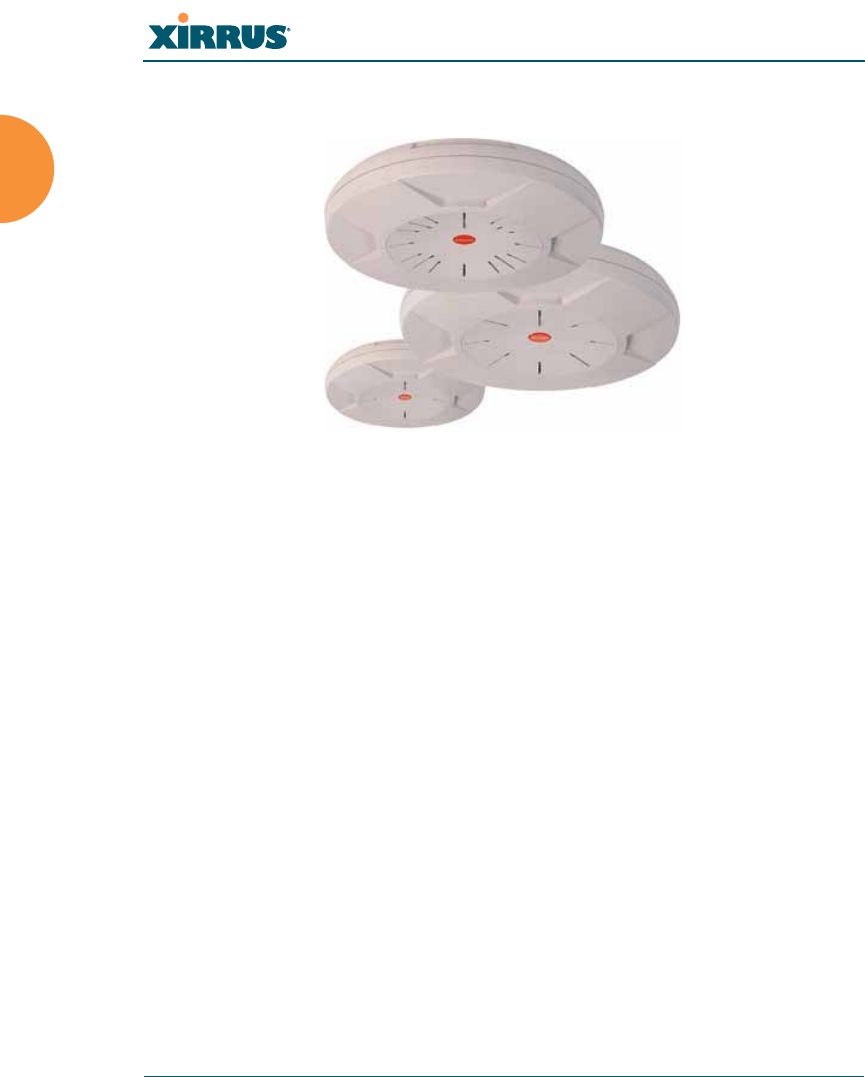
Wi-Fi Array
2 Introduction
The Xirrus Family of Products
Figure 1. Xirrus Arrays
The Xirrus family of products includes the following:
zThe XS Series of Xirrus Wi-Fi Arrays (XS16 / XS12 / XS8 / XS4)
XS Arrays integrate multiple Integrated Access Points—radios with high-
gain directional antennas for increased range and coverage. The Array
also incorporates an onboard multi-gigabit switch, Wi-Fi controller, and
firewall into a single device, along with a dedicated Wi-Fi threat sensor
and an embedded spectrum analyzer. The Wi-Fi Array provides more
than enough bandwidth, security, and control to replace switched
Ethernet to the desktop as the primary network connection. The XS16 has
16 IAPs, the XS12 has 12 IAPs, the XS8 has 8 IAPs, and the XS4 has 4 IAPs.
zThe XN Series of Xirrus Wi-Fi Arrays (XN16 / XN12 / XN8 / XN4)
The newest Xirrus Wi-Fi Arrays add the speed and reach of IEEE 802.11n
technology to the XS series of Arrays. The XN Series of Arrays feature the
capacity and performance needed to replace switched Ethernet to the
desktop. The XN16 has 16 IAPs, the XN12 has 12 IAPs, the XN8 has 8
IAPs, and the XN4 has 4 IAPs.
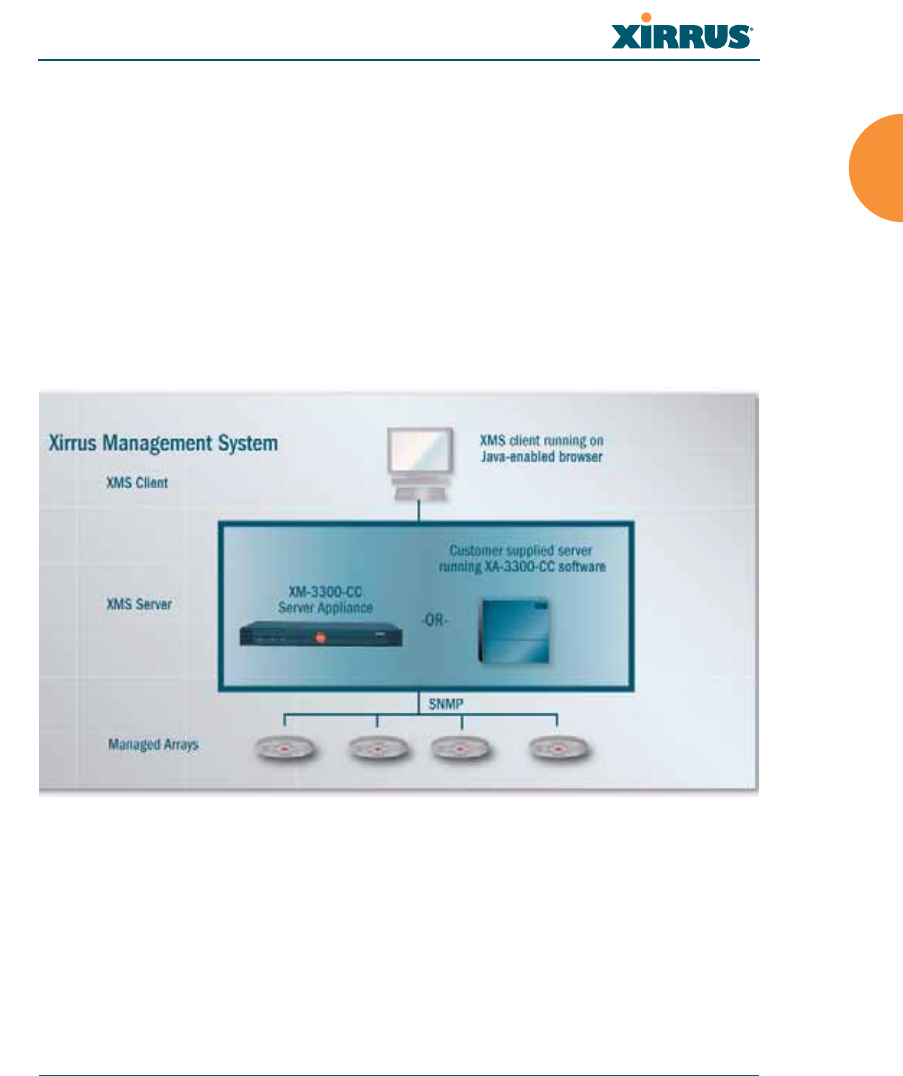
Wi-Fi Array
Introduction 3
zXirrus Management System (XMS)
XMS is used for managing large Array deployments from a centralized
Web-based interface. The XMS server is available pre-installed on the
Xirrus XM-33xx-CC Management Platform Series, or as a software
package (XA-3300-CC) to be installed on your own server hardware.
Figure 2 illustrates the elements of the Xirrus Management System. Users
start the XMS client simply by entering the URL of the XMS server on a
web browser. The XMS server manages a number of Wi-Fi Arrays via
SNMP.
Figure 2. The Xirrus Management System
If you need detailed information about this product, refer to the XMS
User’s Guide, part number 800-0007-001.
zXirrus Power over Gigabit Ethernet (PoGE)
The PoGE modules eliminate the need for running separate power
cabling. Additionally, an eight port module provides distributed power
to multiple Arrays, facilitating backup power when connected via a UPS.

Wi-Fi Array
4 Introduction
Nomenclature
Throughout this User’s Guide, the Xirrus Wi-Fi Array is also referred to as simply
the Array. In some instances, the terms product and unit are also used. When
discussing specific products from the Xirrus family, the product name is used (for
example, XN16, XS12, or XS-3500). The Wi-Fi Array’s operating system is referred
to as the ArrayOS. The Web Management Interface for browser-based
management of the Array is referred to as WMI.
The XS series of Arrays have two types of radios—the 802.11a radios are named
a1 to a12 (for 16-port models). The 802.11a/b/g radios are named abg1 to abg4.
The XN series of Arrays also have two types of radios—the 802.11a/n radios are
named an1 through an12 (for 16-port models). The 802.11a/b/g/n radios are
named abgn1 to abgn4. When referring to a port that may be on either an XN or
XS model, the nomenclature abg(n) and a(n) will be used, e.g., abg(n)2 or a(n)6.
The Xirrus Management System is referred to as XMS. The Power over Gigabit
Ethernet system may be referred to as PoGE.
About this User’s Guide
This User’s Guide provides detailed information and procedures that will enable
wireless network administrators to install, configure and manage the Wi-Fi Array
so that end users can take full advantage of the product’s features and
functionality without technical assistance.
Organization
Topics and procedures are organized by function under the following chapter
headings:
zIntroduction
Provides a brief introduction to wireless technology, an overview of the
product, including its key features and benefits, and presents the product
specifications.
zInstalling the Wi-Fi Array
Defines prerequisites for deploying and installing the Array and provides
instructions to help you plan and complete a successful installation.

Wi-Fi Array
Introduction 5
zThe Web Management Interface
Offers an overview of the product’s embedded Web Management
Interface, including its content and structure. It emphasizes what you
need to do to ensure that any configuration changes you make are
applied, and provides a list of restricted characters. It also includes
instructions for logging in to the Array with your Web browser.
zViewing Status on the Wi-Fi Array
Describes the status and statistics displays available on the Array using
its embedded Web Management Interface.
zConfiguring the Wi-Fi Array
Contains procedures for configuring the Array using its embedded Web
Management Interface.
zUsing Tools on the Wi-Fi Array
Contains procedures for using utility tools provided in the Web
Management Interface. It includes procedures for upgrading the system
firmware, uploading and downloading configurations and other files,
using diagnostic tools, and resetting the Array to its factory defaults.
zThe Command Line Interface
Includes the commands and the command structure used by the Wi-Fi
Array’s Command Line Interface (CLI), and provides a procedure for
establishing a Telnet connection to the Array. This chapter also includes
some sample key configuration tasks using the CLI.
zAppendix A: Servicing the Wi-Fi Array
Contains procedures for servicing the Array, including the removal and
reinstallation of major hardware components.
zAppendix B: Quick Reference Guide
Contains the product’s factory default settings.
zAppendix C: Technical Support
Offers guidance to resolve technical issues, including general hints and
tips to enhance your product experience, and a procedure for isolating
problems within an Array-enabled wireless network. Also includes
Frequently Asked Questions (FAQs) and Xirrus contact information.

Wi-Fi Array
6 Introduction
zAppendix D: Implementing Security Standards
Discusses meeting security standards with the Array, including FIPS and
PCI DSS.
zAppendix E: Notices
Contains the legal notices, licnesing, and compliance statements for the
Array. Please read this section carefully.
zGlossary of Terms
Provides an explanation of terms directly related to Xirrus product
technology, organized alphabetically.
zIndex
The index is a valuable information search tool. Use the index to locate
specific topics discussed in this User’s Guide. Simply click on any page
number in the index to jump to the referenced topic.
Notes and Cautions
The following symbols are used throughout this User’s Guide:
Screen Images
Some screen images of the Web Management Interface have been modified for
clarity. For example, an image may have been cropped to highlight a specific area
of the screen, and/or sample data may be included in some fields.
Your User’s Guide as a PDF Document
This User’s Guide is also made available as a secure PDF (Portable Document
Format) file and can be viewed using the Adobe® Acrobat Reader® product. It
cannot be edited or modified. If you don’t have Acrobat Reader, you can
downloaded it free-of-charge from: http://www.adobe.com.
#This symbol is used for general notes that provide useful supplemental
information.
!This symbol is used for cautions. Cautions provide critical information that
may adversely affect the performance of the product.

Wi-Fi Array
Introduction 7
Hyperlinks
If you click on body text that appears in the color TEAL (with the exception of
headings or notes) the embedded hyperlink within the text will immediately take
you to the referenced destination. All internal and external cross-references,
including page numbers within the List of Figures and the Index, have associated
hyperlinks. After “jumping” to a referenced topic, if you want to return to the
previous page (reference source), simply click on Acrobat’s previous page button.
Window or Page?
Is a window a page, or is a page a window? There seems to be some dispute as to
what the correct term should be. For the sake of consistency, this document uses
the term Window when referring to how the Wi-Fi Array’s Web Management
Interface is displayed on your monitor.
Why Choose the Xirrus Wi-Fi Array?
The deployment of wireless LANs is becoming increasingly common as
businesses strive for greater flexibility in the workplace and the need for
employee mobility rises. The only requirements for an effective wireless
deployment are a power source, a couple of screws, and a little imagination.
Wireless LAN is also fully compatible with standard Ethernet protocols, so
connectivity with existing wired infrastructures is transparent to users—they can
still access and use the same applications and network services that they use
when plugged into the company’s wired LAN infrastructure (it’s only the plug
that no longer exists).
Wireless LAN has come a long way in the past few years and now offers the
performance, reliability and security that Enterprise customers have come to
expect from their networks. The technology is being driven by four major IEEE
standards:
z802.11a
Operates in the 5 GHz range with a maximum speed of 54 Mbps.
z802.11b
Operates in the 2.4 GHz range with a maximum speed of 11 Mbps.
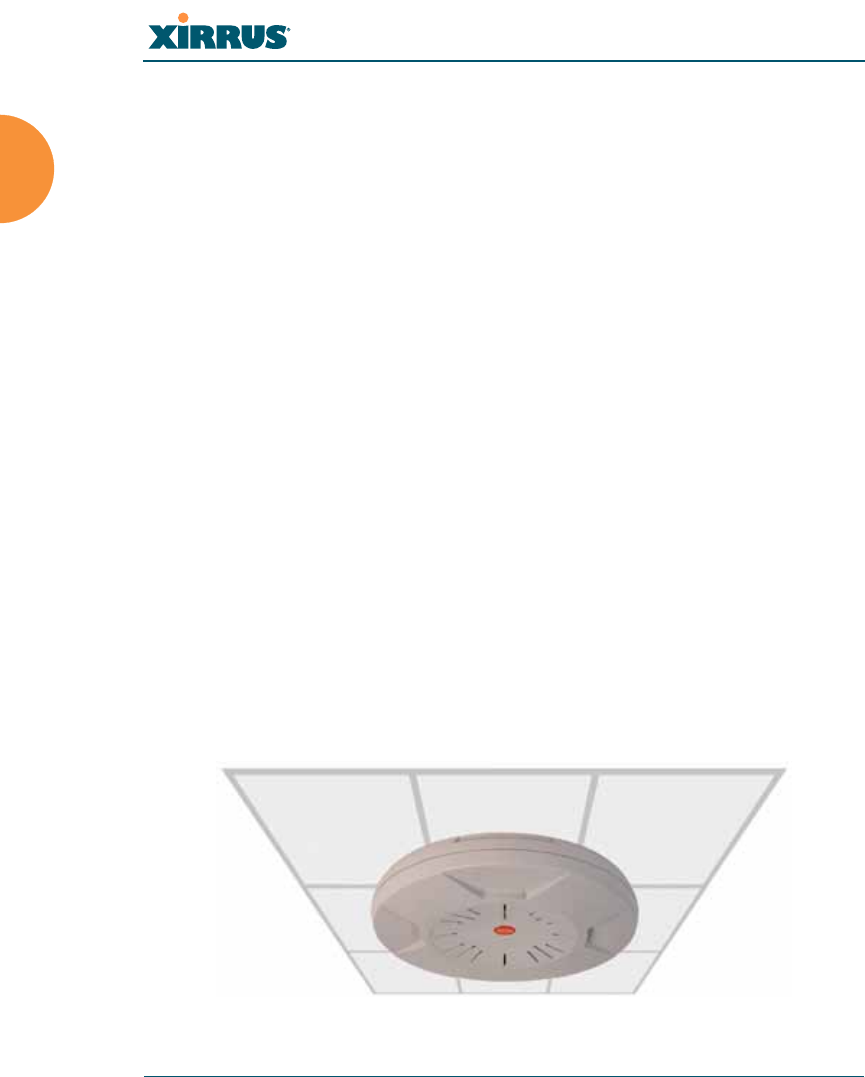
Wi-Fi Array
8 Introduction
z802.11g
Supports a higher transmission speed of 54 Mbps in the 2.4 GHz range
and is backwards compatible with 802.11b.
z802.11n
Uses multiple antennas per radio to boost transmission speed as high as
300 Mbps, increasing throughput, range, and maximum number of users.
802.11n is backwards compatible with 802.11a/b/g.
Whether you have just a handful of users or thousands of users, wireless has the
scalability and flexibility to serve your needs.
See Also
Key Features and Benefits
Wi-Fi Array Product Overview
Product Specifications—XN16, XN12, and XN8
Product Specifications—XS4/XS-3500
Product Specifications—XS16/XS-3900, XS12, and XS8/XS-3700
The Xirrus Family of Products
Wi-Fi Array Product Overview
Part of the family of Xirrus products, the Wi-Fi Array is a high capacity, multi-
mode device designed for the Enterprise market, with twice the range and up to
eight times the capacity of competitive wireless products.
Figure 3. Wi-Fi Array (XN16)

Wi-Fi Array
Introduction 9
The Wi-Fi Array (regardless of the product model) is Wi-Fi® compliant and
simultaneously supports 802.11a, 802.11b and 802.11g clients. XN model arrays
add the enhanced abilities of 802.11n to this combination. Enterprise class features
such as VLAN support and multiple SSID capability enable robust network
compatibility and a high level of scalability and system control. The optional
Xirrus Management System (XMS) allows global management of hundreds of
Arrays from a central location.
Multiple versions of the Array with different numbers of Integrated Access Points
(IAPs) support a variety of deployment applications: 16 IAPs (XN16, XS16,
XS-3900), 12 IAPs (XN12, XS12), 8 IAPs (XN8, XS8, XS-3700), and 4 IAPs (XN4,
XS4, XS-3500).
Enterprise Class Security
The latest and most effective wireless encryption security standards, including
WPA (Wi-Fi Protected Access) and WPA2 with 802.11i AES (Advanced
Encryption Standard) are provided with the Wi-Fi Array. In addition, the use of
an embedded RADIUS server (or 802.1x with an external RADIUS server) ensures
user authentication—multiple Arrays can authenticate to the optional XMS,
ensuring only authorized Arrays become part of the wireless network. Rogue AP
detection, site monitoring, and RF spectrum analysis are performed in the
background by the Array automatically.
Wi-Fi Array Product Family
The following tables provide an overview of the main features supported by the
Wi-Fi Array product family.
XN Family of Arrays
Feature XN16 XN12 XN8 XN4
Number of
802.11a/b/g/n radios 4444
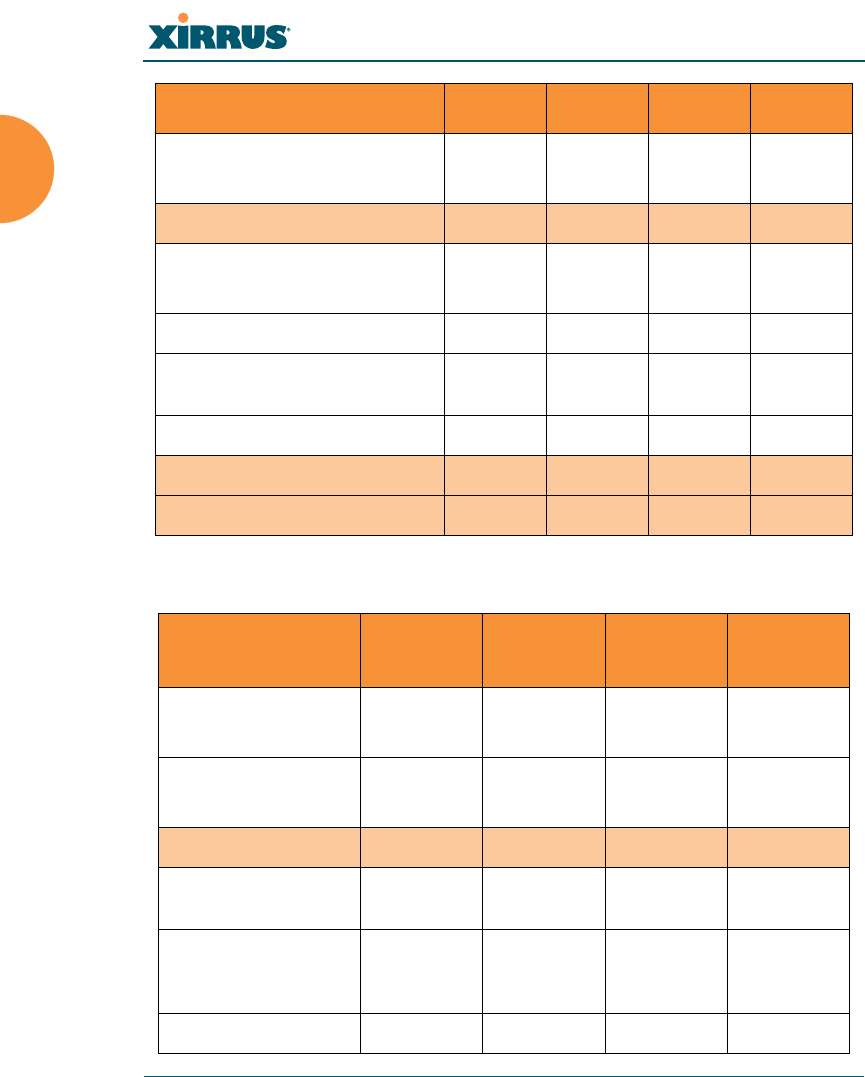
Wi-Fi Array
10 Introduction
XS Family of Arrays
Number of
802.11a/n radios 12840
Total radios 16 12 8 4
Number of
integrated antennas 48 36 24 12
Integrated Wi-Fi switch ports 16 12 8 4
Integrated RF spectrum
analyzer, threat sensors Yes Yes Yes Yes
Uplink Ports 2221
Wi-Fi bandwidth 4.8 Gbps 3.6 Gbps 2.4 Gbps 1.2 Gbps
Users supported 1,024 768 512 256
Feature XS16,
XS-3900 XS12 XS8,
XS-3700
XS4,
XS-3500
Number of
802.11a/b/g radios 4444
Number of
802.11a radios 12840
Total radios 16 12 8 4
Integrated Wi-Fi
switch ports 16 12 8 4
Integrated RF
spectrum analyzer
and threat sensors
Yes Yes Yes Yes
Uplink Ports 2221
Feature XN16 XN12 XN8 XN4
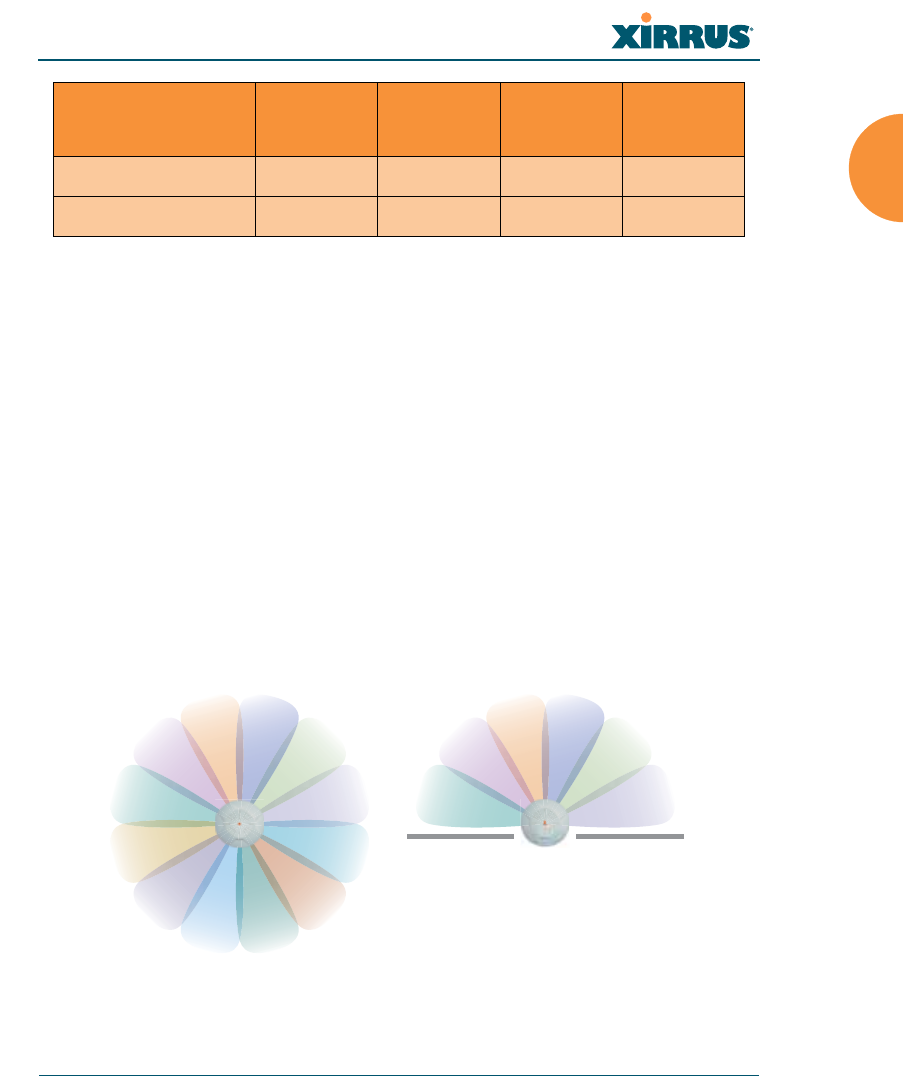
Wi-Fi Array
Introduction 11
See Also
Key Features and Benefits
Wi-Fi Array Product Overview
Product Specifications—XN16, XN12, and XN8
Product Specifications—XS4/XS-3500
Product Specifications—XS16/XS-3900, XS12, and XS8/XS-3700
Power over Gigabit Ethernet (PoGE) (Optional)
Why Choose the Xirrus Wi-Fi Array?
Deployment Flexibility
Xirrus’ unique multi-radio architecture generates 360 degrees of sectored high-
gain 802.11a/b/g/n or 802.11a/b/g coverage that provides extended range and
the highest possible data rates for a large volume of clients. Each sector can be
controlled automatically or manually, creating a pattern of wireless coverage
perfectly tailored to individual customer needs. For example:
Figure 4. Wireless Coverage Patterns
Figure 4 depicts the following two scenarios:
Wi-Fi bandwidth 864 864 432 216
Users supported 1,024 768 512 256
Feature XS16,
XS-3900 XS12 XS8,
XS-3700
XS4,
XS-3500
outside wall
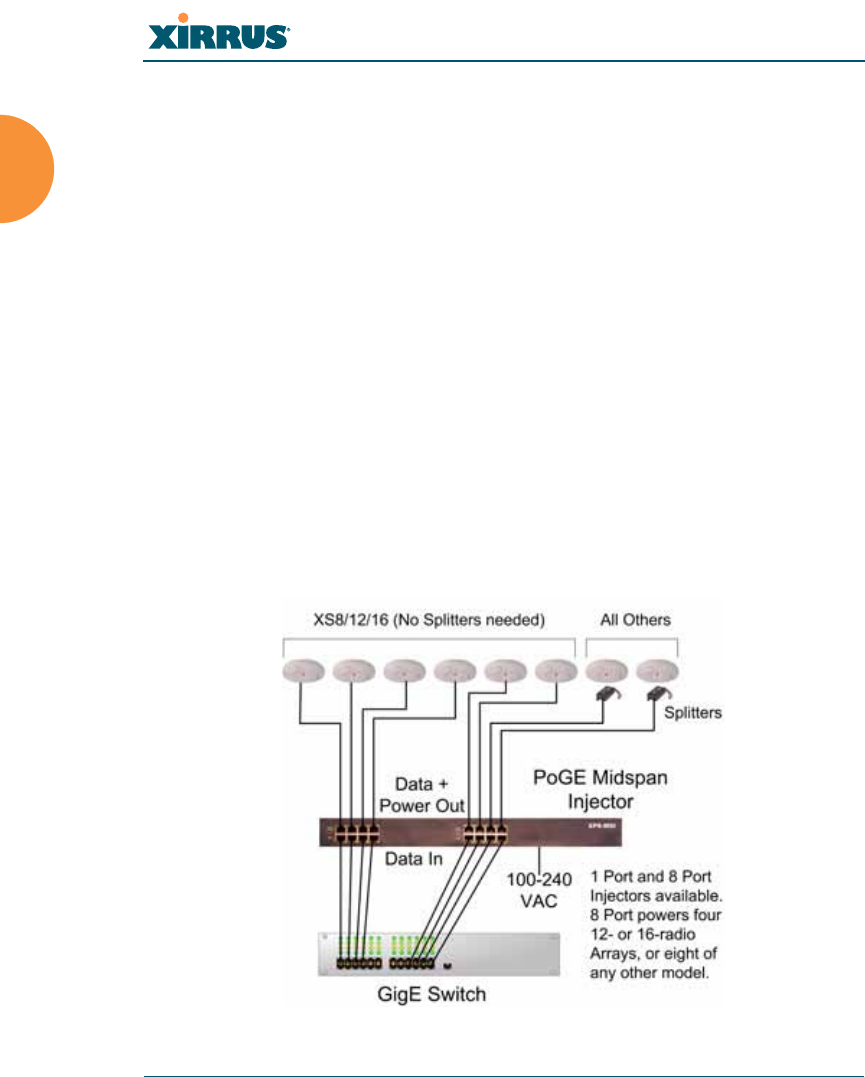
Wi-Fi Array
12 Introduction
zFull pattern coverage
All radios are activated with coverage spanning 360 degrees. If within
range, clients will always receive coverage regardless of their geographic
position relative to the Array.
zPartial pattern coverage
If desired, the Wi-Fi Array can be deployed close to an exterior wall. In
this case, half of all available radios have been deactivated to prevent
redundant signals from “bleeding” beyond the site’s perimeter wall. This
configuration may also be used in those cases where you want to restrict
wireless coverage to selected areas of the building’s interior.
See also, “Flexible Coverage Schemes” on page 18.
Power over Gigabit Ethernet (PoGE) (Optional)
The Xirrus XP1 and XP8 Power over Gigabit Ethernet modules provide power to
your Arrays over the same Cat 5e or Cat 6 cable used for data, eliminating the
need to run power cables and provide an AC power outlet in close proximity to
each unit.
Figure 5. XP8 - Power over Ethernet Usage

Wi-Fi Array
Introduction 13
Specific models of the Array are compatible with specific PoGE modules. For
details, please see “Power over Gigabit Ethernet Compatibility Matrix” on
page 416.
See Also
Key Features and Benefits
Wi-Fi Array Product Overview
Product Specifications—XN16, XN12, and XN8
Product Specifications—XS4/XS-3500
Product Specifications—XS16/XS-3900, XS12, and XS8/XS-3700
The Xirrus Family of Products
Why Choose the Xirrus Wi-Fi Array?
Enterprise Class Management
The Wi-Fi Array can be configured with its default RF settings, or the RF settings
can be customized using the Array’s embedded Web Management Interface
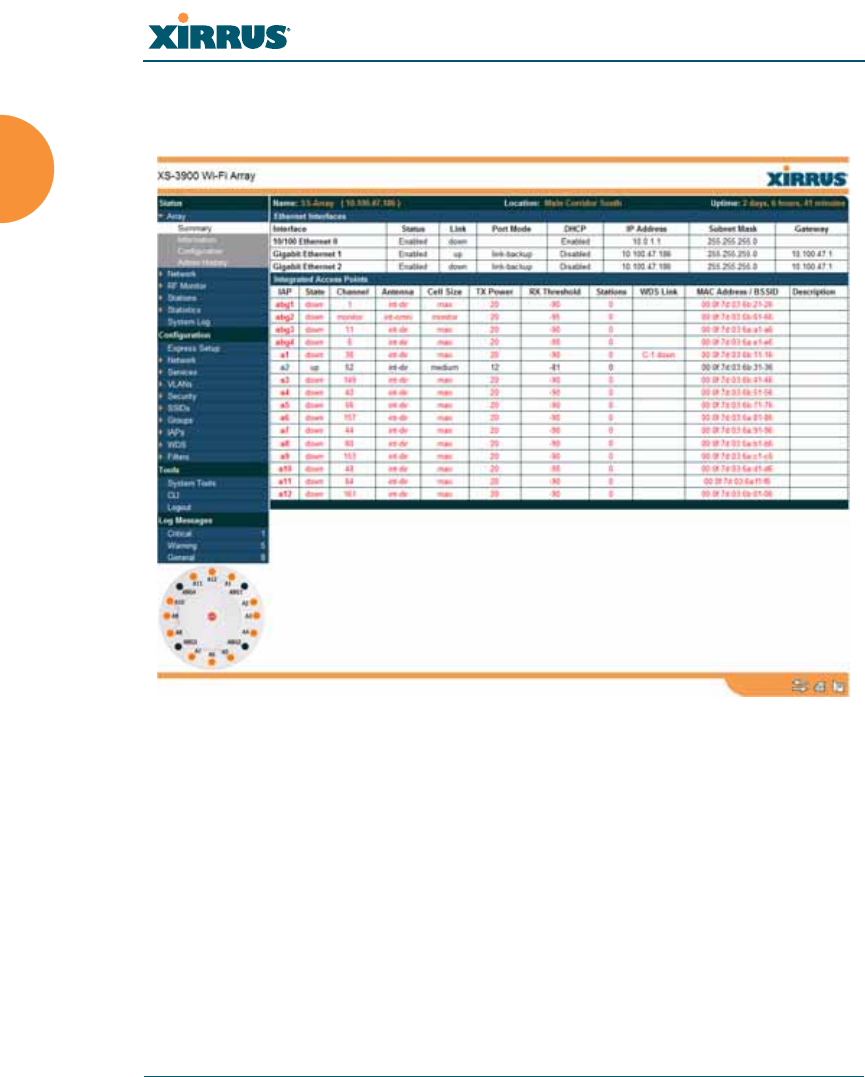
Wi-Fi Array
14 Introduction
(WMI). The WMI enables easy configuration and control from a graphical
console, along with a full compliment of troubleshooting tools and statistics.
Figure 6. WMI: Array Status
In addition, a fully featured Command Line Interface (CLI) offers IT professionals
a familiar management and control environment. SNMP (Simple Network
Management Protocol) is also supported to allow management from an SNMP
compliant management tool, such as the optional Xirrus Management System.
See Also
#For deployments of more than five Arrays, we recommend that you use the
Xirrus Management System (XMS). The XMS offers a rich set of features
for fine control over large deployments.

Wi-Fi Array
Introduction 15
Key Features and Benefits
Product Specifications—XS4/XS-3500
Product Specifications—XS4/XS-3500
Product Specifications—XS16/XS-3900, XS12, and XS8/XS-3700
Power over Gigabit Ethernet (PoGE) (Optional)
The Xirrus Family of Products
Why Choose the Xirrus Wi-Fi Array?
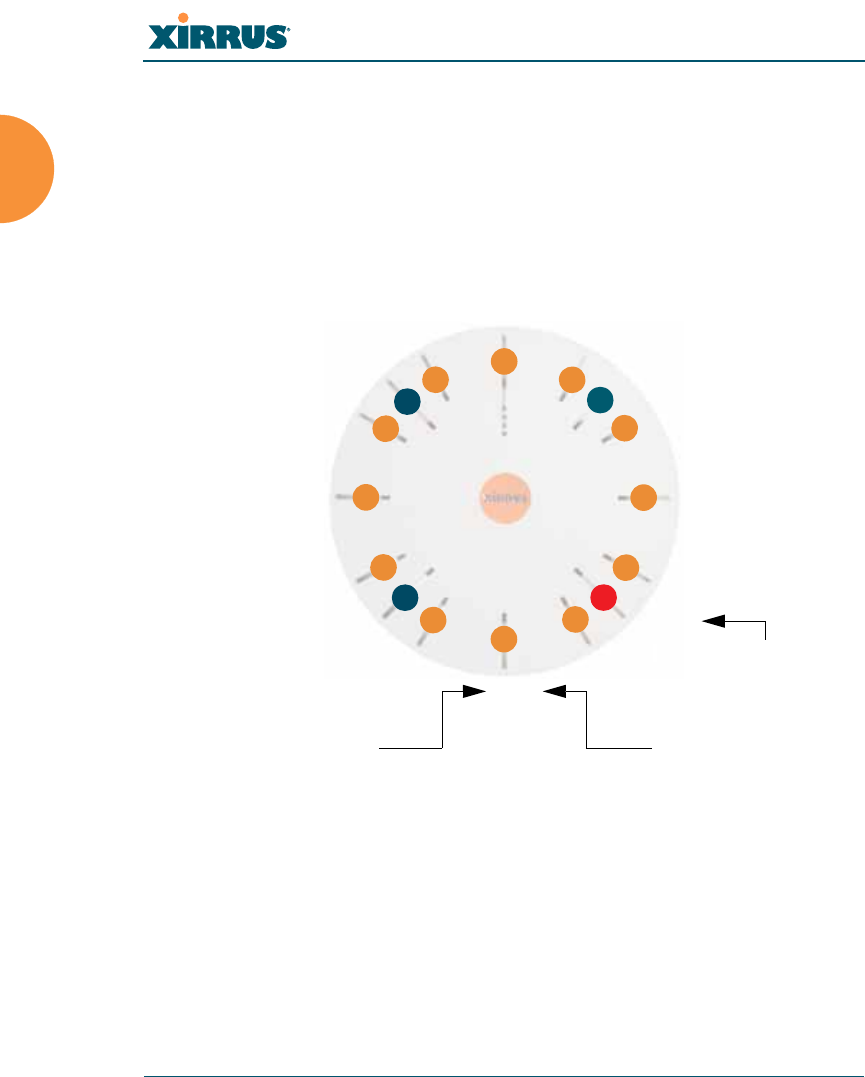
Wi-Fi Array
16 Introduction
Key Features and Benefits
This section describes some of the key product features and the benefits you can
expect when deploying the Wi-Fi Array (the XN16 product is highlighted in this
section).
High Capacity and High Performance
Figure 7. Layout of IAPs (XN16)
The XN16 version of the Wi-Fi Array (Figure 7) easily handles time-sensitive
traffic, such as voice, and can enable wireless connectivity for 1,024 users. The
unit includes two Gigabit uplink ports for connection to the wired network.
A total of sixteen IAPs provides a maximum wireless capacity of 4.8 Gbps, which
offers ample reserves for the high demands of current and future applications. Of
the sixteen IAPs, twelve operate in the 802.11a/n mode in the 5 GHz band, and
four operate in the 802.11a/b/g/n mode, providing backwards compatibility
with 802.11b and 802.11g in the 2.4 GHz band.
an1abgn1
an2
an3
an4
abgn2
an5
an6
an7
abgn3
an8
an9
an10
abgn4
an11 an12
Mode(s) IAP number
abgn2
(RF monitoring)
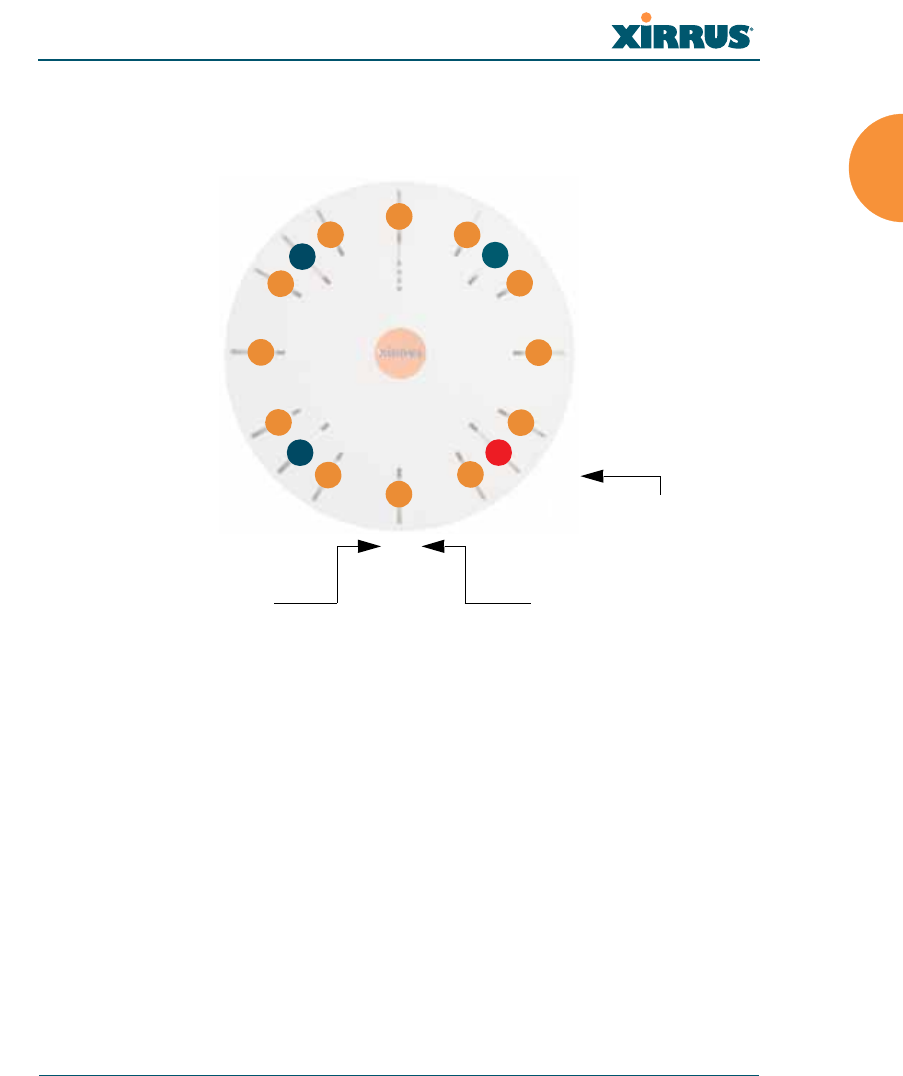
Wi-Fi Array
Introduction 17
In the recommended configuration, IAP (radio) abg(n)2 is configured in RF
monitoring and rogue AP detection mode.
Figure 8. Naming of IAPs (XS16)
Extended Coverage
One XN16 solution enables you to replace up to sixteen access points (includes
one omnidirectional IAP for monitoring the network). Fifteen IAP radios with
integrated directional antennas provide increased wireless range and enhanced
data rates in all directions. With a Wi-Fi Array deployed, far fewer access points
are needed and wired-like resiliency is delivered throughout your wireless
network. Your Wi-Fi Array deployment ensures:
zContinuous connectivity if an IAP (radio) fails.
zContinuous connectivity if an Array fails.
zContinuous connectivity if a WDS link or switch fails.
zContinuous connectivity if a Gigabit uplink or switch fails.
a1 abg1
a2
a3
a4
abg2
a5
a6
a7
abg3
a8
a9
a10
abg4 a11 a12
Mode(s) IAP number
abg2
(RF monitoring)

Wi-Fi Array
18 Introduction
Flexible Coverage Schemes
Your Wi-Fi Array offers flexible coverage schemes for each wireless technology.
Figure 9. Coverage Schemes
z802.11a/n, 802.11a
Delivers 60° wireless coverage per IAP, with 6 dBi of gain.
z802.11b/g/n, 802.11b/g
Delivers 180° wireless coverage, with 3 dBi of gain.
z802.11a/b/g/n, 802.11a/b/g (monitor only)
Delivers 360° wireless coverage, with 2 dBi of gain.
Non-Overlapping Channels
Complete use of non-overlapping channels limits interference and delivers
maximum capacity. On the XN16, up to 16 non-overlapping channels are fully
utilized across the 5GHz and 2.4GHz spectrums (up to 12 across the 5GHz
spectrum plus up to 3 across the 2.4 GHz spectrum—typically, one additional
radio is used as a dedicated RF monitor).
Secure Wireless Access
Multiple layers of authentication and encryption ensure secure data
transmissions. The Wi-Fi Array is 802.11i compliant with encryption support for
40 bit and 128 bit WEP, WPA and WPA2 with TKIP and AES encryption.
Authentication support is provided via 802.1x, including PEAP, EAP-TLS, EAP-
TTLS, and LEAP (Lightweight Extensible Authentication Protocol) passthrough.
802.11a/n
Monitor only
802.11a/b/g/n

Wi-Fi Array
Introduction 19
Applications Enablement
QoS (Quality of Service) functionality combined with true switch capabilities
enable high density video and Voice over Wireless LAN deployments. Compliant
with 802.1p and 802.1Q standards.
SDMA Optimization
SDMA (Spatial Division Multiple Access) technology provides full 360° coverage
while allowing independent channel and power output customization. Also
supports fast inter-zone handoffs for time-sensitive applications and roaming
support.
Fast Roaming
Utilizes the Xirrus Roaming Protocol (XRP) ensuring fast and seamless roaming
capabilities between IAPs or Arrays at both Layer 2 and Layer 3.
Easy Deployment
The Xirrus Management System (XMS) offers real time monitoring and
management capabilities of the wireless network—ideal for the Enterprise
market. It also allows you to import floor plans to help you plan your
deployment. The Xirrus Wi-Fi Array chassis has a plenum rated, lockable and
tamper resistant case.
See Also
Wi-Fi Array Product Overview
Product Specifications—XN16, XN12, and XN8
Product Specifications—XS4/XS-3500)
Product Specifications—XS16/XS-3900, XS12, and XS8/XS-3700
Power over Gigabit Ethernet (PoGE) (Optional)
The Xirrus Family of Products
Why Choose the Xirrus Wi-Fi Array?

Wi-Fi Array
20 Introduction
Product Specifications—XN16, XN12, and XN8
)
Element Specifications
Number of Users Maximum of 64 associated users per radio
XN16: 1024 users per Array
XN12: 768 users per Array
XN8: 512 users per Array
Physical Diameter: 18.65 inches (47.37 cm)
Height: 3.87 inches (9.83 cm)
Weight: 10 lbs (3.63 kg)
Environmental Operating Temperature:
0°C to 55°C
0% to 90% relative humidity (non-condensing)
Storage Temperature:
-20°C to 60°C
5% to 95% relative humidity (non-condensing)
System 1 GHz CPU (XN16/XN12/XN8)
1 GB RAM (XN16/XN12/XN8)
1 GB system flash
Integrated Switch 2.1 Gbps integrated wireless switch
Chassis Lockable mounting plate, Kensington lock slot

Wi-Fi Array
Introduction 21
Electrical Each Array supports both AC and PoGE
AC Input Power: 100-240VAC at 50-60 Hz
PoGE (DC) Input Power: Power over Gigabit
Ethernet—no splitter required, 48VDC,
Maximum 2A
Nominal Power:
XN16: 100W
XN12: 90W
XN8: 75W
All Models:
For PoGE, see “Power over Gigabit Ethernet
Compatibility Matrix” on page 416.
Interfaces Serial Console Port:
1 x RS232 – RJ45 connector, for local
configuration
Ethernet Interfaces:
2 x Gigabit 100/1000 Mbps uplink ports for link
aggregation, redundancy, or bridging
1 x Fast Ethernet 10/100 Mbps, for out of band
management
Status LEDs:
System status, Ethernet, Radio
Networking DHCP client, DHCP server (multiple DHCP
pools), DNS Client, NTP client, NAT
Element Specifications

Wi-Fi Array
22 Introduction
Management Xirrus Management System (XMS)—Layer 3
Element Management System
HTTPS Web Management Interface (WMI)
CLI via SSHv2, Telnet, local serial Console
Enable/disable management for any interface
Read-write and read-only admin accounts may
be authenticated via RADIUS
SNMP v1, v2c, v3
Configuration Files—text-based files may be
imported, exported, or compared
NetFlow—IP flow information (traffic statistics
may be sent to an external Collector
FTP, TFTP
Syslog reporting for alerts/alarms—messages
may be stored on internal Syslog server or sent to
up to three external syslog servers.
Cisco Discovery Protocol (CDP)—obtain protocol
addresses and platform information for
neighboring devices
Quality of Service
(QoS) Support Multiple SSIDs:
16 unique SSIDs per Array
Each SSID beacons a unique BSSID per radio
VLAN and QoS settings for each SSID
VLANs:
Up to 16 VLANs, 802.1Q, 802.1p
Prioritization:
802.11e wireless prioritization
802.1p wired prioritization
Fair queuing of downstream traffic
Wireless Voice Support:
Spectralink Voice Priority (SVP) protocol
Element Specifications

Wi-Fi Array
Introduction 23
Security Wireless Encryption
Line speed, hardware-accelerated encryption
modes:
WPA TKIP
WPA2 AES
WEP 40/64
WEP 104/128
Wireless Authentication:
Open
Pre-shared Key
802.1X EAP
PEAP
EAP-TLS
EAP-TTLS
EAP-LEAP Pass-through
Web Page Redirect (Captive Portal)
MAC Address Access Control List (ACL)
Firewall:
Integrated stateful-inspection, rules-based
firewall
IDS/IPS:
Integrates with Xirrus XDM Intrusion Detection/
Prevention System for real-time wireless security
protection
Rogue AP detection and blocking:
Integrated Rogue AP detection and alerting via
dedicated internal RF Threat Sensor. Rogue AP
can be shielded
Integrated RADIUS Server:
Integrated 802.1x Authentication Server
supporting EAP-PEAP
Element Specifications

Wi-Fi Array
24 Introduction
Security
(continued) Time of Day Access:
Specify when SSID access is allowed
Station-Station Blocking:
Station-to-Station traffic blocking option
Wireless Wireless Standards:
802.11a
802.11b
802.11d
802.11g
802.11e
802.11h
802.11i
802.11j
802.11n
Number of Radios:
XN16: 12 x 802.11a/n radios
4 x 802.11b/g/n radios
Only 12 radios should be used as 802.11a/n
radios (i.e., 5 GHz band) concurrently.
48 integrated antennas
XN12: 8 x 802.11a/n radios
4 x 802.11a/b/g/n radios
36 integrated antennas
XN8: 4 x 802.11a/n radios
4 x 802.11a/b/g/n radios
24 integrated antennas
Spectrum Analyzer:
1 integrated into Array
Element Specifications

Wi-Fi Array
Introduction 25
Wireless
(continued) Frequency Bands:
11a/n: 4.945 – 4.985 (restricted Public Safety
band)
11a/n: 5.15-5.25 GHz (UNII 1)
11a/n: 5.15-5.25 GHz (TELEC)
11a/n: 5.25-5.35 GHz (UNII 2)
11a/n: 5.470-5.725 (ETSI)
11a/n: 5.725-5.825 GHz (UNII 3)
11b/g/n: 2.412-2.462 GHz (FCC)
11b/g/n: 2.412-2.472 GHz (ETSI)
11b/g/n: 2.412-2.484 GHz (TELEC)
Channel Selection:
Manual and Automatic
802.11a/n Antennas
Integrated 6dBi, sectorized
802.11b/g/n Antennas
Integrated 3dBi, sectorized
Wi-Fi Monitoring:
1 Integrated Access Point can be set as a
dedicated Wi-Fi Threat Sensor
2 dBi 360° omni-directional antenna
802.11a/b/g/n External Antenna Connectors:
3 RP-TNC connectors
Performance Client Load Balancing
Automatic load balancing between system radios
Element Specifications

Wi-Fi Array
26 Introduction
See Also
Key Features and Benefits
Wi-Fi Array Product Overview
Product Specifications—XN4 xxxx
Product Specifications—XS16/XS-3900, XS12, and XS8/XS-3700
Product Specifications—XS4/XS-3500
Power over Gigabit Ethernet (PoGE) (Optional)
The Xirrus Family of Products
Why Choose the Xirrus Wi-Fi Array?
xxxxx
Compliance Electromagnetic:
ICES-003 (Canada)
EN 301.893 (Europe)
EN 301.489-1 and -17 (Europe)
Safety:
EN 60950
EN 50371 to 50385
CE Mark
Certifications Wi-Fi Alliance: 802.11a/b/g, WPA, WPA2, and
extended EAP types. Our certifications may be
viewed here.
Spectralink (Polycom) VIEW - operation with
Spectralink Wi-Fi phones. Our certification may
be viewed here.
Warranty Hardware:
Five Year Standard (extendable)
Software:
90 Days Standard (extendable)
Element Specifications

Wi-Fi Array
Introduction 27
Product Specifications—XN4 xxxx
)
Element Specifications
Number of Users Maximum of 64 associated users per radio
XN4: 256 users per Array
Physical Diameter: 12.58 inches (31.95 cm)
Height: 2.58 inches (6.55 cm)
Weight: 4lbs (1.81 kg)
Environmental Operating Temperature:
0°C to 55°C
0% to 90% relative humidity (non-condensing)
Storage Temperature:
-20°C to 60°C
5% to 95% relative humidity (non-condensing)
System 1 GHz CPU
512 MB RAM
1 GB system flash
Integrated Switch 2.1 Gbps integrated wireless switch
Chassis Lockable mounting plate, Kensington lock slot
Electrical XN4 supports Power over Gigabit Ethernet
(PoGE) only, no splitter required
PoGE (DC) Input Power: 48VDC, Maximum 2A
Nominal Power: 60 W
For PoGE, see “Power over Gigabit Ethernet
Compatibility Matrix” on page 416.

Wi-Fi Array
28 Introduction
Interfaces Serial Console Port:
1 x RS232 – RJ45 connector, for local
configuration
Ethernet Interfaces:
1 x Gigabit 100/1000 Mbps uplink port
Status LEDs:
System status, Ethernet, Radio
Networking DHCP client, DHCP server (multiple DHCP
pools), DNS Client, NTP client, NAT
Management Xirrus Management System (XMS)—Layer 3
Element Management System
HTTPS Web Management Interface (WMI)
CLI via SSHv2, Telnet, local serial Console
Enable/disable management for any interface
Read-write and read-only admin accounts may
be authenticated via RADIUS
SNMP v1, v2c, v3
Configuration Files—text-based files may be
imported, exported, or compared
NetFlow—IP flow information (traffic statistics
may be sent to an external Collector
FTP, TFTP
Syslog reporting for alerts/alarms—messages
may be stored on internal Syslog server or sent to
up to three external syslog servers.
Cisco Discovery Protocol (CDP)—obtain protocol
addresses and platform information for
neighboring devices
Element Specifications

Wi-Fi Array
Introduction 29
Quality of Service
(QoS) Support Multiple SSIDs:
16 unique SSIDs per Array
Each SSID beacons a unique BSSID per radio
VLAN and QoS settings for each SSID
VLANs:
Up to 16 VLANs, 802.1Q, 802.1p
Prioritization:
802.11e wireless prioritization
802.1p wired prioritization
Fair queuing of downstream traffic
Wireless Voice Support:
Spectralink Voice Priority (SVP) protocol
Element Specifications

Wi-Fi Array
30 Introduction
Security Wireless Encryption
Line speed, hardware-accelerated encryption
modes:
WPA TKIP
WPA2 AES
WEP 40/64
WEP 104/128
Wireless Authentication:
Open
Pre-shared Key
802.1X EAP
PEAP
EAP-TLS
EAP-TTLS
EAP-LEAP Pass-through
Web Page Redirect (Captive Portal)
MAC Address Access Control List (ACL)
Firewall:
Integrated stateful-inspection, rules-based
firewall
IDS/IPS:
Integrates with Xirrus XDM Intrusion Detection/
Prevention System for real-time wireless security
protection
Rogue AP detection and blocking:
Integrated Rogue AP detection and alerting via
dedicated internal RF Threat Sensor. Rogue AP
can be shielded
Integrated RADIUS Server:
Integrated 802.1x Authentication Server
supporting EAP-PEAP
Element Specifications

Wi-Fi Array
Introduction 31
Security
(continued) Time of Day Access:
Specify when SSID access is allowed
Station-Station Blocking:
Station-to-Station traffic blocking option
Wireless Wireless Standards:
802.11a
802.11b
802.11d
802.11g
802.11e
802.11h
802.11i
802.11j
802.11n
Number of Radios:
XN4: 4 x 802.11a/b/g/n radios
12 integrated antennas
Spectrum Analyzer:
1 integrated into Array
Element Specifications

Wi-Fi Array
32 Introduction
Wireless
(continued) Frequency Bands:
11a/n: 4.945 – 4.985 (restricted Public Safety
band)
11a/n: 5.15-5.25 GHz (UNII 1)
11a/n: 5.15-5.25 GHz (TELEC)
11a/n: 5.25-5.35 GHz (UNII 2)
11a/n: 5.470-5.725 (ETSI)
11a/n: 5.725-5.825 GHz (UNII 3)
11b/g/n: 2.412-2.462 GHz (FCC)
11b/g/n: 2.412-2.472 GHz (ETSI)
11b/g/n: 2.412-2.484 GHz (TELEC)
Channel Selection:
Manual and Automatic
802.11a/n Antennas
Integrated 6dBi, sectorized
802.11b/g/n Antennas
Integrated 3dBi, sectorized
Wi-Fi Monitoring:
1 Integrated Access Point can be set as a
dedicated Wi-Fi Threat Sensor
2 dBi 360° omni-directional antenna
802.11a/b/g/n External Antenna Connectors:
1 RP-TNC connector
Performance Client Load Balancing
Automatic load balancing between system radios
Element Specifications

Wi-Fi Array
Introduction 33
See Also
Key Features and Benefits
Wi-Fi Array Product Overview
Product Specifications—XN16, XN12, and XN8
Product Specifications—XS16/XS-3900, XS12, and XS8/XS-3700
Product Specifications—XS4/XS-3500
Power over Gigabit Ethernet (PoGE) (Optional)
The Xirrus Family of Products
Why Choose the Xirrus Wi-Fi Array?
Compliance Electromagnetic:
ICES-003 (Canada)
EN 301.893 (Europe)
EN 301.489-1 and -17 (Europe)
Safety:
EN 60950
EN 50371 to 50385
CE Mark
Certifications Wi-Fi Alliance: 802.11a/b/g, WPA, WPA2, and
extended EAP types. Our certifications may be
viewed here.
Spectralink (Polycom) VIEW - operation with
Spectralink Wi-Fi phones. Our certification may
be viewed here.
Warranty Hardware:
Five Year Standard (extendable)
Software:
90 Days Standard (extendable)
Element Specifications

Wi-Fi Array
34 Introduction
Product Specifications—XS16/XS-3900, XS12, and
XS8/XS-3700
Element Specifications
Number of Users Maximum of 64 associated users per radio
1024 users per Array (XS16/XS-3900)
768 users per Array (XS12)
512 users per Array (XS8/XS-3700)
Physical Diameter: 18.65 inches (47.37 cm)
Height: 3.87 inches (9.83 cm)
Weight: 8lbs (3.63 kg)
Environmental Operating Temperature:
-10°C to 50°C
0% to 90% relative humidity (non-condensing)
Storage Temperature:
-20°C to 60°C
5% to 95% relative humidity (non-condensing)
System XS16/XS12/XS8:
1 GHz CPU
1 GB RAM
1 GB system flash
Expansion slot for future options
XS-3900/XS-3700:
825 MHz CPU
512 MB RAM (XS-3900/XS-3700)
512 MB system flash
Expansion slot for future options

Wi-Fi Array
Introduction 35
Interfaces Serial:
1 x RS232 – RJ45 connector
Ethernet Interfaces:
2 x Gigabit 100/1000 Mbps w/failover
1 x Fast Ethernet 10/100 Mbps
Status LEDs:
System status, Ethernet, Radio
Electrical XS16/XS12/XS8:
Each Array supports both AC and PoGE
AC Input Power: 90-265VAC at 47-63Hz
PoGE Input Power: Power over Gigabit
Ethernet—no splitter required, 48VDC
XS-3900/XS-3700:
Separate AC and DC versions
Input Power (AC version): 90VAC to 265VAC at
47Hz to 63Hz
Input Power (DC version): 48VDC
PoGE: requires modified DC version and
splitter.
All Models:
For PoGE, see “Power over Gigabit Ethernet
Compatibility Matrix” on page 416.
Networking DHCP client, DHCP server, NTP client, NAT
VLAN Support 802.1Q, 802.1p VLAN
Supports up to 16 VLANs
Multiple SSID
Support Allows up to 16 separate SSIDs to be defined
with map security, VLAN and QoS settings for
each SSID
Element Specifications

Wi-Fi Array
36 Introduction
Performance Client Load Balancing
Automatic load balancing between system
radios
Quality of Service:
802.1p wired traffic prioritization
Wireless packet prioritization
MAP CoS to TCID
Fair queuing of downstream traffic
Security Wireless Security:
WEP 40bit/128bit encryption
WPA and WPA2 with TKIP and AES encryption
Rogue AP detection, with alerts and
classification
User and System Authentication:
WPA and WPA2 Pre-Shared Key authentication
Internal RADIUS Server, supports EAP-PEAP
only
802.1x EAP-TLS
802.1x EAP-TTLS/MSCHAPv2
802.1x PEAPv0/EAP-MSCHAPv2
802.1x PEAPv1/EAP-GTC
802.1x EAP-SIM
802.1x EAP-LEAP Passthrough
External RADIUS servers
Authentication of Wi-Fi Arrays to the Xirrus
Management System (XMS)
Element Specifications

Wi-Fi Array
Introduction 37
Wireless Number of Radios:
XS16/XS-3900: 12 x 802.11a radios
4 x 802.11a/b/g radios
Only 12 radios should be used as 802.11a
radios concurrently.
XS12: 8 x 802.11a radios
4 x 802.11a/b/g radios
XS8/XS-3700: 4 x 802.11a radios
4 x 802.11a/b/g radios
Wireless Standards:
802.11a/b/g and g-only mode
802.11e, 802.11i
Channel Selection:
Manual and Automatic
Frequency Bands:
11a: 4.945 – 4.985 (restricted Public Safety band)
11a: 5.15-5.25 GHz (UNII 1)
11a: 5.15-5.25 GHz (TELEC)
11a: 5.25-5.35 GHz (UNII 2)
11a: 5.470-5.725 (ETSI)
11a: 5.725-5825 GHz (UNII 3)
11b/g: 2.412-2.462 GHz (FCC)
11b/g: 2.412-2.472 GHz (ETSI)
11b/g: 2.412-2.484 GHz (TELEC)
Antennas (XS16/XS-3900):
12 x internal 6 dBi 60° 802.11a sectorized
4 x internal 3 dBi 180° 802.11b/g sectorized
1 x internal 2 dBi 360° omni-directional (for RF
monitoring)
3 x external RP-TNC connectors for three
802.11a/b/g radios
Element Specifications

Wi-Fi Array
38 Introduction
Wireless
(continued) Antennas (XS12):
8 x internal 6 dBi 60° 802.11a sectorized
4 x internal 3 dBi 180° 802.11b/g sectorized
1 x internal 2 dBi 360° omni-directional (for RF
monitoring)
3 x external RP-TNC connectors for three
802.11a/b/g radios
Antennas (XS8/XS-3700):
4 x internal 6 dBi 60° 802.11a sectorized
4x internal 3 dBi 180° 802.11b/g sectorized
1 x internal 2 dBi 360° omni-directional (for RF
monitoring)
3 x external RP-TNC connectors for three
802.11a/b/g radios
Radio Approvals:
FCC (United States) and EN 301.893 (Europe)
Management Web-based HTTPS
SNMP v2, v3
CLI via SSHv2 or Telnet
FTP
TFTP
Serial
Xirrus Management System (XMS)
Syslog reporting for alerts/alarms
Compliance UL / cUL 60950 and EN 60950
FCC Part 15.107 and 15109, Class A
EN 301.489 (Europe)
EN60601 EU medical equipment directive for
EMC
Element Specifications

Wi-Fi Array
Introduction 39
See Also
Key Features and Benefits
Wi-Fi Array Product Overview
Product Specifications—XN4 xxxx
Product Specifications—XN16, XN12, and XN8
Product Specifications—XS4/XS-3500
Power over Gigabit Ethernet (PoGE) (Optional)
The Xirrus Family of Products
Why Choose the Xirrus Wi-Fi Array?
Product Specifications—XS4/XS-3500
Certifications Wi-Fi Alliance: 802.11a/b/g, WPA, WPA2, and
extended EAP types. Our certifications may be
viewed here.
Spectralink (Polycom) VIEW - operation with
Spectralink Wi-Fi phones. Our certification may
be viewed here.
Federal Information Processing Standard (FIPS)
Publication 140 -2, Level 2.
Warranty One year (hardware and software)
Element Specifications
Number of Users Maximum of 64 associated users per radio (256
users per Array)
Physical Diameter: 12.58 inches (31.95 cm)
Height: 2.58 inches (6.55 cm)
Weight: 4lbs (1.81 kg)
Element Specifications

Wi-Fi Array
40 Introduction
Environmental Operating Temperature:
-10°C to 50°C
0% to 90% relative humidity (non-condensing)
Storage Temperature:
-20°C to 60°C
5% to 95% relative humidity (non-condensing)
System 825 MHz CPU (XS4)
666 MHz CPU (XS-3500)
512 MB RAM, expandable (XS4)
256 MB RAM, expandable (XS-3500)
512 MB system flash, expandable
Expansion slot for future options
Electrical XS4:
Each Array supports both AC and PoGE
AC Input Power: 90-265VAC at 47-63Hz
XS-3500:
AC Input Power: 90-265VAC at 47-63Hz
Input Power (DC version): 48VDC
All Models:
Power over Gigabit Ethernet (PoGE): all 4-port
models work with all Xirrus PoGE modules,
splitter required, 48VDC
See “Power over Gigabit Ethernet
Compatibility Matrix” on page 416.
Element Specifications

Wi-Fi Array
Introduction 41
Interfaces Serial:
1 x RS232 – RJ45 connector
Ethernet Interfaces:
1 x Gigabit 100/1000 Mbps
Status LEDs:
System status, Ethernet, Radio
Management Web-based HTTPS
SNMP v2, v3
CLI via SSHv2 or Telnet
FTP
TFTP
Serial
Xirrus Management System (XMS)
Syslog reporting for alerts/alarms
Networking DHCP client, DHCP server, NTP client, NAT
VLAN Support 802.1Q, 802.1p VLAN
Supports up to 16 VLANs
Multiple SSID
Support Allows up to 16 separate SSIDs to be defined
with map security, VLAN and QoS settings for
each SSID
Performance Client Load Balancing
Automatic load balancing between system
radios
Quality of Service:
802.1p wired traffic prioritization
Wireless packet prioritization
MAP CoS to TCID
Fair queuing of downstream traffic
Element Specifications

Wi-Fi Array
42 Introduction
Security Wireless Security:
WEP 40bit/128bit encryption
WPA and WPA2 with TKIP and AES encryption
Rogue AP detection, with alerts and
classification
User and System Authentication:
WPA Pre-Shared Key authentication
Internal RADIUS Server, supports EAP-PEAP
only
802.1x EAP-TLS
802.1x EAP-TTLS/MSCHAPv2
802.1x PEAPv0/EAP-MSCHAPv2
802.1x PEAPv1/EAP-GTC
802.1x EAP-SIM
802.1x EAP-LEAP Passthrough
External RADIUS servers
Authentication of Wi-Fi Arrays to the Xirrus
Management System (XMS)
Element Specifications

Wi-Fi Array
Introduction 43
Wireless Number of Radios:
4 x 802.11a/b/g radios
Wireless Standards:
802.11a/b/g and g-only mode
802.11e, 802.11i
Channel Selection:
Manual and Automatic
Frequency Bands:
11a: 4.945 – 4.985 (restricted Public Safety band)
11a: 5.15-5.25 GHz (UNII 1)
11a: 5.15-5.25 GHz (TELEC)
11a: 5.25-5.35 GHz (UNII 2)
11a: 5.470-5.725 (ETSI)
11a: 5.725-5825 GHz (UNII 3)
11b/g: 2.412-2.462 GHz (FCC)
11b/g: 2.412-2.472 GHz (ETSI)
11b/g: 2.412-2.484 GHz (TELEC)
Antennas (XS-3500):
4 x internal 3 dBi 180° 802.11b/g sectorized
1 x internal 2 dBi 360° omni-directional (for RF
monitoring)
1 x external RP-TNC connector for one 802.11a/
b/g radio
Radio Approvals:
FCC (United States) and EN 301.893 (Europe)
Compliance UL / cUL 60950 and EN 60950
FCC Part 15.107 and 15109, Class A
EN 301.489 (Europe)
EN60601 EU medical equipment directive for
EMC
Element Specifications

Wi-Fi Array
44 Introduction
See Also
Key Features and Benefits
Wi-Fi Array Product Overview
Product Specifications—XN16, XN12, and XN8
Product Specifications—XN4 xxxx
Product Specifications—XS16/XS-3900, XS12, and XS8/XS-3700
Power over Gigabit Ethernet (PoGE) (Optional)
The Xirrus Family of Products
Why Choose the Xirrus Wi-Fi Array?
Certifications Wi-Fi Alliance: 802.11a/b/g, WPA, WPA2, and
extended EAP types. Our certifications may be
viewed here.
Spectralink (Polycom) VIEW - operation with
Spectralink Wi-Fi phones. Our certification may
be viewed here.
Federal Information Processing Standard (FIPS)
Publication 140 -2, Level 2.
Warranty One year (hardware and software)
Element Specifications

Wi-Fi Array
Installing the Wi-Fi Array 45
Installing the Wi-Fi Array
The instructions for completing a successful installation include the following
topics:
z“Installation Prerequisites” on page 45.
z“Planning Your Installation” on page 48.
z“Installation Workflow” on page 80.
z“Unpacking the Wi-Fi Array” on page 81.
z“Installing Your Wi-Fi Array” on page 83.
z“Powering Up the Wi-Fi Array” on page 107.
z“Establishing Communication with the Array” on page 110.
z“Performing the Express Setup Procedure” on page 112.
Installation Prerequisites
Your Wi-Fi Array deployment requires the presence of hardware and services in
the host wired/wireless network, including:
zPower Source
Most Arrays are powered via Xirrus Power over Gigabit Ethernet. PoGE
supplies power over the same Cat 5e or Cat 6 cable used for data, thus
reducing cabling and installation effort. PoGE power injector modules are
available in 1 port and 8 port configurations and are typically placed near
your Gigabit Ethernet switch. An AC outlet is required for each injector
module. Current Array models have integrated splitters, so no separate
splitter is required.
Specific models of the Array are compatible with specific PoGE modules.
For details, please see “Power over Gigabit Ethernet Compatibility
Matrix” on page 416.
If your Arrays are equipped to accept AC power (and you are not using
PoGE), you need a dedicated power outlet to supply AC power to each
unit deployed at the site.

Wi-Fi Array
46 Installing the Wi-Fi Array
zEthernet port
You need at least one 100/1000 BaseT port to establish wired Gigabit
Ethernet connectivity (via the product’s Gigabit 1 or Gigabit 2 port) and
one 10/100 BaseT port (if desired) for product management.
zSecure Shell (SSH) utility
To establish secure remote command line access to the Array, you need a
Secure Shell (SSH) utility, such as PuTTY. The utility must be configured
to use SSH-2, since the Array will only allow SSH-2 connections.
zSecure Web browser
Either Internet Explorer (version 6.0 or higher), Netscape Navigator
(version 7.0 or higher), or Mozilla Firefox (version 1.01 or higher).
A secure Web browser is required for Web-based management of the
Array. The browser must be on the same subnet as the Array, or you must
set a static route for management as described in the warning above.
zSerial connection capability
To connect directly to the console port on the Array, your computer must
be equipped with a male 9-pin serial port and terminal emulation
software (for example, HyperTerminal). The Xirrus Array only supports
serial cable lengths up to 25’ per the RS-232 specification.
!The Array’s Ethernet ports should be connected to an Ethernet switch, not
an Ethernet hub—if a hub is used, we recommend that you connect only
one Ethernet port.
!The Gigabit1 Ethernet interface is the primary port for both data and
management traffic. If a single Ethernet connection is used, it must be
connected to the Gigabit1 Ethernet interface. See also, “Port Failover
Protection” on page 67.
The 10/100 Ethernet Port may be used for managing the Array out of
band from the Gigabit Ethernet ports. The 10/100 port will route only
management traffic, using a static route that may be configured for this
interface. See “interface” on page 336.

Wi-Fi Array
Installing the Wi-Fi Array 47
Use the following settings when establishing a serial connection:
Optional Network Components
The following network components are optional.
zXirrus Management System (XMS)
The optional XMS offers powerful management features for small or large
Wi-Fi Array deployments.
zExternal RADIUS server
Although your Array comes with an embedded RADIUS server, for
802.1x authentication in large deployments you may want to add an
external RADIUS server.
Client Requirements
The Wi-Fi Array should only be used with Wi-Fi certified client devices.
See Also
Coverage and Capacity Planning
Deployment Examples
Failover Planning
Planning Your Installation
Bits per second 115,200
Data bits 8
Parity None
Stop bits 1
Flow control None

Wi-Fi Array
48 Installing the Wi-Fi Array
Planning Your Installation
This section provides guidelines and examples to help you plan your Xirrus Wi-Fi
Array deployment to achieve the best overall coverage and performance. We
recommend you conduct a site survey to determine the best location and settings
for each Array you install.
The following topics are discussed:
z“General Deployment Considerations” on page 48
z“Coverage and Capacity Planning” on page 50
z“IEEE 802.11n Deployment Considerations” on page 59
z“Failover Planning” on page 67
z“Power Planning” on page 69
z“Security Planning” on page 70
z“Port Requirements” on page 72
z“Network Management Planning” on page 75
z“WDS Planning” on page 76
z“Deployment Summary” on page 79
General Deployment Considerations
The Wi-Fi Array’s unique multi-radio architecture generates 360 degrees of
sectored high-gain 802.11a/b/g/n or 802.11a/b/g coverage that provides
extended range. However, the number, thickness and location of walls, ceilings or
other objects that the wireless signals must pass through may affect the range.
Typical ranges vary depending on the types of materials and background RF
(radio frequency) noise at your location. To maximize wireless range, follow these
basic guidelines:
1. Keep the number of walls and ceilings between the Array and your
receiving devices to a minimum—each wall or ceiling can reduce the
#For a complete discussion of implementing Voice over Wi-Fi on the Array,
see the Xirrus Voice over Wi-Fi Application Note in the Xirrus Library.
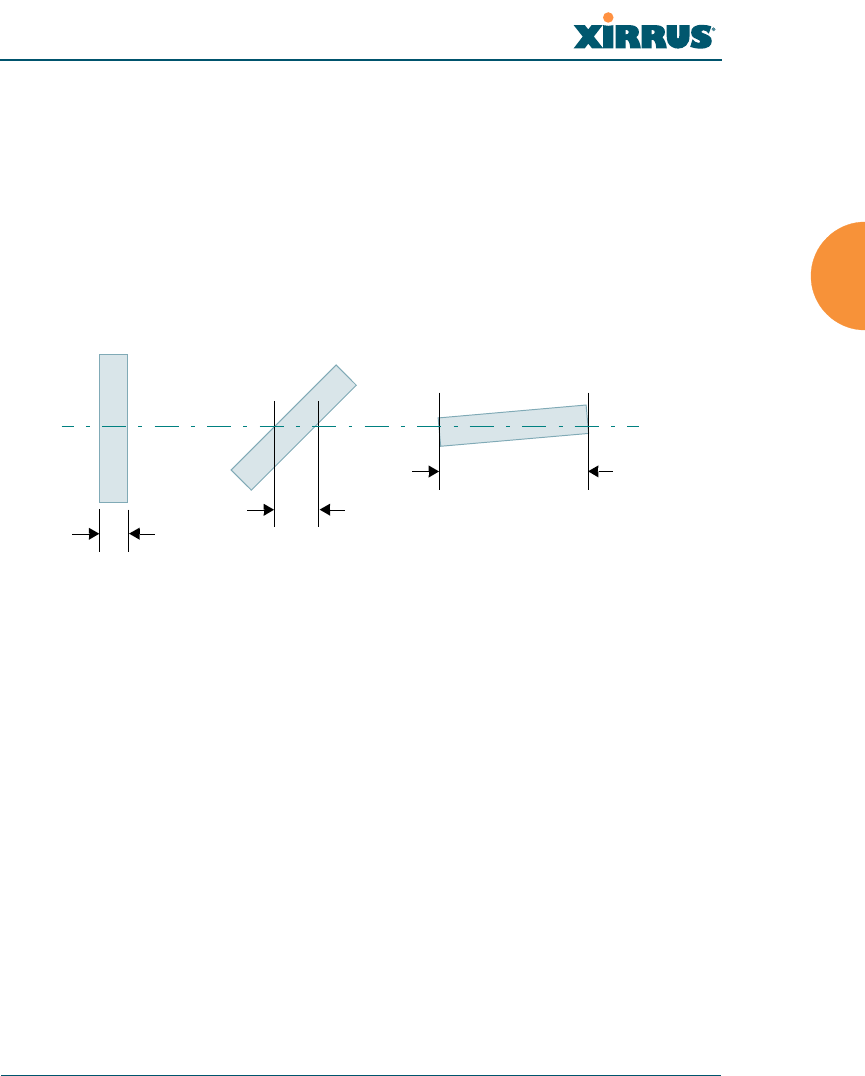
Wi-Fi Array
Installing the Wi-Fi Array 49
wireless range from between 3 and 90 feet (1 to 30 meters). Position your
devices so that the number of walls or ceilings is minimized.
2. Be aware of the direct line between each device. For example, a wall that
is 1.5 feet thick (half a meter) at 90° is actually almost 3 feet thick (or 1
meter) when viewed at a 45° angle. At an acute 2° degree angle the same
wall is over 42 feet (or 14 meters) thick! For best reception, try to ensure
that your wireless devices are positioned so that signals will travel
straight through a wall or ceiling.
Figure 10. Wall Thickness Considerations
3. Try to position wireless client devices so that the signal passes through
drywall (between studs) or open doorways and not other materials that
can adversely affect the wireless signal.
See Also
Coverage and Capacity Planning
Deployment Examples
Deployment Summary
Installation Prerequisites
90° 45°
1.5 feet/
.5 m ~ 3 feet/
1 m
> 42 feet\
14 m
2°
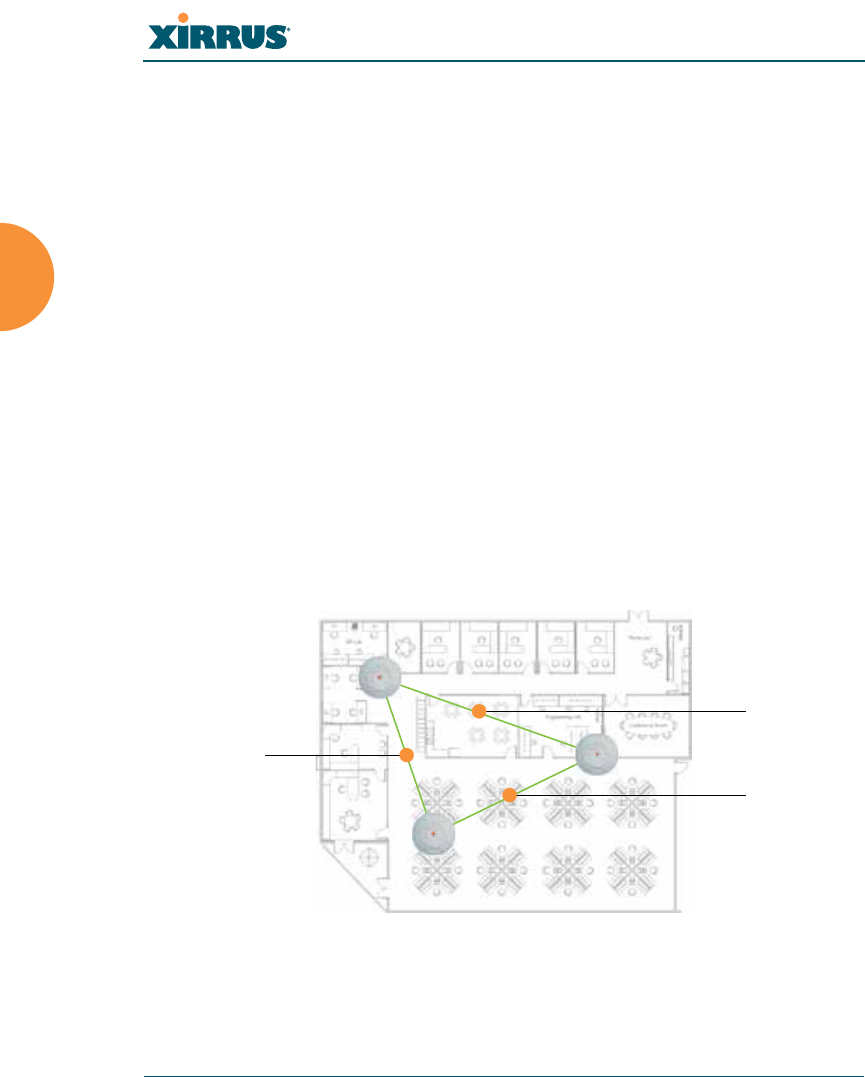
Wi-Fi Array
50 Installing the Wi-Fi Array
Coverage and Capacity Planning
This section considers coverage and capacity for your deployment(s), including
placement options, RF patterns and cell sizes, area calculations, roaming
considerations, and channel allocations.
Placement
Use the following guidelines when considering placement options:
1. The best placement option for the Array is ceiling-mounted within an
open plan environment (cubicles rather than fixed walls).
2. Keep the Array away from electrical devices or appliances that generate
RF noise. Because the Array is generally mounted on ceilings, be aware of
its position relative to lighting (especially fluorescent lighting)—we
recommend maintaining a distance of at least 3 to 6 feet (1 to 2 meters).
3. If using multiple Arrays in the same area, maintain a distance of at least
100 ft/30m between Arrays if there is direct line-of-sight between the
units, or at least 50 ft/15m if a wall or other barrier exists between the
units.
Figure 11. Unit Placement
100 ft/ 30m
100 ft/ 30 m
100 ft/
30 m

Wi-Fi Array
Installing the Wi-Fi Array 51
RF Patterns
The Wi-Fi Array allows you to control—automatically or manually—the pattern
of wireless coverage that best suits your deployment needs. You can choose to
operate with full coverage, half coverage, or custom coverage (by enabling or
disabling individual sectors).
Full (Normal) Coverage
In normal operation, the Array provides a full 360 degrees of coverage.
Figure 12. Full (Normal) Coverage
Half Coverage
If installing a unit close to an exterior wall, you can deactivate half of the radios to
prevent redundant signals from “bleeding” beyond the wall and extending
service into public areas. The same principle applies if you want to restrict service
to an adjacent room within the site.
Figure 13. Adjusting RF Patterns
outside wall
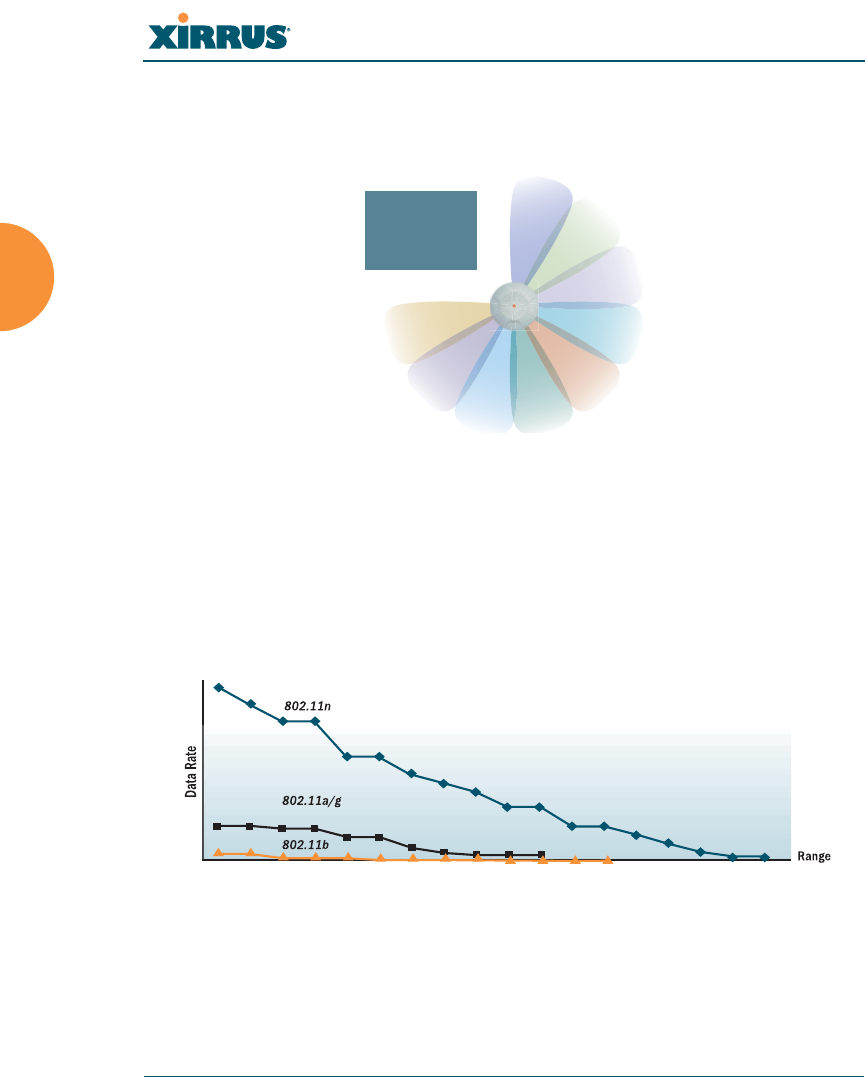
Wi-Fi Array
52 Installing the Wi-Fi Array
Custom Coverage
Where there are highly reflective objects in close proximity to the Array, you can
turn off specific radios to avoid interference and feedback.
Figure 14. Custom Coverage
Capacity and Cell Sizes
Cell sizes should be estimated based on the number of users, the applications
being used (for example, data/video/voice), and the number of Arrays available
at the location. The capacity of a cell is defined as the minimum data rate desired
for each sector multiplied by the total number of sectors being used.
Figure 15. Connection Rate vs. Distance
Figure 15 shows relative connection rates for 802.11n vs. 802.11a/g and 802.11b,
and the effect of distance on the connection rates. Wireless environments can vary
greatly so the actual rates may be different depending on the specific network
deployment.
object
reflective

Wi-Fi Array
Installing the Wi-Fi Array 53
Fine Tuning Cell Sizes
Adjusting the transmit power allows you to fine tune cell sizes. There are four
standard sizes—Small, Medium, Large, or Max (the default is Max). There is also
an Auto setting that automatically determines the best cell size, and a Manual
setting that allows you to choose your power settings directly.
Figure 16. Transmit Power
Auto Cell Size is an automatic, self-tuning mechanism that balances cell size
between Arrays to guarantee coverage while limiting the RF energy that could
extend beyond the organizational boundary. Auto Cell uses communication
between Arrays to dynamically set radio power so that complete coverage is
provided to all areas, yet at the minimum power level required. This helps to
minimize potential interference with neighboring networks. Additionally, Arrays
running Auto Cell automatically detect and compensate for coverage gaps caused
by system interruptions. To enable the Auto Cell Size feature, go to “RF Power &
Sensitivity” on page 279. For a complete discussion of the Auto Cell size feature,
see the Xirrus Auto Cell Application Note in the Xirrus Library.
#The XS4 has a smaller range than the larger Arrays.
Large
Medium
Small

Wi-Fi Array
54 Installing the Wi-Fi Array
If you are installing many units in close proximity to each other, we recommend
that you use Auto Cell Size; otherwise, reduce the transmit power using manual
settings to avoid excessive interference with other Arrays or installed APs. See
also, “Coverage and Capacity Planning” on page 50.
Sharp Cell
This patented Xirrus RF management option automatically creates more
intelligently defined cells and improves performance by creating smaller, high-
throughput cells. By dynamically limiting each cell to a defined boundary (cell
size), the trailing edge bleed of RF energy is reduced, thus minimizing
interference between neighboring Wi-Fi Arrays or other Access Points. To enable
the Sharp Cell feature, go to “RF Power & Sensitivity” on page 279. For more
information about this feature, see the Xirrus Sharp Cell Application Note in the
Xirrus Library.
Roaming Considerations
Cells should overlap approximately 10 - 15% to accommodate client roaming.
Figure 17. Overlapping Cells
Allocating Channels
Because the Wi-Fi Array is a multi-channel device, allocating the best channels to
radios is important if peak performance is to be maintained.
ROAMING
10 - 15% overlap

Wi-Fi Array
Installing the Wi-Fi Array 55
Automatic Channel Selection
We recommend that you allow the Array to make intelligent channel allocation
decisions automatically. In the automatic mode, channels are allocated
dynamically, driven by changes in the environment. Auto Channel assignment is
performed by scanning the surrounding area for RF activity on all channels, then
automatically selecting and setting channels on the Array to the best channels
available. This function is typically executed when initially installing Arrays in a
new location and may optionally be configured to execute periodically to account
for changes in the RF environment over time. Auto Channel selection has
significant advantages, including:
zAllows the Array to come up for the first time and not interfere with
existing equipment that may be already running, thereby limiting co-
channel interference.
zMore accurately tunes the RF characteristics of a Wi-Fi installation than
manual configuration since the radios themselves are scanning the
environment from their physical location.
zMay be configured to run periodically.
To set up the automatic channel selection feature, go to “Advanced RF Settings”
on page 275. For more information about this feature, see the Xirrus Auto Channel
Application Note in the Xirrus Libraryy.
Manual Channel Selection
You can manually assign channels on a per radio basis, though manual selection
is not recommended (and not necessary).
#To avoid co-channel interference, do not select adjacent channels for radios
that are physically next to each other.

Wi-Fi Array
56 Installing the Wi-Fi Array
Figure 18. Allocating Channels Manually
See Also
Deployment Examples
Failover Planning
Installation Prerequisites
Maintain channel separation
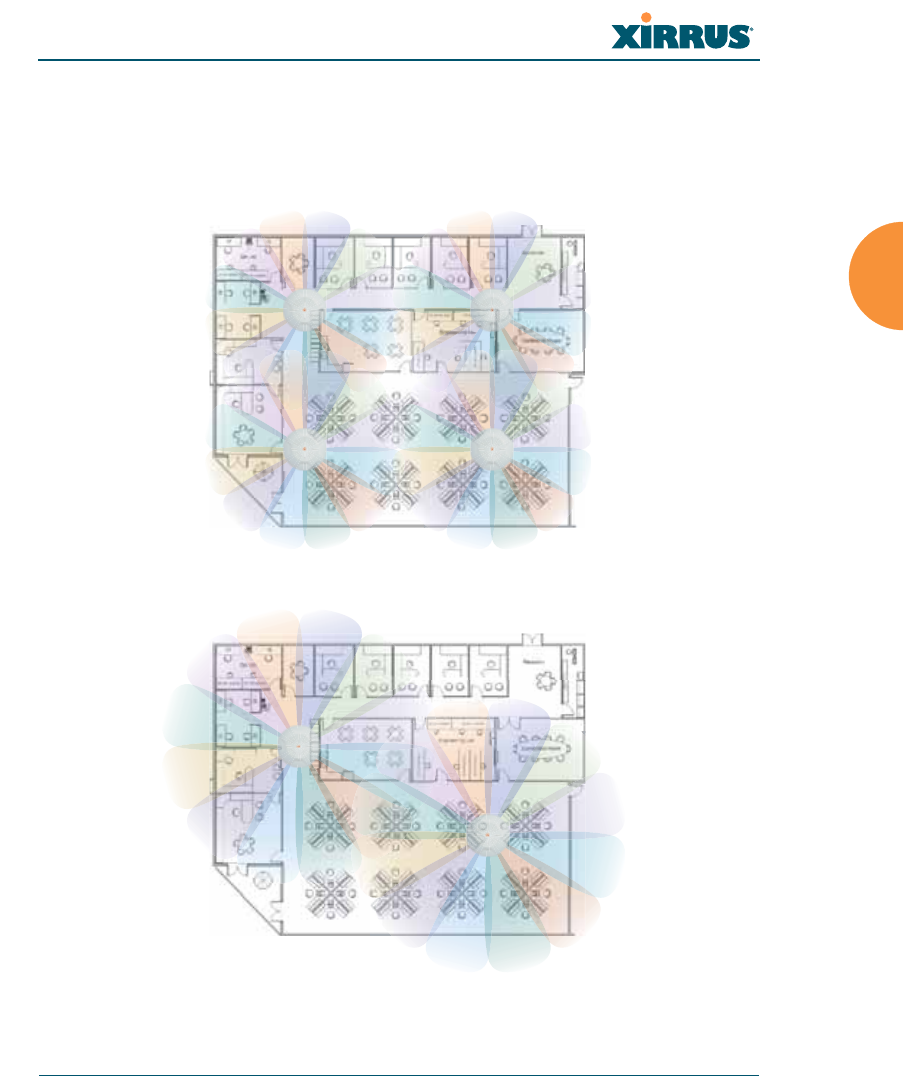
Wi-Fi Array
Installing the Wi-Fi Array 57
Deployment Examples
The following examples employ 802.11a cells, each offering minimum
throughputs of 54 Mbps, 36 Mbps, and 18 Mbps per sector respectively, and
assume a floor plan covering a total area of about 60,000 square feet (5574 sq m).
Figure 19. Deployment Scenario (54 Mbps)—Per Sector
Figure 20. Deployment Scenario (36 Mbps)—Per Sector
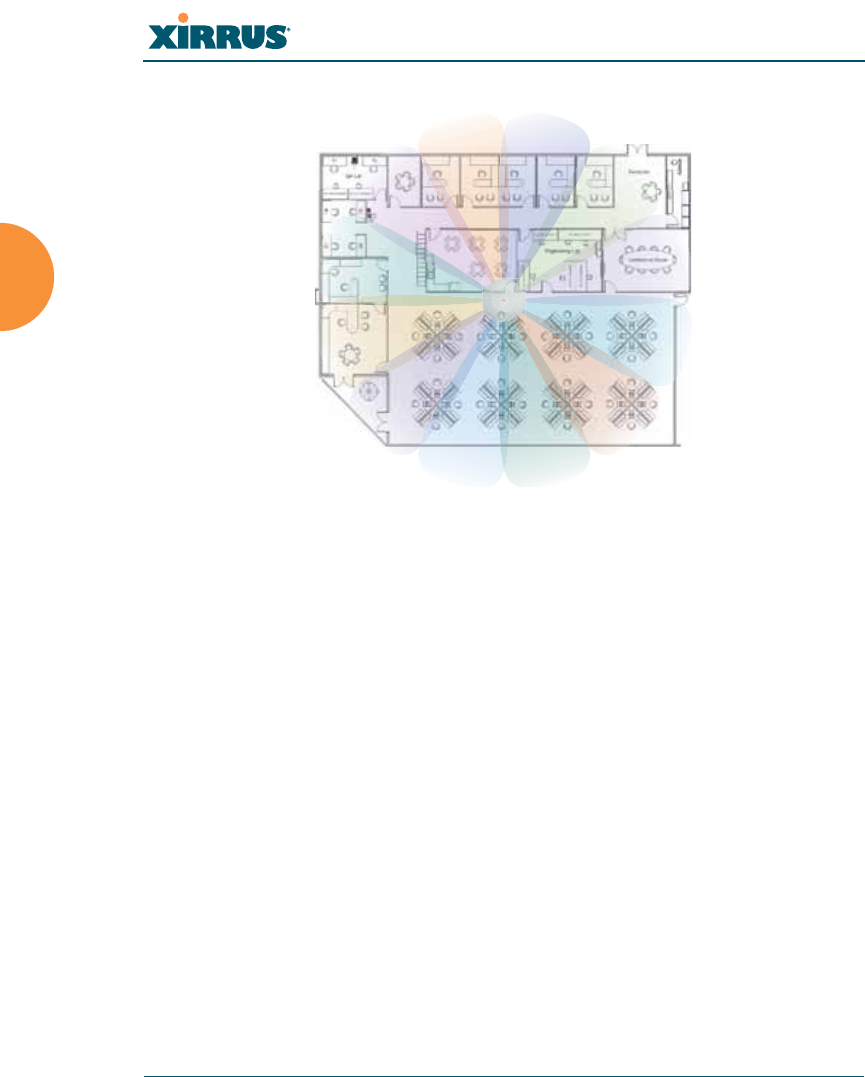
Wi-Fi Array
58 Installing the Wi-Fi Array
Figure 21. Deployment Scenario (18 Mbps)—Per Sector
See Also
Coverage and Capacity Planning
Failover Planning
Planning Your Installation

Wi-Fi Array
Installing the Wi-Fi Array 59
IEEE 802.11n Deployment Considerations
The Xirrus XN Arrays support IEEE 802.11n on all IAPs, in both 2.4 GHz and
5 GHz bands. Use of 802.11n offers significant benefits:
zHigher data rates
zHigher throughput
zSupports more users
zMore robust connections
zIncreased coverage area
zMore secure connections—supports WPA2 (Wi-Fi Protected Access 2)
These benefits result in better support for a wide range of applications such as
voice and video, intensive usage such as CAD/CAM and backups, dense user
environments, and for manufacturing and warehousing environments.
The techniques that 802.11n uses to realize these performance improvements, and
the results that can be expected are discussed in:
z“MIMO (Multiple-In Multiple-Out)” on page 60
z“Multiple Data Streams—Spatial Multiplexing” on page 61
z“Channel Bonding” on page 63
z“Improved MAC Throughput” on page 64
z“Short Guard Interval” on page 64
z“Obtaining Higher Data Rates” on page 65
z“802.11n Capacity” on page 66
#IEEE 802.11n features are supported only on XN Array models, and this
section applies only to those Arrays.
#While 802.11n increases coverage area by almost doubling the reach, you
must consider the legacy wireless devices in your network. Wireless stations
connecting using 802.11a/b/g will still be subject to a reach of up to 100 feet,
depending on the environment.
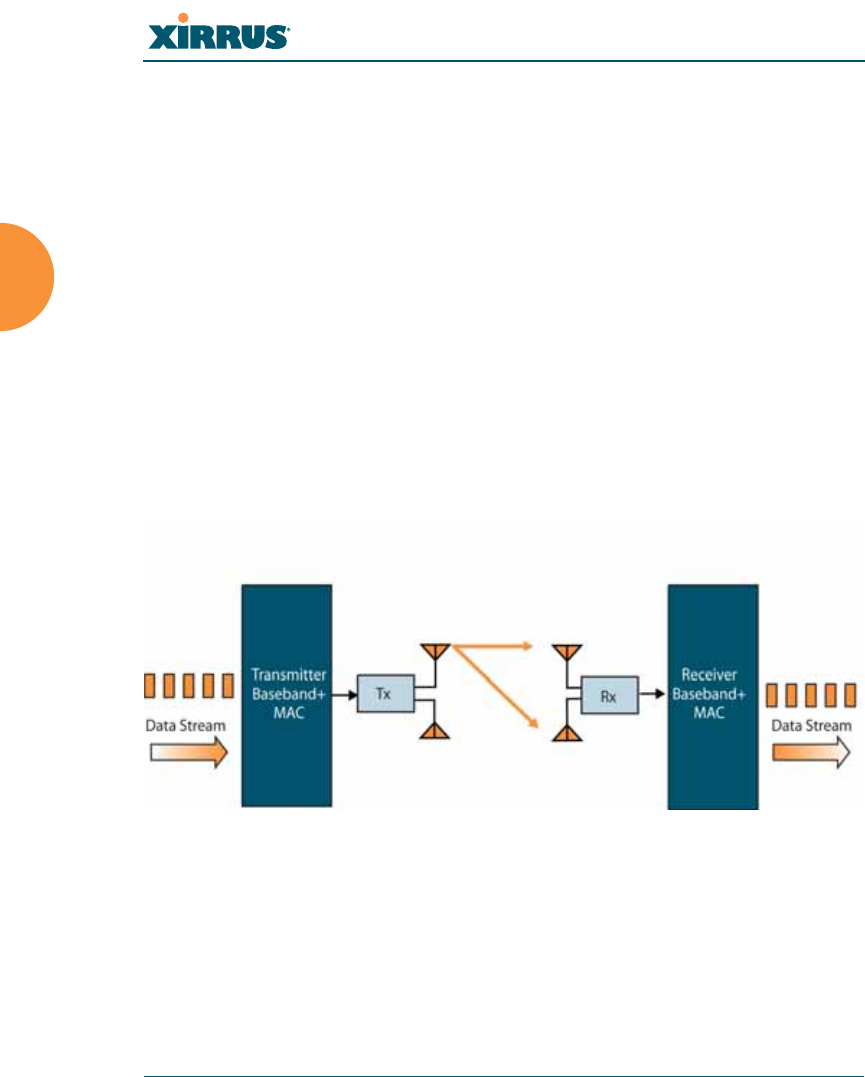
Wi-Fi Array
60 Installing the Wi-Fi Array
Two very important techniques to consider are Channel Bonding and Multiple
Data Streams—Spatial Multiplexing because they contribute a large portion of
802.11n’s speed improvements and because they are optional and configurable, as
opposed to the parts of 802.11n that are fixed. While the settings for 802.11n IAPs
come pre-configured on the Array for robust performance in typical usage, you
should review the settings for your deployment, especially channel bonding. A
global setting is provided to enable or disable 802.11n mode. See “Global Settings
.11n” on page 273 to configure 802.11n operation.
MIMO (Multiple-In Multiple-Out)
MIMO (Multiple-In Multiple-Out) signal processing is one of the core
technologies of 802.11n. It mitigates interference and maintains broadband
performance even with weak signals.
Prior to 802.11n, a data stream was transmitted via one antenna. At the receiving
end, the antenna with the best signal was selected to receive data. (Figure 22)
Figure 22. Classic 802.11 Signal Transmission
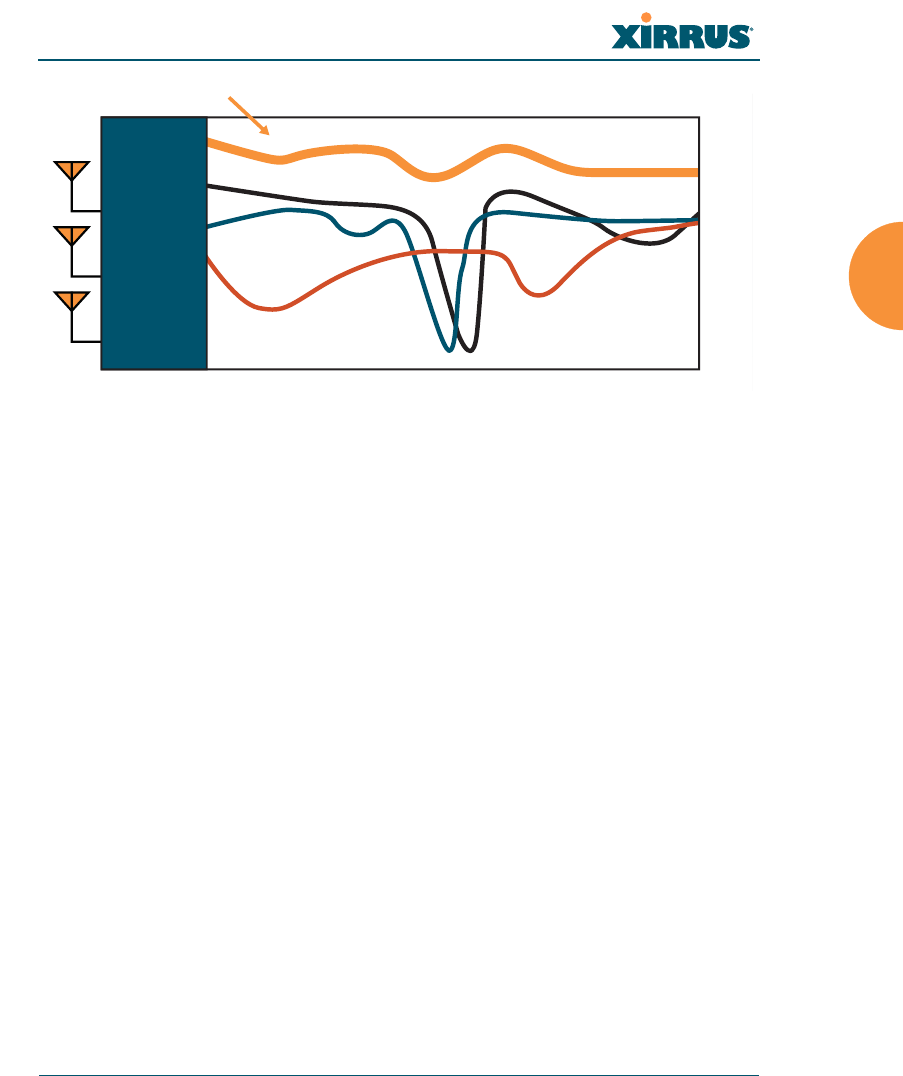
Wi-Fi Array
Installing the Wi-Fi Array 61
Figure 23. MIMO Signal Processing
MIMO signal processing uses multiple antennas to send and receive data. It takes
advantage of multipath reflections to improve signal coherence and greatly
increase receiver sensitivity (Figure 23). Multipath signals were considered to be
interference by 802.11a/b/g radios, and degraded performance. In 802.11n, these
signals are used to enhance performance. This extra sensitivity can be used for
greater range or higher data rates. The enhanced signal is the processed sum of
individual antennas. Signal processing eliminates nulls and fading that any one
antenna would see. MIMO signal processing is sophisticated enough to discern
multiple spatial streams (see Multiple Data Streams—Spatial Multiplexing). There
are no settings to configure for MIMO.
Multiple Data Streams—Spatial Multiplexing
Spatial Multiplexing transmits completely separate data streams on different
antennas (in the same channel) that are recombined to produce new 802.11n data
rates. Higher data rates are achieved by splitting the original data stream into
separate data streams. Each separate stream is transmitted on a different antenna
(using its own RF chain). MIMO signal processing at the receiver can detect and
recover each stream. Streams are then recombined, yielding higher data rates.
Frequency Across Subcarriers
Attenuation
Antenna 1 Signal
MIMO Processed Signal
Antenna 2 Signal
Antenna 3 Signal
Receiver
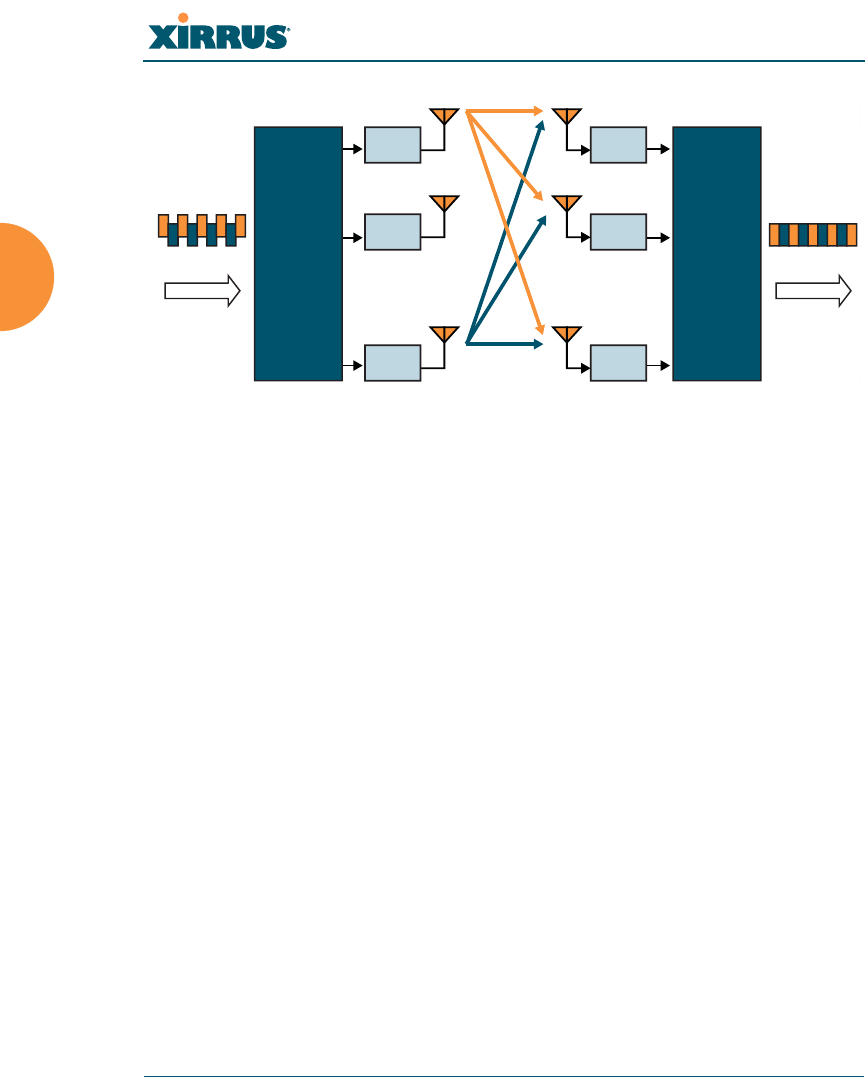
Wi-Fi Array
62 Installing the Wi-Fi Array
Figure 24. Spatial Multiplexing
Spatial multiplexing can double, triple, or quadruple the date rate, depending on
the number of transmit antennas used. You can configure the number of chains
(i.e., streams) separately for transmitting and receiving. Up to three chains may be
configured separately for transmitting and receiving. We recommend that you set
both TX Chains and RX Chains to 3 (see “Global Settings .11n” on page 273).
These are the default values.
%
Rx 1
Rx 2
Rx
M
%
Transmitter
Data Stream Data Stream
Receiver
Tx 1
Tx 2
Tx
N
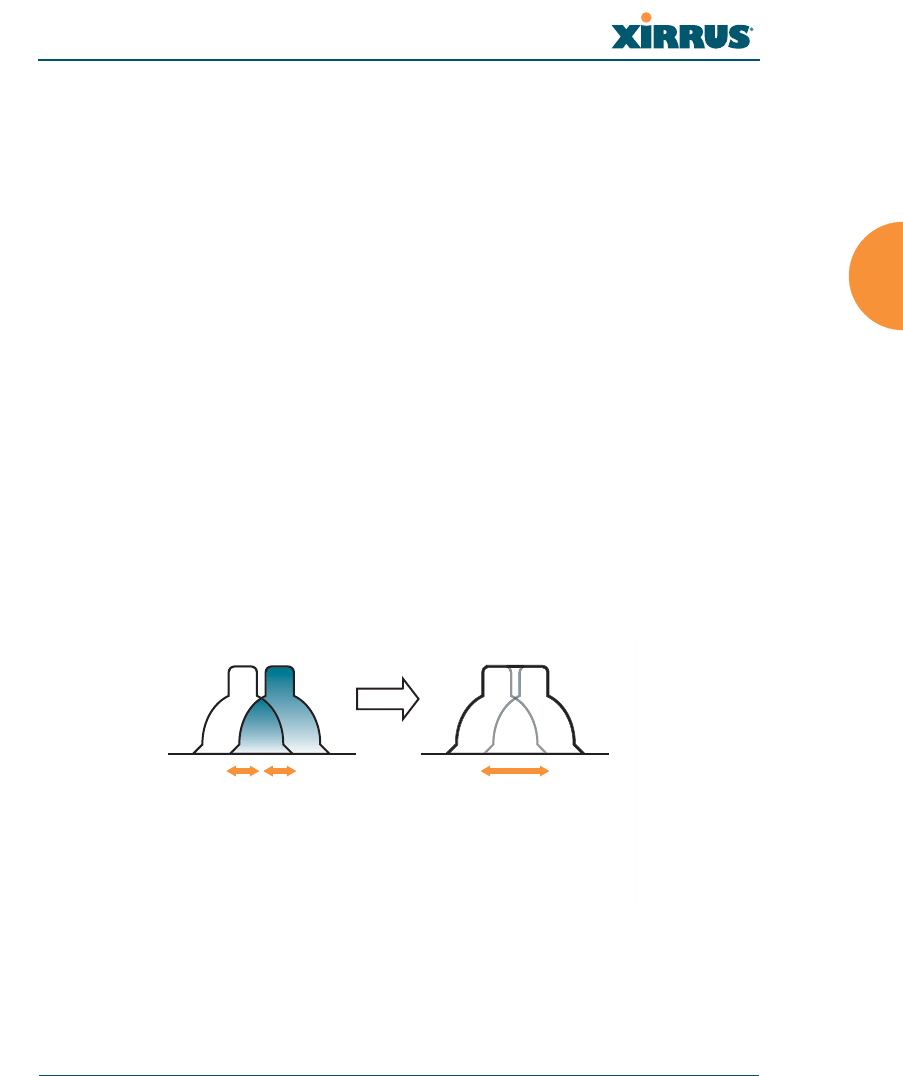
Wi-Fi Array
Installing the Wi-Fi Array 63
Channel Bonding
Channel bonding increases data rates by combining two adjacent 20 MHz
channels into one 40 MHz channel. This increases the data rate to slightly more
than double.
A bonded 40 MHz channel is specified in terms of the Primary channel and the
adjacent channel to Bond. The Bond channel is represented by +1 to use the
channel above the Primary channel, or -1 to use the channel below. In the example
shown, Channel 40 is the Primary channel and it is bonded to Channel 36, the
channel below it, by specifying -1. Be aware that Channel Bonding can make
channel planning more difficult, since you are using two channels for an IAP. We
recommend the use of the 5 GHz band, since it has many more channels than the
2.4 GHz band, and thus more channels are available for bonding.
The Array provides an Automatic Channel Bonding setting that will
automatically select the best channel for bonding on each IAP. If you enable this
option, you may select whether bonding will be dynamic (the bonded channel
changes in response to environmental conditions) or static (the bonded channel
will not be changed. See “Global Settings .11n” on page 273. To configure channel
bonding manually, on a per-IAP basis, see “IAP Settings” on page 254.
Figure 25. Channel Bonding
Ch# Ch#
40
20 MHz 20 MHz
36
40 MHz
(40, -1)
Standard 802.11 channels are
effectively 20MHz wide.
Channel bonding combines
two adjacent 20MHz channels
into a single 40MHz channel
providing increased throughput.
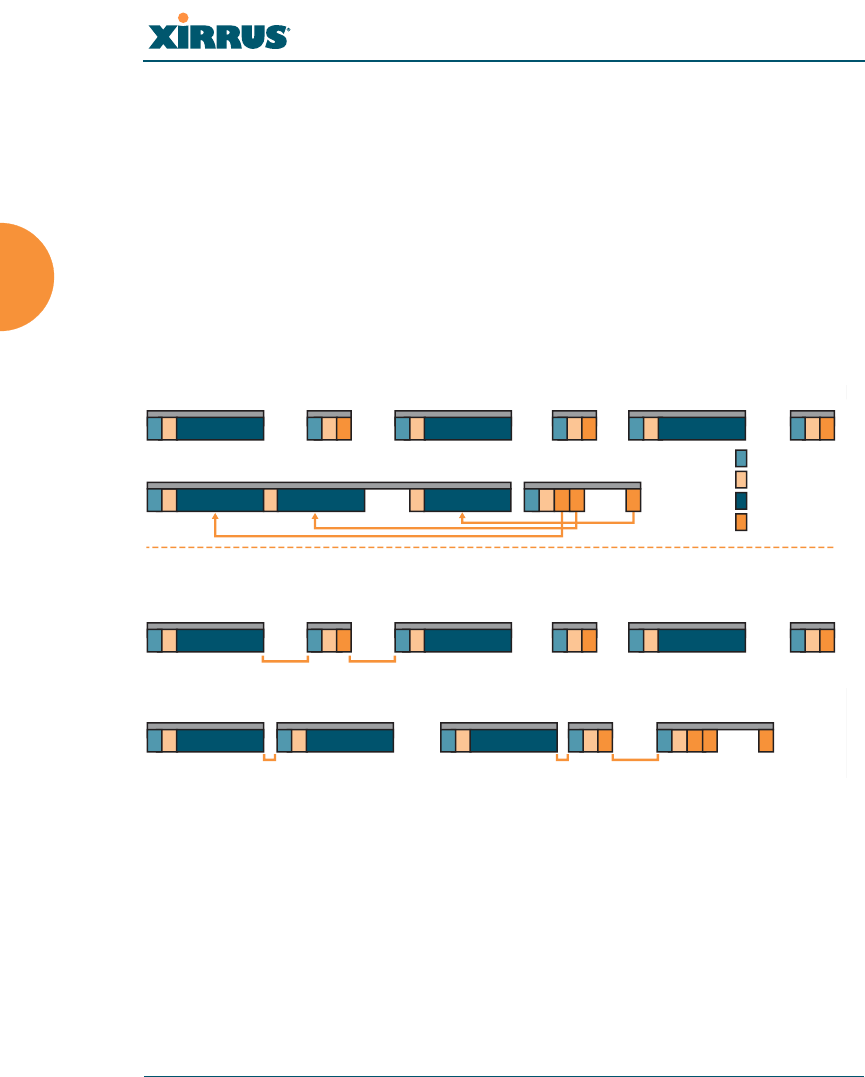
Wi-Fi Array
64 Installing the Wi-Fi Array
Improved MAC Throughput
These changes make 802.11n transmission of MAC frames 40% more efficient than
legacy transmission:
zMAC data frames are combined and given a single PHY header.
zImplicit Block ACK acknowledges all data frames within a combined
frame.
zSpacing between frames is reduced.
Figure 26. MAC Throughput Improvements
Short Guard Interval
This option reduces the wait time between signals that are being sent out over the
air. The guard interval provides immunity to propagation delays and reflections,
and is normally 800 ns (long). By using a short guard interval (400 ns), the data
rate is increased by approximately 11%. The short interval may be used in many
environments (especially indoors). If the short guard interval is used in an
N
ACK Frame
N
Data Frame
2
Data Frame
PHY Header
MAC Header
Data Frame Payload
ACK Frame Payload
Legacy Operation
High Throughput Operation
Data Frame
sss
sss sss
1
Data Frame Block ACK Frame
1122NN
ACK Frame
1 2
ACK Frame
NN
Data Frame
SIFS
SIFS
SIFS
RIFS RIFS
Legacy Operation
High Throughput Operation
Data Frame ACK Frame
sss
ssssss
1
1 2
Data Frame Data Frame Data Frame
Block ACK
Request
Frame
Block ACK
Response
Frame
12 N
1 2 2
2
Data Frame ACK Frame
N
ACK Frame
RIFS Usage (Reduced Inter-Frame Spacing)
Frame Aggregation
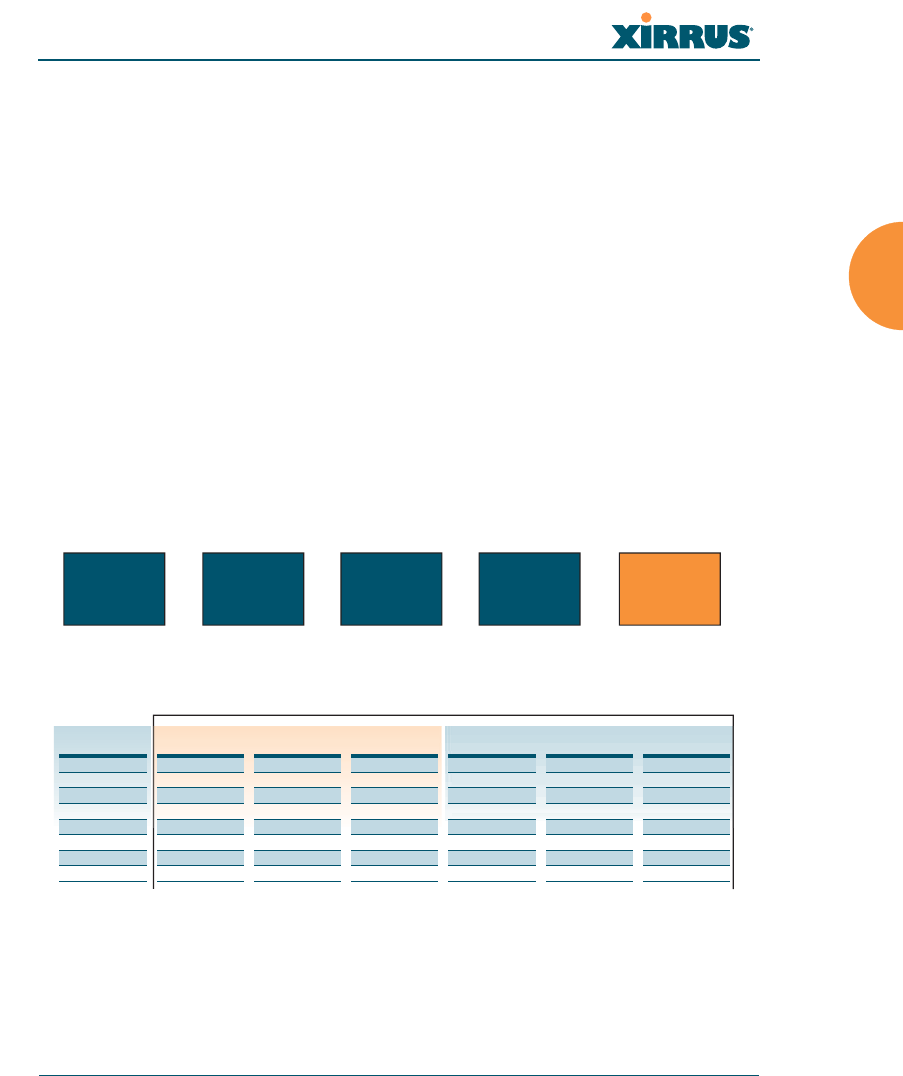
Wi-Fi Array
Installing the Wi-Fi Array 65
inappropriate environment, the signal quality will suffer and throughput will
decrease. See “Global Settings .11n” on page 273 to configure the guard interval.
Obtaining Higher Data Rates
The data rate increase obtained by using 802.11n on an Array is incremental,
based on the technologies that are applied and the options that you select:
zHigher encoding rates (Mandatory in 802.11n)
zSpatial Streams (Mandatory, but multiplier varies directly with number of
streams selected.)
zChannel Bonding (Mandatory in 802.11n, apply multiplier to IAP if it is
bonded.)
zShort Guard Interval (Optional)
See Figure 27 to compute your 802.11n data rate increase for an IAP. Apply this
increase to the 802.11 a, b or g data rates selected for the Array.
Figure 27. Computing 802.11n Data Rates
Optionally
Multiply By 2.077
to Bond
Two 20MHz
Channels
Optionally
Multiply by 1.11 for
Shorter Guard Interval
to Increase
Symbol Rate
Optionally
Multiply by 2, 3, 4
for the Number of
Additional
Spatial Streams
Choose New Base
Encoding + Modulation
BPSK (6.5)
QPSK (13, 19.5)
QAM-16 (26, 39)
QAM-64 (58.5, 65)
New 11n
Data Rate
xxx =
Expected First Generation Device Data Rates
Expected 802.11n Data Rates
802.11a 802.11g
Rates
6
9
12
18
24
36
48
54
11n Mandatory
Data Rates
6.5
13
19.5
26
39
52
58.5
65
With Channel
Bonding (40MHz)
13.5
27
40.5
54
81
108
121.5
135
With Short
Guard Interval
15
30
45
60
90
120
135
150
Two Spatial
Streams
13
26
39
52
78
104
117
130
With Channel
Bonding (40MHz)
27
54
81
108
162
216
243
270
With Short
Guard Interval
30
60
90
120
180
240
270
300
One Spatial Stream Two Spatial Streams
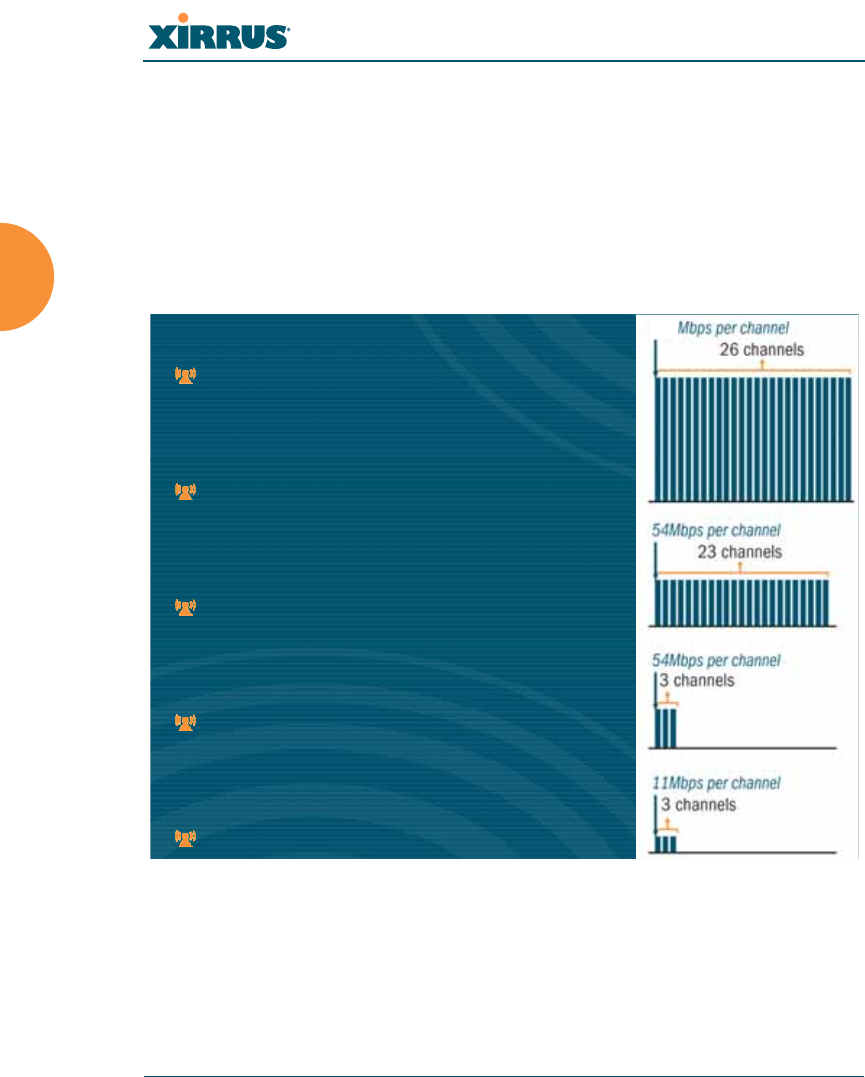
Wi-Fi Array
66 Installing the Wi-Fi Array
802.11n Capacity
802.11n offers major increases in capacity over previous 802.11 standards, as
shown in Figure 28. Note that this chart shows figures for 802.11n (with two
spatial streams, but no channel bonding). Maximum values for the XN16, for
example, will be the same as those shown in the figure, except for the 802.11a
capacity—since there are only 16 IAPs, the maximum capacity would be 16 * 54
Mbps if all IAPs are used as 802.11a radios.
Figure 28. 802.11n Capacity
802.11a/n Capacity
23 channels * 150Mbps = 3.4Gbps
802.11a Capacity
23 channels * 54Mbps = 1.2 Gbps
802.11g/n Capacity
3 channels * 150Mbps = 450 Mbps
802.11g Capacity
3 channels * 54Mbps = 162 Mbps
802.11b Capacity
3 channels * 11Mbps = 33 Mbps
802.11a/n Capacity
23 channels * 150Mbps = 3.4Gbps
802.11a Capacity
23 channels * 54Mbps = 1.2 Gbps
802.11g/n Capacity
3 channels * 150Mbps = 450 Mbps
802.11g Capacity
3 channels * 54Mbps = 162 Mbps
802.11b Capacity
3 channels * 11Mbps = 33 Mbps
150
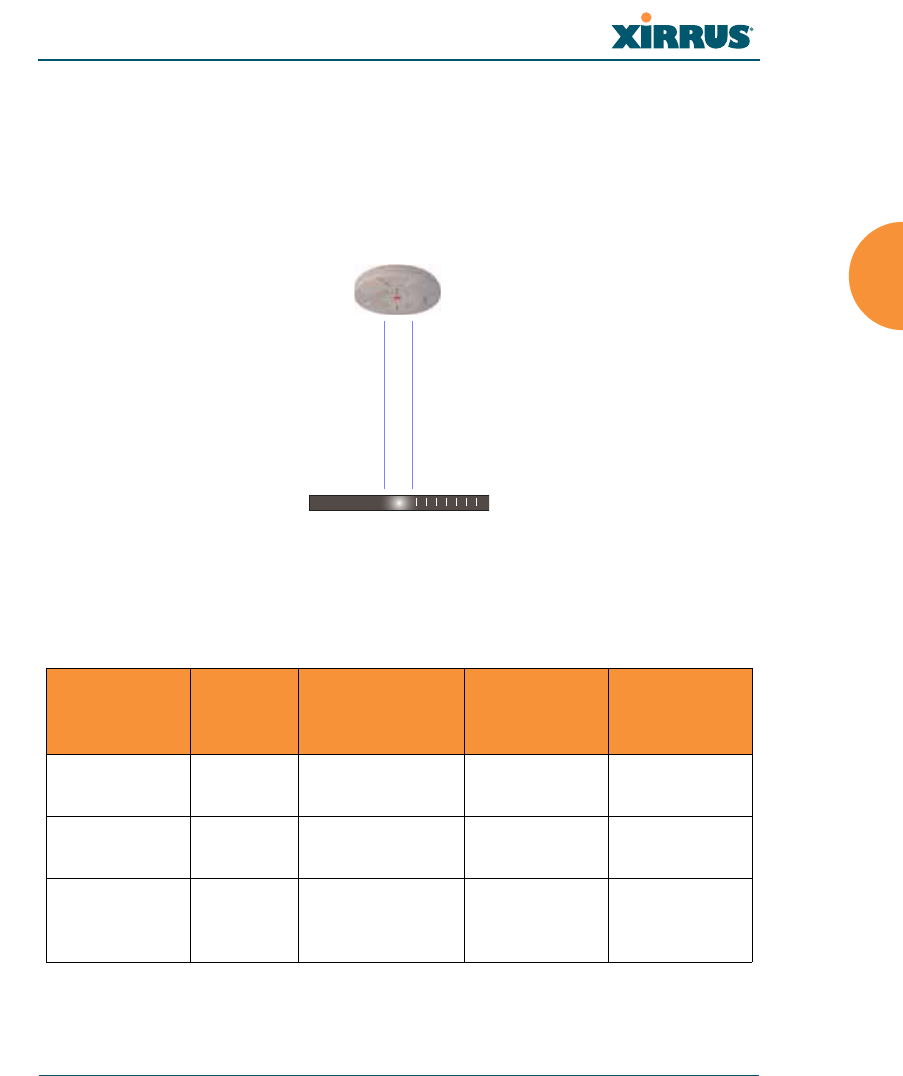
Wi-Fi Array
Installing the Wi-Fi Array 67
Failover Planning
This section discusses failover protection at the unit and port levels.
Port Failover Protection
To ensure that service is continued in the event of a port failure, you can utilize
the Gigabit 1 and Gigabit 2 ports simultaneously.
Figure 29. Port Failover Protection
In addition, the Array has full failover protection between the Gigabit 1 and
Gigabit 2 Ethernet ports (see following table).
The Wi-Fi Array Gigabit Ethernet ports actually support a number of modes:
z802.3ad Link Aggregation
Interface Bridges
Data?
Bridges
Management
Traffic?
Fails Over To: IP address
Fast Ethernet No Yes None DHCP or
static
Gigabit 1 Yes Yes Gigabit 2 DHCP or
static
Gigabit 2 Yes Yes Gigabit 1 Assumes the
IP address of
Gigabit 1
Ethernet switch
Multiple port connections
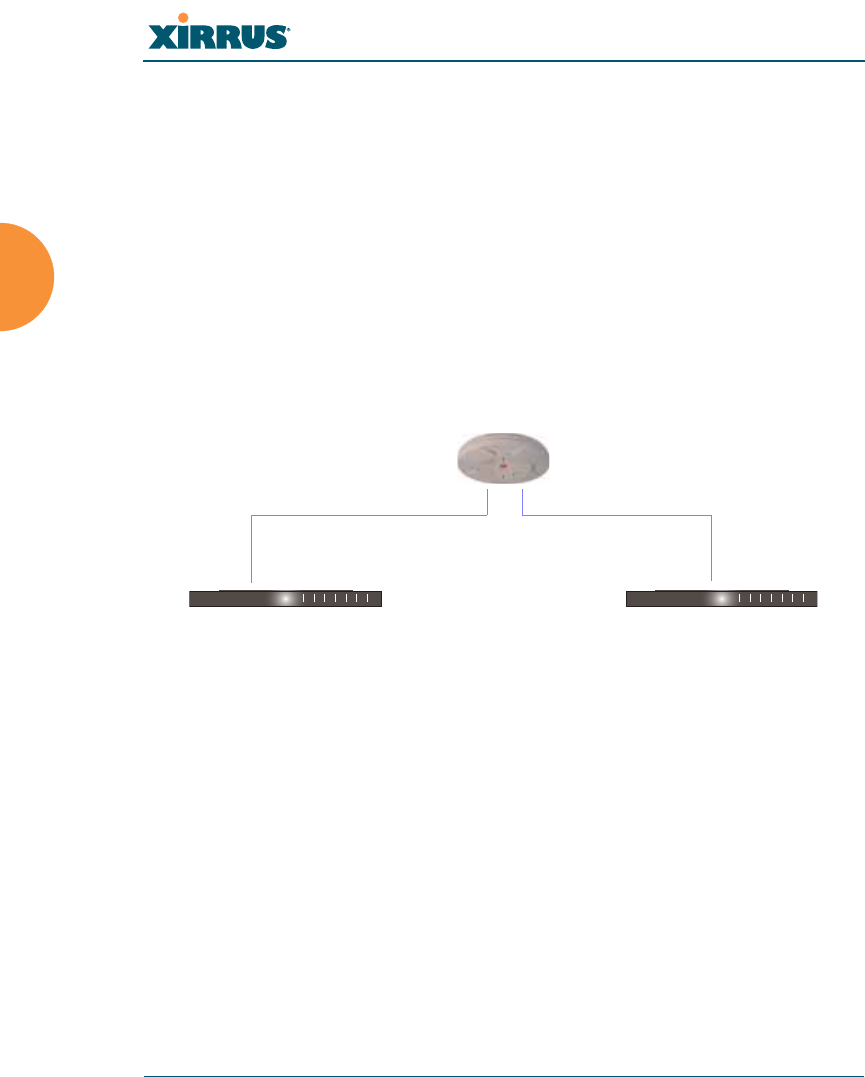
Wi-Fi Array
68 Installing the Wi-Fi Array
zLoad Balancing
zBroadcast
zLink Backup
zBridged
zMirrored
For more details on Gigabit port modes and their configuration, please see
“Network Interface Ports” on page 182.
Switch Failover Protection
To ensure that service is continued in the event of a switch failure, you can
connect Arrays to more than one Ethernet switch (not a hub).
Figure 30. Switch Failover Protection
See Also
Coverage and Capacity Planning
Deployment Examples
Installation Prerequisites
Network Management Planning
Planning Your Installation
Power Planning
Security Planning
#Gigabit Ethernet connections must be on the same subnet.
Ethernet switch Backup switch
Ethernet connections

Wi-Fi Array
Installing the Wi-Fi Array 69
Power Planning
All XN Series Array models and XS16/12/8/4 Arrays support Power over
Gigabit Ethernet (PoGE) with an integrated splitter. AC power is also supported
on all XN Arrays and some versions of the XS8, XS12, and XS16.
This section discusses the AC and PoGE power options.
AC Power
The AC power option requires a direct connection between the Array and a
dedicated AC power outlet. The power cord is provided with the unit.
Power over Gigabit Ethernet
To deliver power to the Array, you may use the optional XP1 or XP8 Power over
Gigabit Ethernet (PoGE) modules. They provide power over Cat 5e or Cat 6 cables
to the Array without running power cables—see Figure 5 on page 12.
Specific models of the Array are compatible with specific PoGE modules. For
details, please see “Power over Gigabit Ethernet Compatibility Matrix” on
page 416.
See Also
Coverage and Capacity Planning
Deployment Examples
Failover Planning
Network Management Planning
Security Planning
#When using Cat 5e or Cat 6 cable, power can be provided up to a distance of
100m.

Wi-Fi Array
70 Installing the Wi-Fi Array
Security Planning
This section offers some useful guidelines for defining your preferred encryption
and authentication method. For additional information, see “Understanding
Security” on page 208 and the Security section of “Frequently Asked Questions”
on page 400.
Wireless Encryption
Encryption ensures that no user can decipher another user’s data transmitted
over the airwaves. There are three encryption options available to you, including:
zWEP-40bit or WEP-128bit
Because WEP is vulnerable to cracks, we recommend that you only use
this for legacy devices that cannot support a stronger encryption type.
zWi-Fi Protected Access (WPA)
This is much more secure than WEP and uses TKIP for encryption.
zWi-Fi Protected Access (WPA2) with AES
This is government-grade encryption—available on most new client
adapters—and uses the AES–CCM encryption mode (Advanced
Encryption Standard–Counter Mode).
Authentication
Authentication ensures users are who they say they are, and occurs when users
attempt to join the wireless network and periodically thereafter. The following
authentication methods are available with the Wi-Fi Array:
zRADIUS 802.1x
802.1x uses a remote RADIUS server to authenticate large numbers of
clients, and can handle different authentication methods (EAP-TLS, EAP-
TTLS, EAP-PEAP, and EAP-LEAP Passthrough). Administrators may
also be authenticated via RADIUS when preferred, or to meet particular
security standards.
zXirrus Internal RADIUS server
Recommended for smaller numbers of users (about 100 or less). Supports
EAP-PEAP only

Wi-Fi Array
Installing the Wi-Fi Array 71
zPre-Shared Key
Uses a pass-phrase or key that is manually distributed to all authorized
users. The same passphrase is given to client devices and entered into
each Array.
zMAC Access Control Lists (ACLs)
MAC access control lists provide a list of client adapter MAC addresses
that are allowed or denied access to the wireless network, and can be
used in addition to any of the above authentication methods. ACLs are
good for embedded devices, like printers and bar-code scanners (though
MAC addresses can be spoofed). The Wi-Fi Array supports 1,000 ACL
entries.
Meeting PCI DSS Standards
The Payment Card Industry (PCI) Data Security Standard (DSS) was developed
by major credit card companies. It lays out a set of requirements that must be met
in order to provide adequate security for sensitive data. The the Wi-Fi Array may
be configured to satisfy PCI DSS standards. For details, please see Appendix D:
Implementing Security Standards.
Meeting FIPS Standards
The Federal Information Processing Standard (FIPS) Publication 140-2 establishes
a computer security standard used to accredit cryptographic modules. The
standard is a joint effort by the U.S. and Canadian governments. To implement
Level 2 security requirements of FIPS Level 2 on the Wi-Fi Array, see Appendix D:
Implementing Security Standards.
See Also
Failover Planning
Network Management Planning
Power Planning
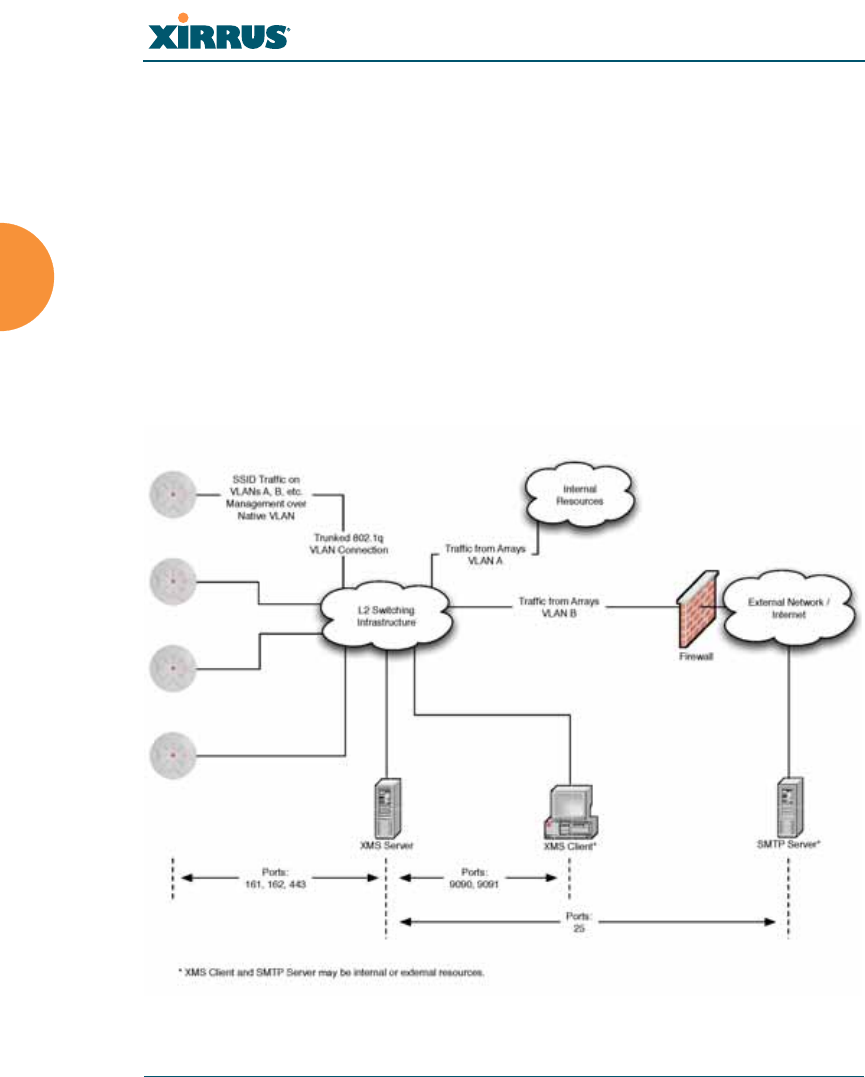
Wi-Fi Array
72 Installing the Wi-Fi Array
Port Requirements
A number of ports are used by various Array features and by the Xirrus
Management System (XMS). The Port Requirements table on page 73 lists ports
and the features that require them (XMS port requirements are included in the
table for your convenience). If you are using a feature, please make sure that the
ports that it requires are not blocked by firewalls or other policies, and that they
do not conflict with any other port assignments.
As an example, XMS port requirements are illustrated in Figure 31. XMS requires
ports 161, 162, and 443 to be passed between Arrays and the XMS server.
Similarly, ports 9090 and 9091 are required for communication between the XMS
server and XMS clients, and port 25 is typically used by the XMS server to access
an SMTP server to send email notifications.
Figure 31. Port Requirements for XMS
XMS Server XMS Client*
L2 Switching
Infrastructure
SMTP Server*
Internal
Resources
External Network /
Internet
Ports:
9090, 9091
Ports:
161, 162, 443
SSID Traffic on
VLANs A, B, etc.
Management over
Native VLAN
Traffic from Arrays
VLAN B
Traffic from Arrays
VLAN A
Trunked 802.1q
VLAN Connection
Ports:
25
* XMS Client and SMTP Server may be internal or external resources.

Wi-Fi Array
Installing the Wi-Fi Array 73
The following table lists port requirements for the Array and for XMS, how they
are used, and whether they may be changed.
Port Application Peer Configurable
Array
20 tcp
21 udp FTP Client Yes
22 tcp SSH Client Yes
23 tcp Telnet Client Yes
25 tcp SMTP Mail Server No
69 tcp TFTP TFTP Server No
161 tcp/udp SNMP XMS Server No
162 tcp/udp
SNMP Traphost Note -
Up to four Traphosts
may be configured.
XMS Server
Yes - but
required by
XMS
443 tcp HTTPS (WMI,WPR) Client Yes
514 udp Syslog Syslog Server No
1812, 1645
udp
RADIUS (some
servers use 1645) RADIUS Server Yes
1813, 1646
udp
RADIUS Accounting
(some servers still use
1646)
RADIUS Accounting
Server Yes
2055 udp Netflow Client Yes
5000 tcp Virtual Tunnel VTUN Server Yes

Wi-Fi Array
74 Installing the Wi-Fi Array
See Also
Management Control
External Radius
Services
VLAN Management
XMS
25 tcp SMTP Mail Server Yes
161 udp SNMP Arrays No
162 udp SNMP Traphost 1 Arrays Via XMS
config file
443 tcp HTTPS Arrays No
514 udp Resident Syslog
server Internal* Via XMS
config file
1099 tcp RMI Registry Internal* No
2000 tcp XMS Back-end Server Internal* No
3306 tcp MySQL Database Internal* No
8001 tcp Status Viewer Internal* No
8007 tcp Tomcat Shutdown Internal* During
installation
8009 tcp Web Container Internal* During
installation
9090 tcp XMS Webserver XMS client During
installation
9091 tcp XMS Client Server XMS client Via XMS
config file
* Internal to XMS Server, no ports need to be unblocked on other network devices
Port Application Peer Configurable

Wi-Fi Array
Installing the Wi-Fi Array 75
Network Management Planning
Network management can be performed using any of the following methods:
zCommand Line Interface, using an SSH (Secure Shell) utility, like PuTTY.
The utility must be set up to use SSH-2, since the Array will only allow
SSH-2 connections.
zWeb-based management, using the Array’s embedded Web Management
Interface (WMI). This method provides configuration and basic
monitoring tools, and is good for small deployments (one or two units).
zCentralized Web-based management, using the optional Xirrus
Management System (XMS), which can be run on a dedicated Xirrus
appliance (XM-3300) or your own server. The XMS is used for managing
large Wi-Fi Array deployments from a centralized Web-based interface
and offers the following features:
Globally manage large numbers of Arrays (up to 500)
Seamless view of the entire wireless network
Easily configure large numbers of Arrays
Rogue AP monitoring
Easily manage system-wide firmware updates
Monitor performance and trends
Aggregation of alerts and alarms
See Also
Failover Planning
Power Planning
Security Planning
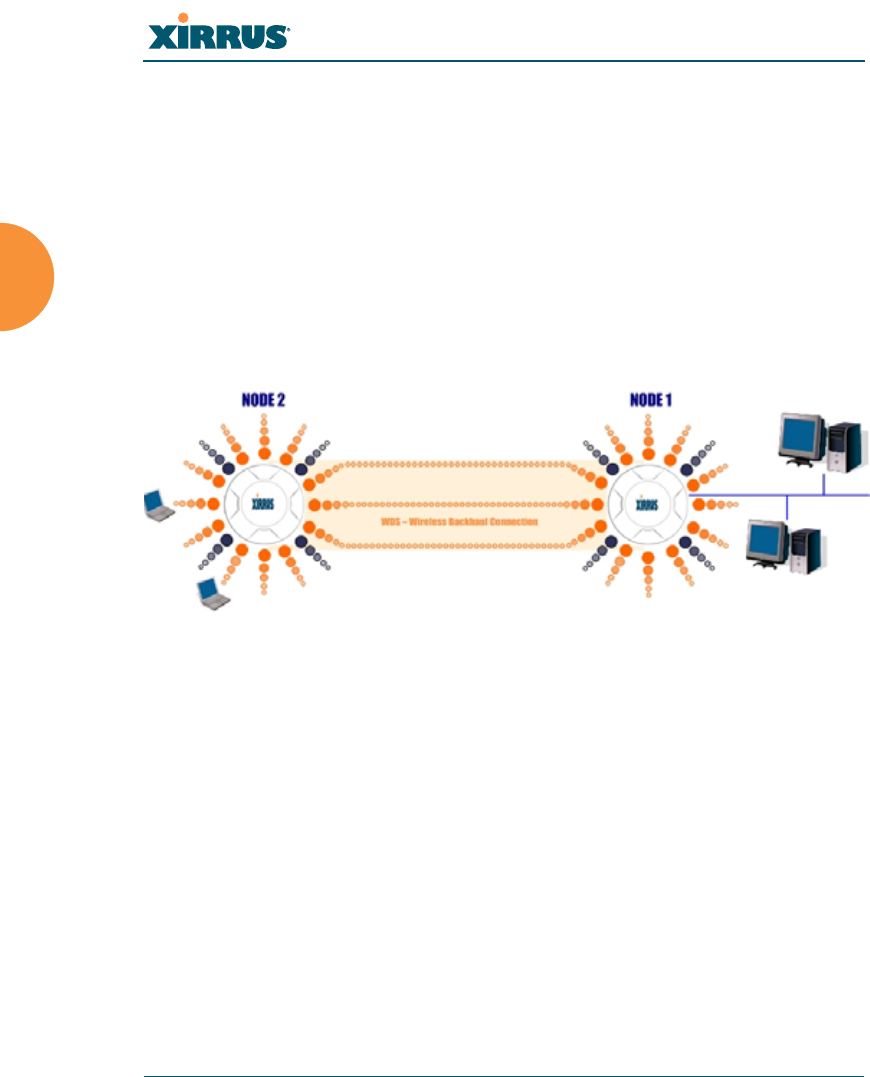
Wi-Fi Array
76 Installing the Wi-Fi Array
WDS Planning
WDS (Wireless Distribution System) creates wireless backhauls between arrays,
allowing your wireless network to be expanded using multiple Arrays without
the need for a wired backbone to link them (see Figure 32). WDS features include:
zOne to three IAPs may be used to form a WDS link, yielding up to 162
Mbps bandwidth per link. Up to 4 WDS links may be defined per Array.
zAutomatic IAP Load Balancing
zClients can still associate to a BSS on the same radio interface used for a
WDS Host Link. This will take bandwidth from the WDS link.
Figure 32. WDS Link
zMultiple links per Array allow you to configure multi-hop connections.
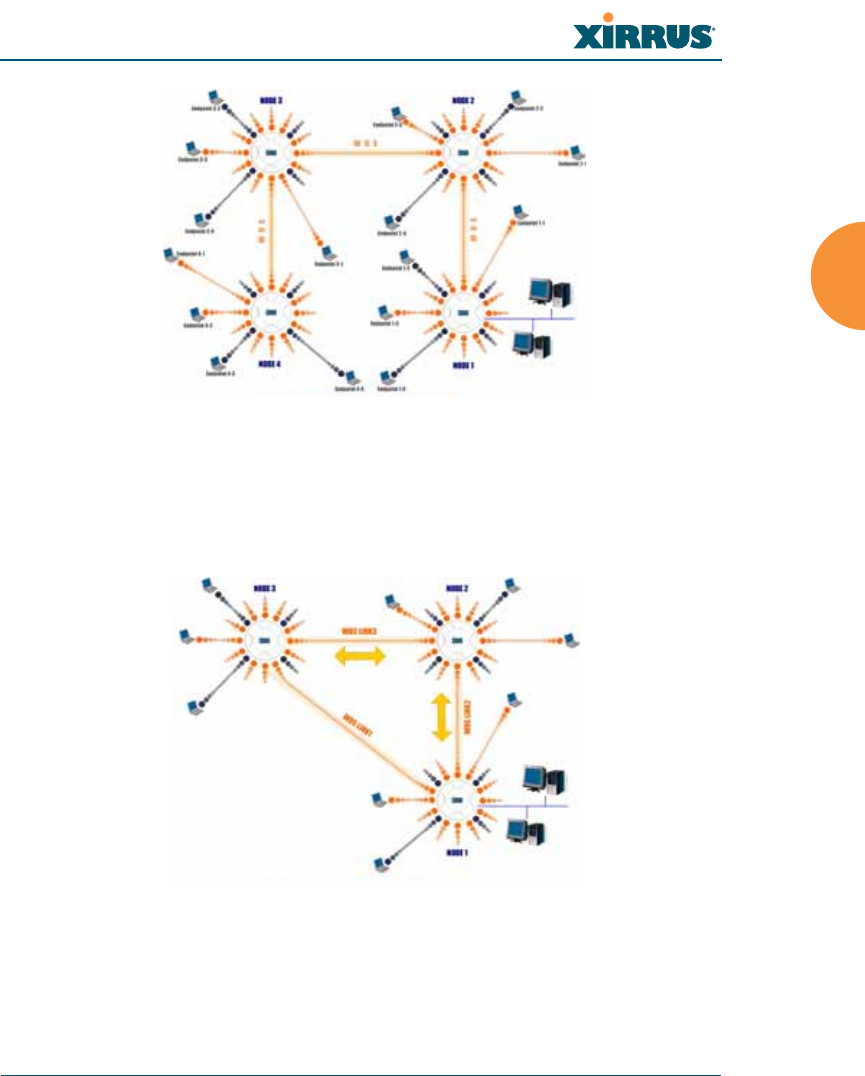
Wi-Fi Array
Installing the Wi-Fi Array 77
Figure 33. A Multiple Hop WDS Connection
zMultiple WDS links can provide link redundancy (failover capability - see
Figure 34). A network protocol (Spanning Tree Protocol—STP) prevents
Arrays from forming network loops.
Figure 34. WDS Failover Protection

Wi-Fi Array
78 Installing the Wi-Fi Array
WDS links have a Host/Client relationship similar to the usual IAP/station
pattern for Arrays:
zA WDS Client Link associates/authenticates to a host (target) Array in the
same way that a station associates to an IAP. The client side of the link
must be configured with the root MAC address of the target (host) Array.
zA WDS Host Link acts like an IAP by allowing one WDS Client Link to
associate to it. An Array may have both client and host links.
WDS configuration is performed only on the client-side Array. See “WDS” on
page 285. Note that both Arrays must be configured with the same SSID name.

Wi-Fi Array
Installing the Wi-Fi Array 79
Deployment Summary
The following table summarizes your deployment options.
See Also
Coverage and Capacity Planning
Deployment Examples
Network Management Planning
Planning Your Installation
Power Planning
Security Planning
Function
Number of Wi-Fi Arrays
One or Two Three or More
Power AC (some Array models)
Power over Gigabit
Ethernet
AC (some Array models)
Power over Gigabit Ethernet
UPS backup
(recommended)
Failover Recommended Highly recommended
VLANs Optional Optional use,
Can be used to put all APs
on one VLAN or map to
existing VLAN scheme
Encryption WPA2 with AES
(recommended)
PSK or 802.1x
WPA2 with AES
(recommended)
802.1x keying
Authentication Internal RADIUS server
EAP-PEAP
Pre-Shared Key
External RADIUS server
Management Internal WMI
Internal CLI (via SSHv2)
XMS (SNMP)
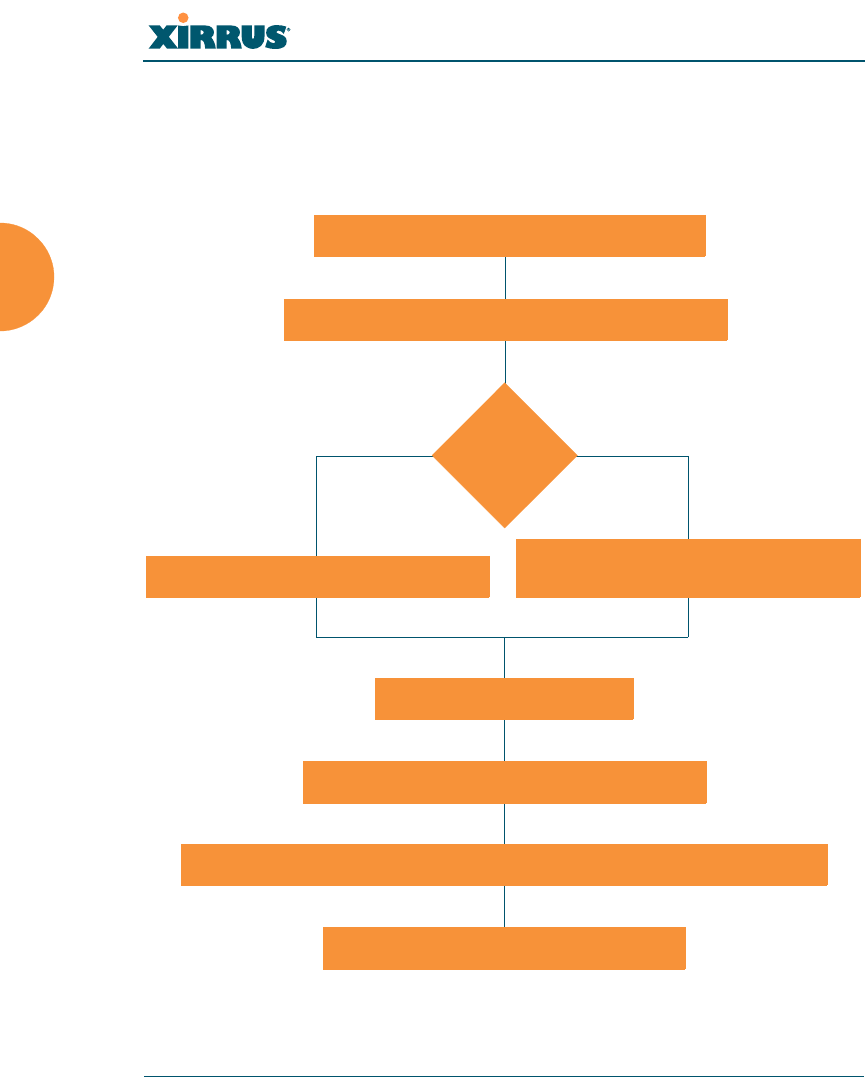
Wi-Fi Array
80 Installing the Wi-Fi Array
Installation Workflow
This workflow illustrates the steps that are required to install and configure your
Wi-Fi Array successfully. Review this flowchart before attempting to install the
unit on a customer’s network.
Figure 35. Installation Workflow
Determine the number of Arrays needed
Choose the location(s) for your Wi-Fi Arrays
AC PoGE
Install the mounting plate
Connect the cables and turn on the power
Verify that the Ethernet link and radio LEDs are functioning correctly
Perform the Express Setup procedure
Run AC power and Ethernet cables Run Ethernet cables (<100m total
AC or PoGE?
idistance from switch)

Wi-Fi Array
Installing the Wi-Fi Array 81
See Also
Coverage and Capacity Planning
Deployment Examples
Deployment Summary
Failover Planning
Installation Prerequisites
Planning Your Installation
Power Planning
Wi-Fi Array Product Overview
Product Specifications—XN16, XN12, and XN8
Product Specifications—XS16/XS-3900, XS12, and XS8/XS-3700
Product Specifications—XS4/XS-3500
Security Planning
Unpacking the Wi-Fi Array
When you unpack your Wi-Fi Array, you will find the following items in the
carton:
Item Quantity
Xirrus Wi-Fi Array 1
AC power cord (for AC-equipped models) 1
Console cable 1
Mounting plate 1
Mounting screws 4
Tile grid mounting clamps 4
Clamp nuts 4
Mounting template 1
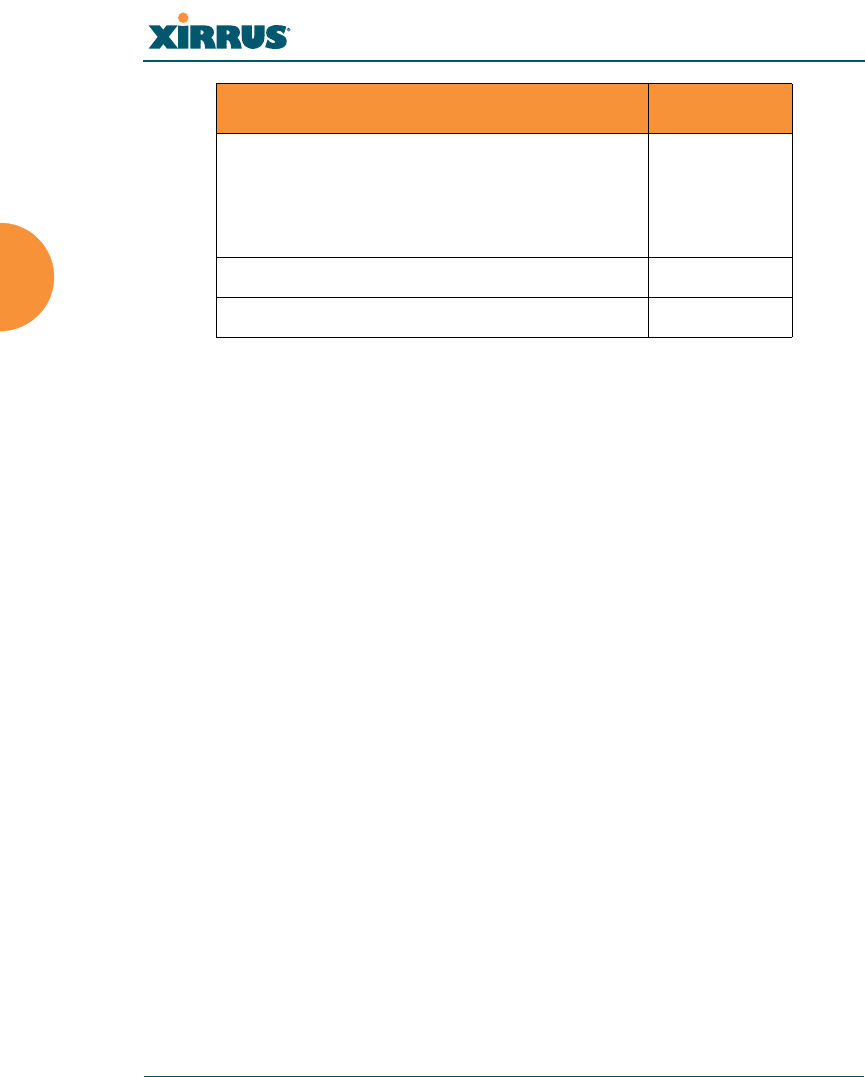
Wi-Fi Array
82 Installing the Wi-Fi Array
See Also
Installation Prerequisites
Installation Workflow
CD-ROM containing:
This User’s Guide in PDF format
End User License Agreement (EULA)
README file
1
Quick Install Guide 1
Registration Card 1
Item Quantity
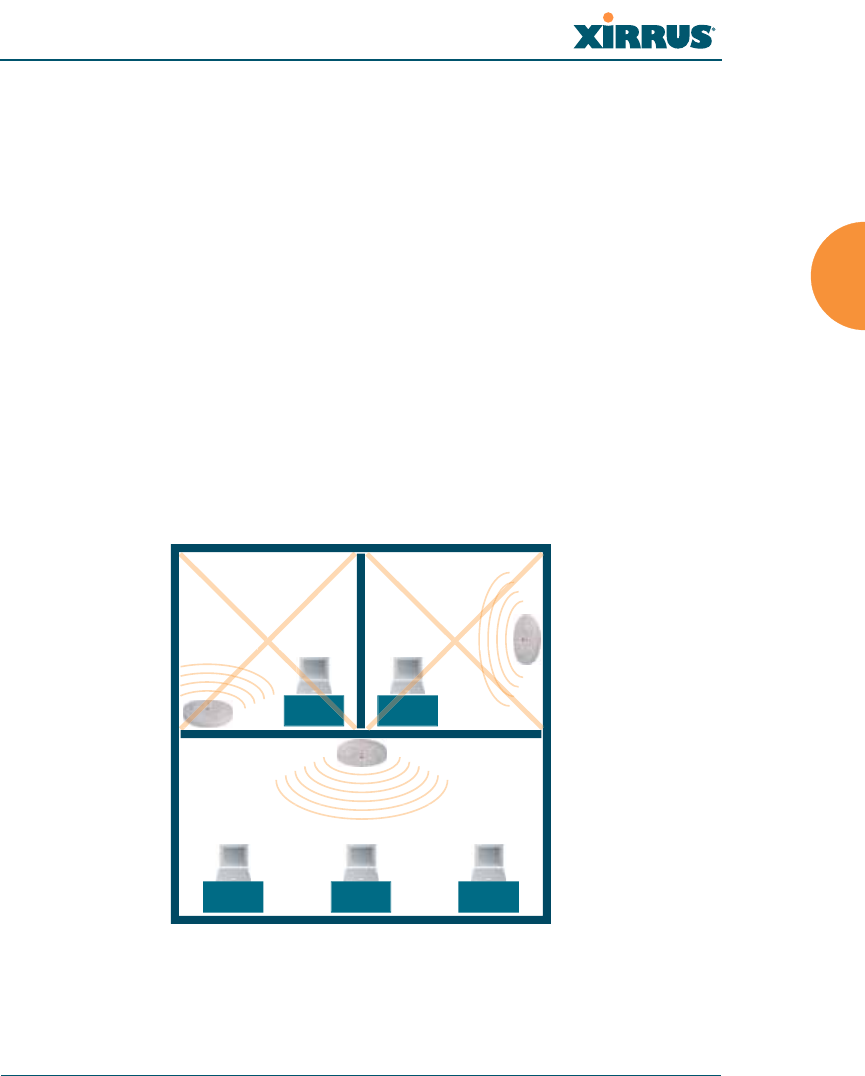
Wi-Fi Array
Installing the Wi-Fi Array 83
Installing Your Wi-Fi Array
This section provides instructions for completing a physical installation of your
Xirrus Wi-Fi Array.
Choosing a Location
Based on coverage, capacity and deployment examples previously discussed,
choose a location for the Array that will provide the best results for your needs.
The Wi-Fi Array was designed to be mounted on a ceiling where the unit is
unobtrusive and wireless transmissions can travel unimpeded throughout open
plan areas.
You also have the option of mounting the Array on a wall, using the optional wall
mount assembly kit. For wall mount instructions, go to “Mounting Array on a
Wall (All models except 4-port Arrays)” on page 96.
Choose a location that is central to your users (see the following diagram for
correct placement.
Figure 36. Array Placement
WR
ONG
CORRECT
R
ORRE
R
ORREC
WR
ONG
G
G
O
ON
R
O
R
ON
ON
R
O
R
ON

Wi-Fi Array
84 Installing the Wi-Fi Array
Wiring Considerations
If you are using the Xirrus Power over Gigabit Ethernet modules (PoGE) to
distribute power, see “Power over Gigabit Ethernet (PoGE) (Optional)” on
page 12. If you prefer to use AC power and you have an Array that supports AC,
an AC power outlet must be available to the Array.
Once you have determined the best location for your Wi-Fi Array, you must run
cables to the location for the following services:
Power
One of the following options:
zNo power cable is required if using PoGE modules.
zDedicated AC power if PoGE is not in use. A UL-approved cord
is shipped with all AC-equipped Arrays. You must use a UL-
approved cord if using AC power.
Network
zGigabit 1—If using PoGE modules, the total of all Cat 5e or Cat 6
cable segments from the Gigabit Ethernet switch to the Array
must be less than 100m long. The Array must be connected to
PoGE networks without routing cabling to the outside plant, to
ensure that cabling is not exposed to lightning strikes or possible
high voltage crossover.
zGigabit 2 (optional, not available on the four-port Arrays)
zFast Ethernet (optional, not available on the four-port Arrays)
zSerial cable (optional) — cable lengths up to 25’ per the RS-232
specification.

Wi-Fi Array
Installing the Wi-Fi Array 85
Important Notes About Network Connections
Read the following notes before making any network connections.
See Also
Failover Planning
Installation Prerequisites
Installation Workflow
Mounting the Wi-Fi Array on a Wall (XS4 and XS-3500)
Mounting Array on a Wall (All models except 4-port Arrays)
Mounting the Array on a Ceiling
Power over Gigabit Ethernet (PoGE) (Optional)
Unpacking the Wi-Fi Array
#When the unit’s IP address is unknown or a network connection has not
been established, the serial cable is used for connecting directly with the
Command Line Interface (CLI) via HyperTerminal. When a network
connection is established, the Array can be managed from any of the
available network connections, either Fast Ethernet, Gigabit 1 or Gigabit 2.
!The Array’s Ethernet ports should be plugged into an Ethernet switch, not an
Ethernet hub—if a hub is used, we recommend that you connect only one
Ethernet port.
!The Gigabit1 Ethernet interface is the primary port for both data and
management traffic. If a single Ethernet connection is used, it must be
connected to the Gigabit1 Ethernet interface. See also, “Port Failover
Protection” on page 67.
The 10/100 Ethernet Port may be used for managing the Array out of band
from the Gigabit Ethernet ports. The 10/100 port will route only management
traffic, using a static route that may be configured for this interface. See
“interface” on page 336.
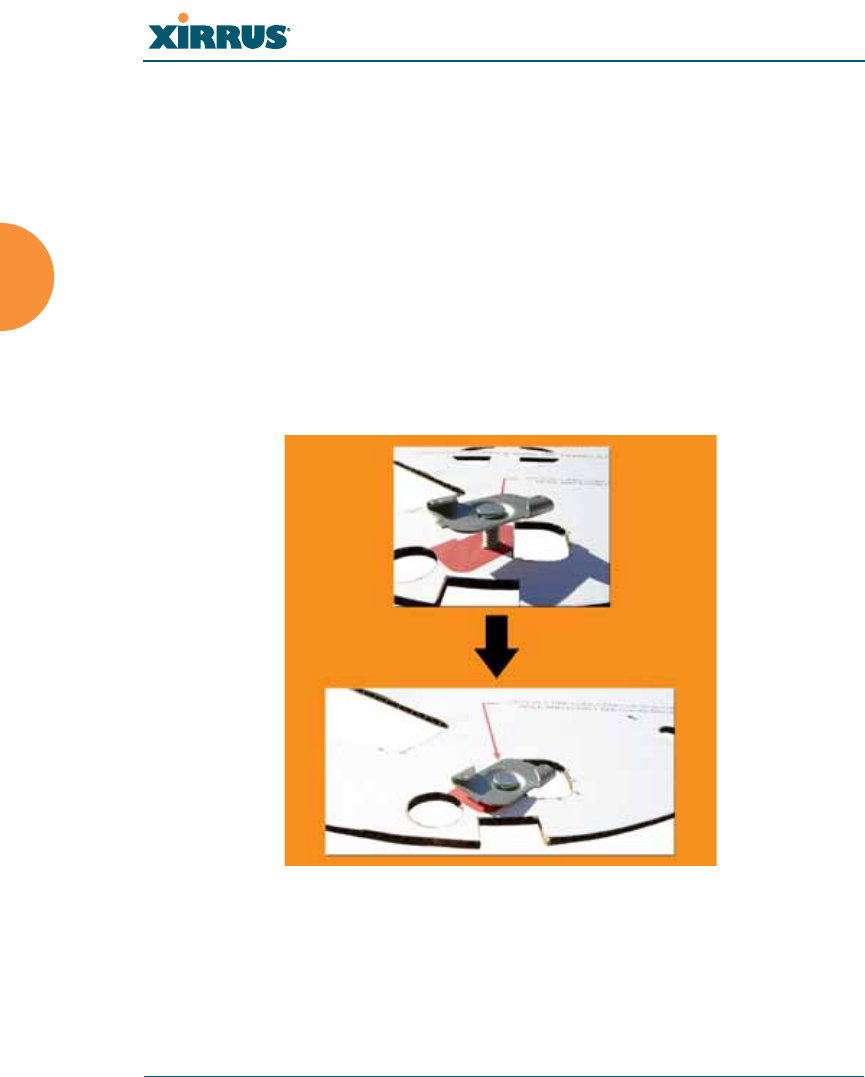
Wi-Fi Array
86 Installing the Wi-Fi Array
Mounting the Array on a Ceiling
Most offices have drop-down acoustical ceiling tiles set into a standard grid. The
Wi-Fi Array has been designed to enable mounting to a tiled ceiling via a
mounting plate and clamps that attach to the grid. Once the mounting plate is
attached, the Array simply rotates onto the plate (similar to a smoke detector).
Once the unit is mounted it can be removed and re-attached easily, without the
need for tools or modifications to the original installation.
This section assumes that you are mounting the Array to a tiled ceiling. If your
ceiling is not tiled, the mounting plate can be attached directly to the ceiling with
the screws and anchors provided (without using the tile grid mounting clamps).
Attaching the T-Bar Clips to the Template
.
Figure 37. Attaching the T-Bar Clips to the Template
The T-bar clips create four mounting points on the ceiling tile grid for the Array
mounting plate. Use the mounting template (provided) to find the correct location
for all four clamps by pre-loading the 4 T-bar clips through the holes in the
mounting template. Twist the clips until they are correctly aligned with the
markings on the template.
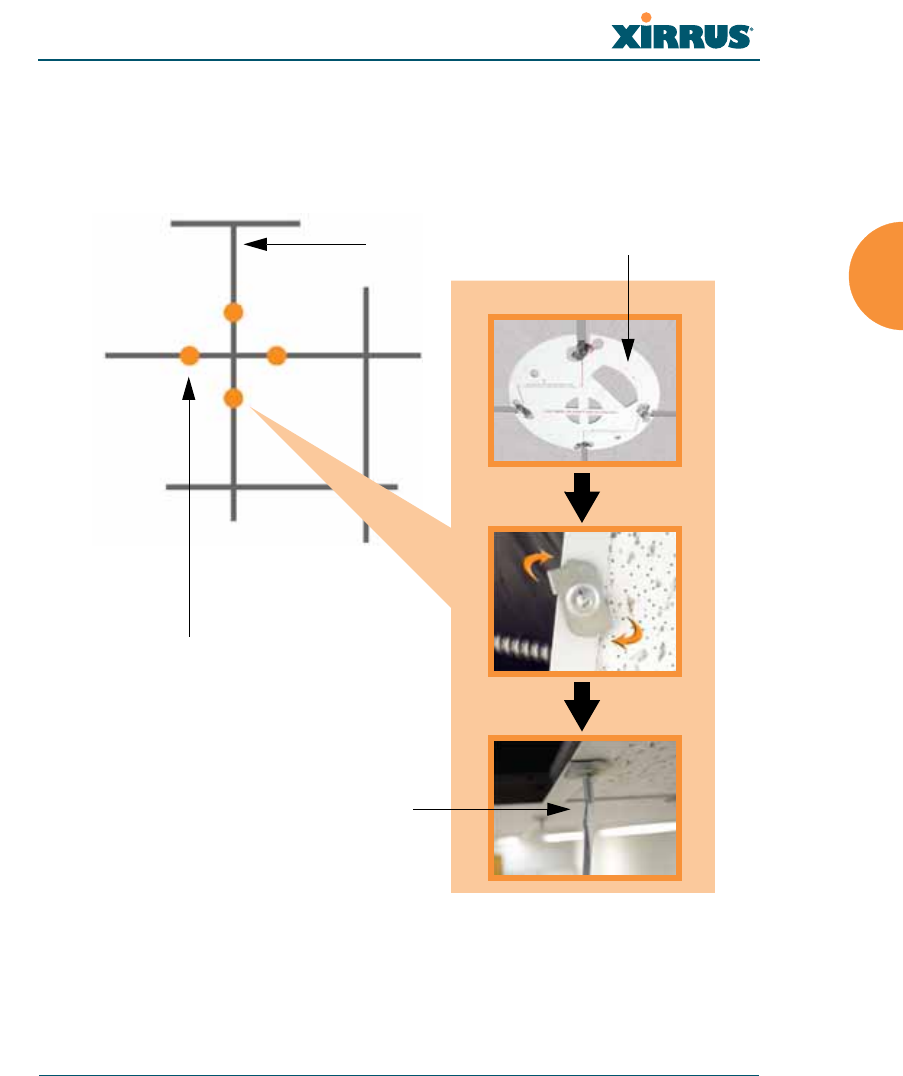
Wi-Fi Array
Installing the Wi-Fi Array 87
Secure the T-Bar Clips to the Ceiling Support Grid
The mounting template should be oriented so that the Array’s abg(n)2 omni-
directional monitoring IAP (radio) is pointing in the direction of the least required
wireless signal coverage—for example, a nearby exterior wall or entrance.
Figure 38. Attaching the T-Bar Clips to the Ceiling Grid
Use the mounting template to find the correct location for all four T-bar clips, then
twist the clips onto the metal ceiling support grid (Figure 38). Tighten the screw
posts to 10-12 lbf.ft (1.38-1.66 kgf.m).. Do not overtighten the screw posts. Disengage
the template from the four screw posts and remove the template from the ceiling.
Ceiling tile grid
T-bar clips (4 places)
Tighten the screw post
Template
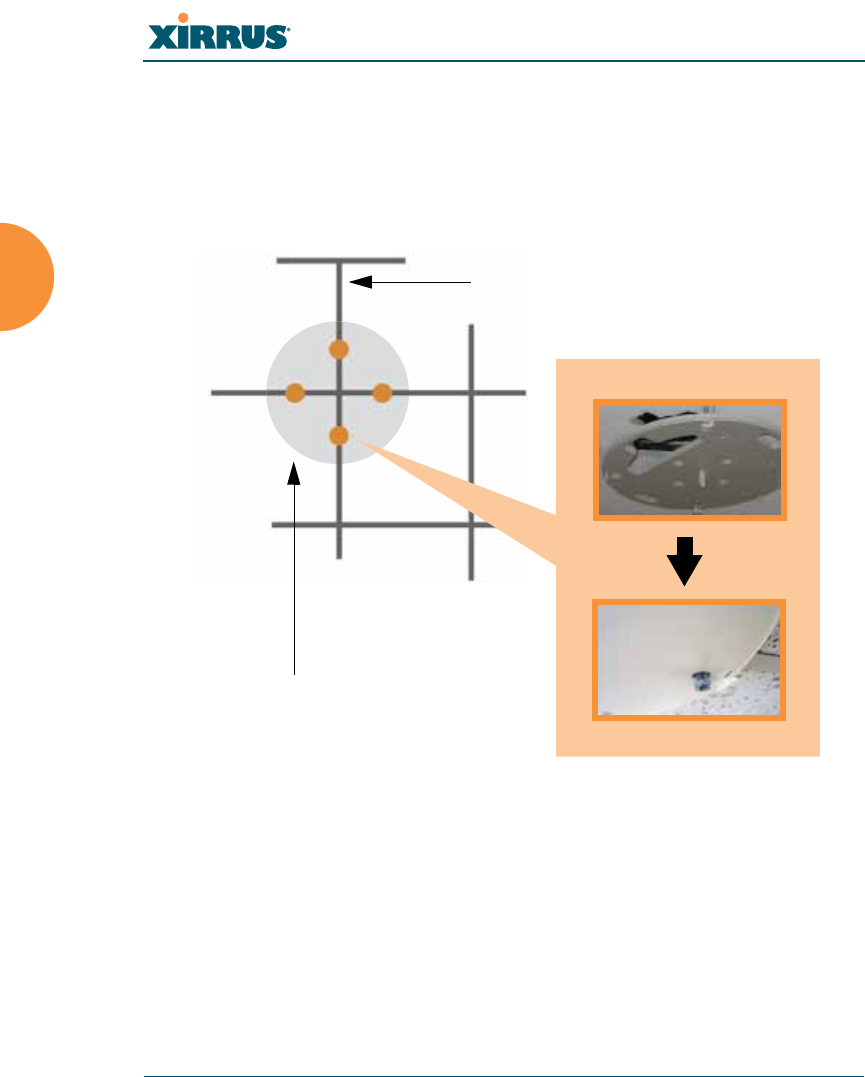
Wi-Fi Array
88 Installing the Wi-Fi Array
Installing the Mounting Plate
Locate the mounting plate on the four screw posts. Secure the plate to the four
clamps using the nuts provided. Tighten the nuts to 10-12 lbf.ft (1.38-1.66 kgf.m),
but do not overtighten.
Cut an access hole for the cables in the ceiling tile.
Figure 39. Installing the Mounting Plate
Tile grid
Mounting Plate
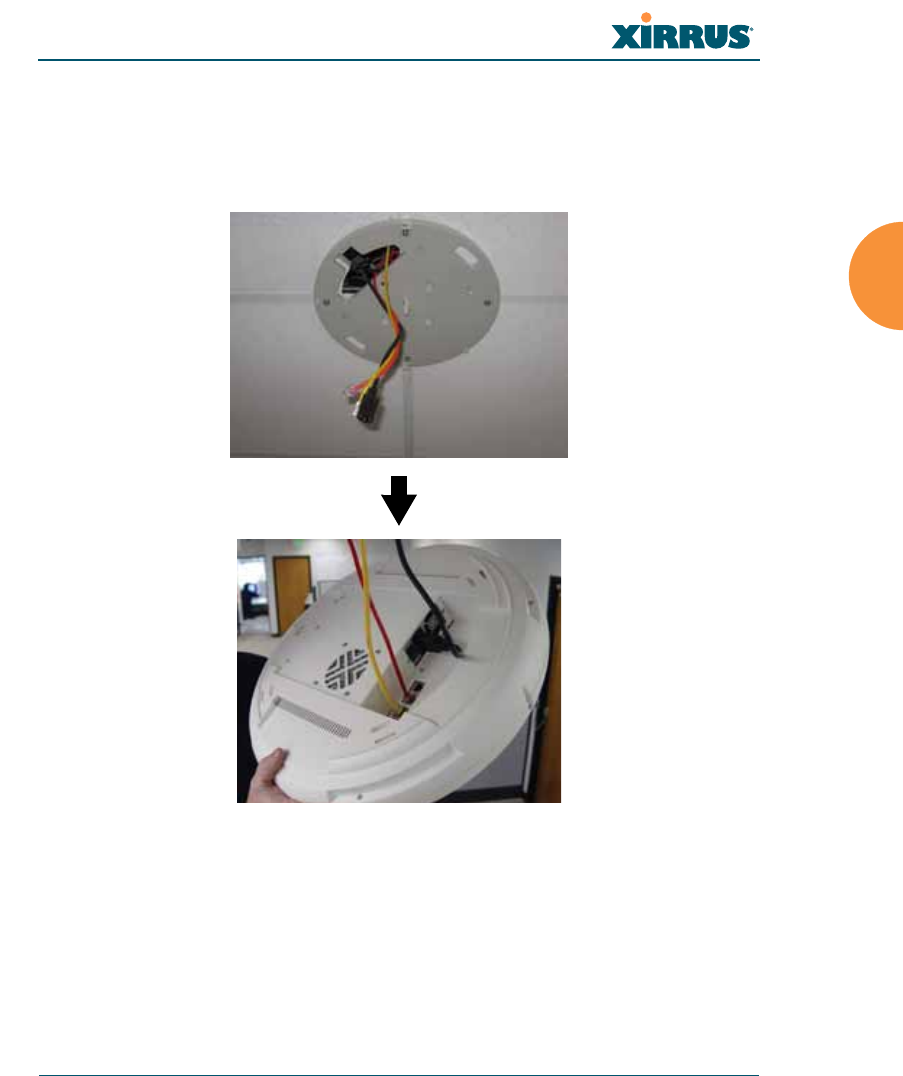
Wi-Fi Array
Installing the Wi-Fi Array 89
Connecting the Cables—AC Option
This section is for Array models that have a separate AC input. If supplying AC to
the Array directly (not using PoGE), refer to Figure 40 to connect cables.
Otherwise, skip to Connecting the Cables—PoGE Option.
Figure 40. Connecting the Cables
Feed the power and Ethernet cables through the access hole in the tile and the
mounting plate, then connect the cables to the Array. See also, “Wiring
Considerations” on page 84.
zAC power cord—connect to AC source and AC socket on Array.
zGigabit1 (mandatory)—the Array’s primary data and management port.
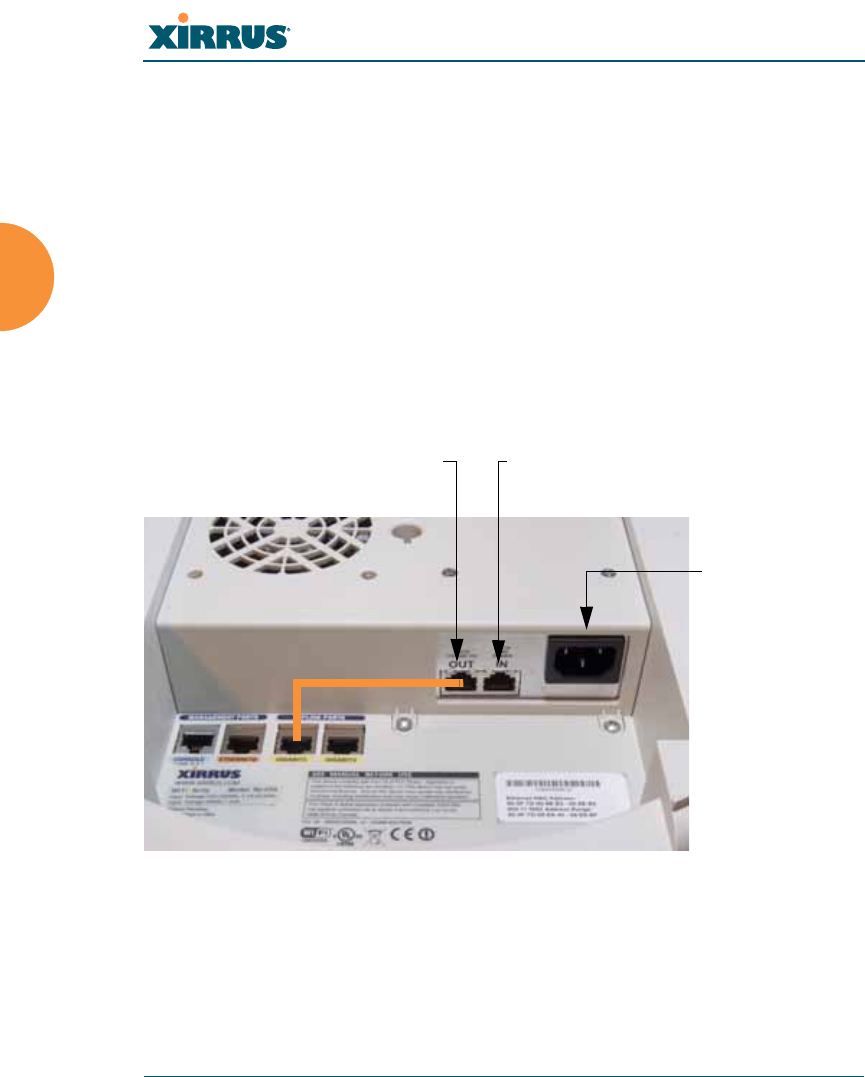
Wi-Fi Array
90 Installing the Wi-Fi Array
zGigabit2 (optional)—may be used for load balancing, fail-over, mirroring,
or increasing link speed to the wired network.
zFast Ethernet (optional)—for a management-only connection to the
Array.
zSerial cable (optional)—for connecting directly with the Array using CLI.
Connecting the Cables—PoGE Option
For the XS8, XS12, or XS16, use the procedure below and refer to Figure 41. For the
XS4, see “Connecting the Cables—AC Option” on page 89. All of these Array
models have an integrated splitter, so an external splitter is not needed.
For the XS8, XS12, or XS16:
Figure 41. Connecting the Cables (PoGE—XS8/XS12/XS16)
zFeed the Ethernet cable(s) through the access hole in the ceiling tile and
the mounting plate.
zConnect the Cat 5e or Cat 6 data cable coming from the PoGE injector to
the Array’s Data and Power IN port as shown in Figure 41.
Connect Data OUT to Gig1
port with short cable
Connect Cat 5e (from
PoGE Injector) to IN port
Optional AC
socket (unused
for PoGE)
8-, 12-, 16-port
Arrays
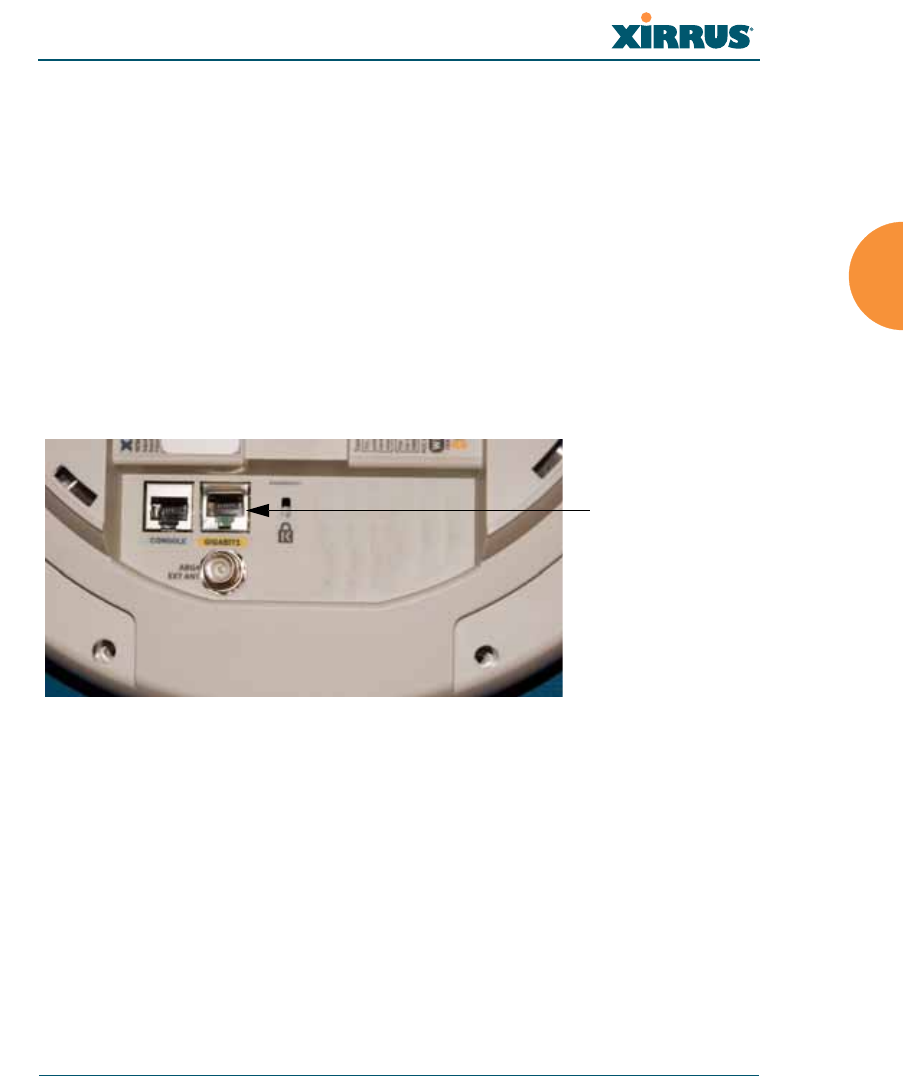
Wi-Fi Array
Installing the Wi-Fi Array 91
zConnect the supplied 6” orange Cat 5e data cable from the Array’s Data
OUT port to Gigabit1, as shown. Connect any additional Ethernet and
serial cables as required.
For the XS4:
Feed the PoGE cable through the access hole in the ceiling tile and the mounting
plate, then connect the cable to the Gigabit1 port on the XS4 Array. The Gigabit1
port is the data and management connection to the Array. A splitter is integrated
with this port.
Figure 42. Connecting the Cable (PoGE—XS4)
#Do not connect the cable from the injector directly to a Gigabit port! It must
be connected to the IN port (towards the right in Figure 41).
Connect Cat5e
(from PoGE
Injector)
to GIGABIT1
XS4
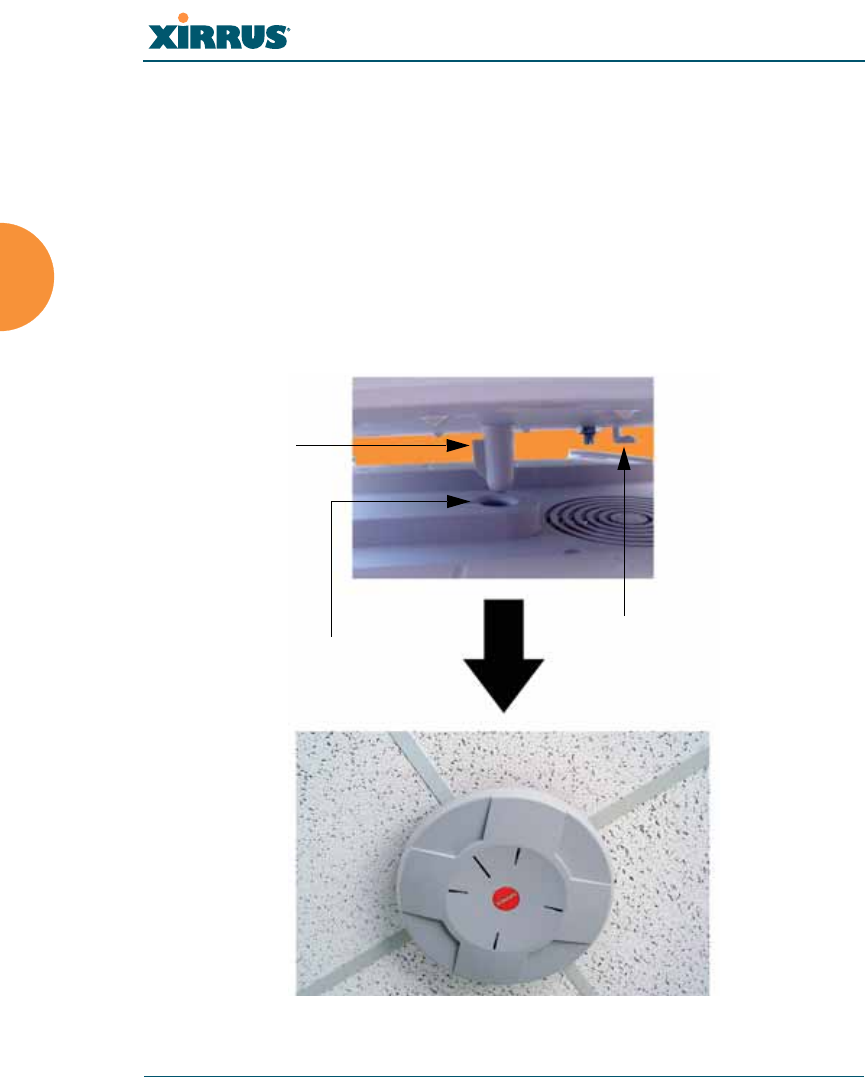
Wi-Fi Array
92 Installing the Wi-Fi Array
Attaching the Array to the Mounting Plate
Mounting all models except XS-3900/XS-3700
Align the Array with the key post on the mounting plate, then turn the Array to
the right to lock the unit into place at the 4 lugs—similar to a smoke detector.
Figure 43. Attaching the Unit (XS4 shown)
#Before attaching the Array to the mounting plate, verify that it is powering
up. The Ethernet link LED lights up and the radio LEDs on the front of the
unit will illuminate in rotation, indicating that the Wi-Fi Array software is
loading and the unit is functioning correctly.
Key post
Lug
Alignment hole
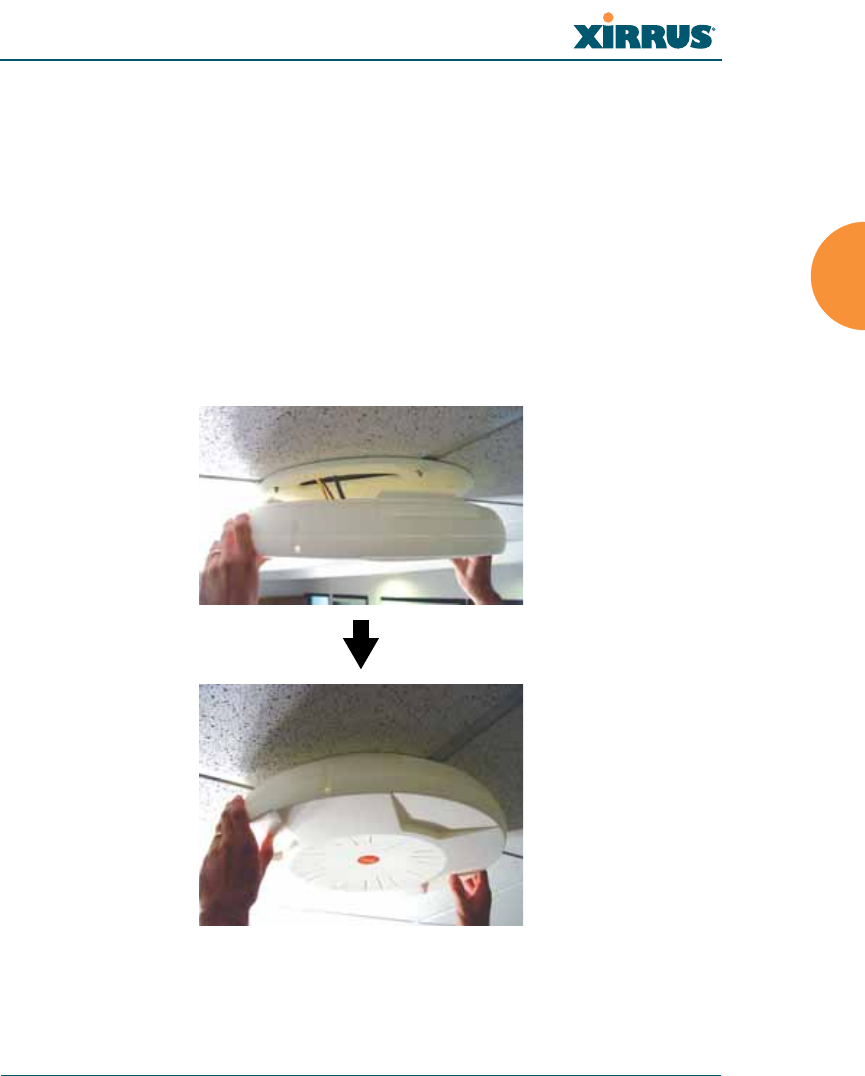
Wi-Fi Array
Installing the Wi-Fi Array 93
See Also
Installation Workflow
Installing Your Wi-Fi Array
Mounting the Wi-Fi Array on a Wall (XS4 and XS-3500)
Mounting Array on a Wall (All models except 4-port Arrays)
Securing the Array
Attaching the XS-3900/XS-3700
Align the port recess on the Array with the access hole in the mounting plate, then
connect the Array with the lugs on the mounting plate (4 places) and turn the
Array clockwise to lock the unit into place (similar to a smoke detector).
Figure 44. Attaching the Unit (XS-3900)
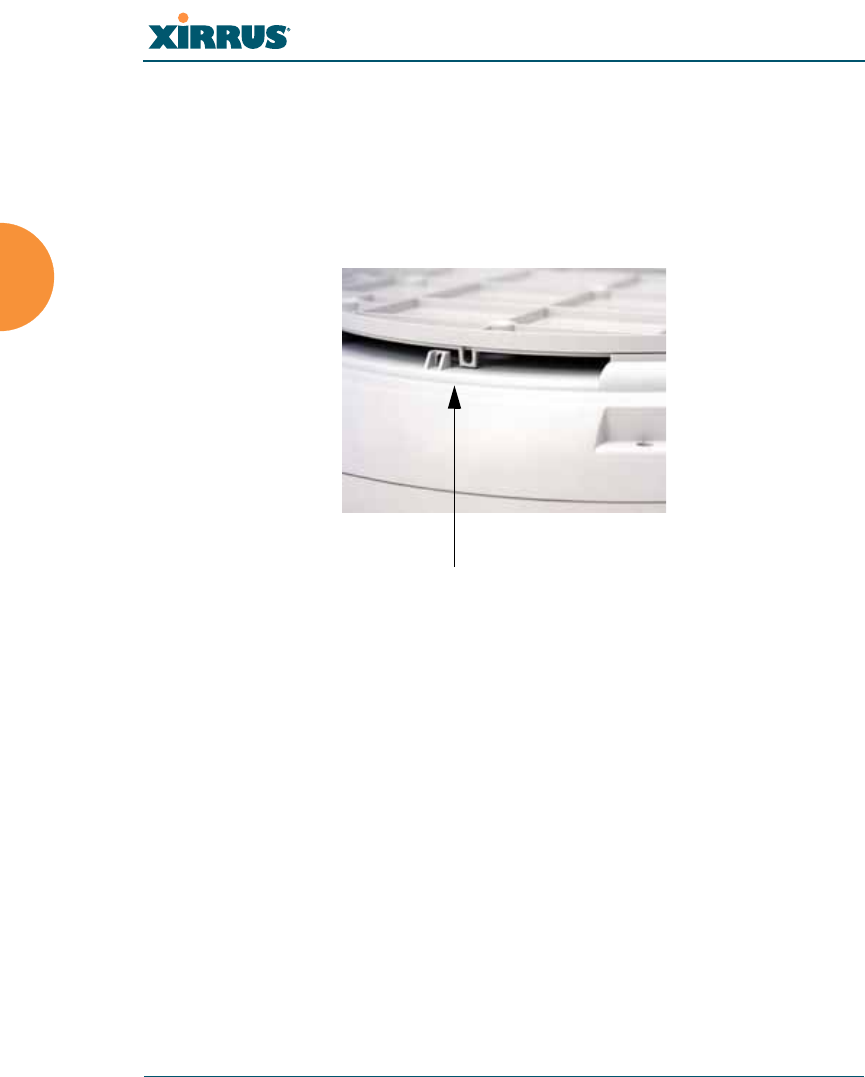
Wi-Fi Array
94 Installing the Wi-Fi Array
Securing the Array
For added security, there is a locking bracket incorporated into the mounting
plate, which will accept a small luggage-style padlock (if desired). There is also a
Kensington lock slot located near the Ethernet ports. In addition, the mounting
plate incorporates a positive locking tab that prevents the unit from being
inadvertently released.
Figure 45. Securing the Array
Now that the Array is physically installed, you must run the Express Setup
procedure from the unit’s Web Management Interface to enable the radios and
establish initial system configuration settings. Go to “Powering Up the Wi-Fi
Array” on page 107.
See Also
Installation Workflow
Installing Your Wi-Fi Array
Mounting the Wi-Fi Array on a Wall (XS4 and XS-3500)
Mounting Array on a Wall (All models except 4-port Arrays)
Mounting the Array on a Ceiling
Powering Up the Wi-Fi Array
Locking bracket
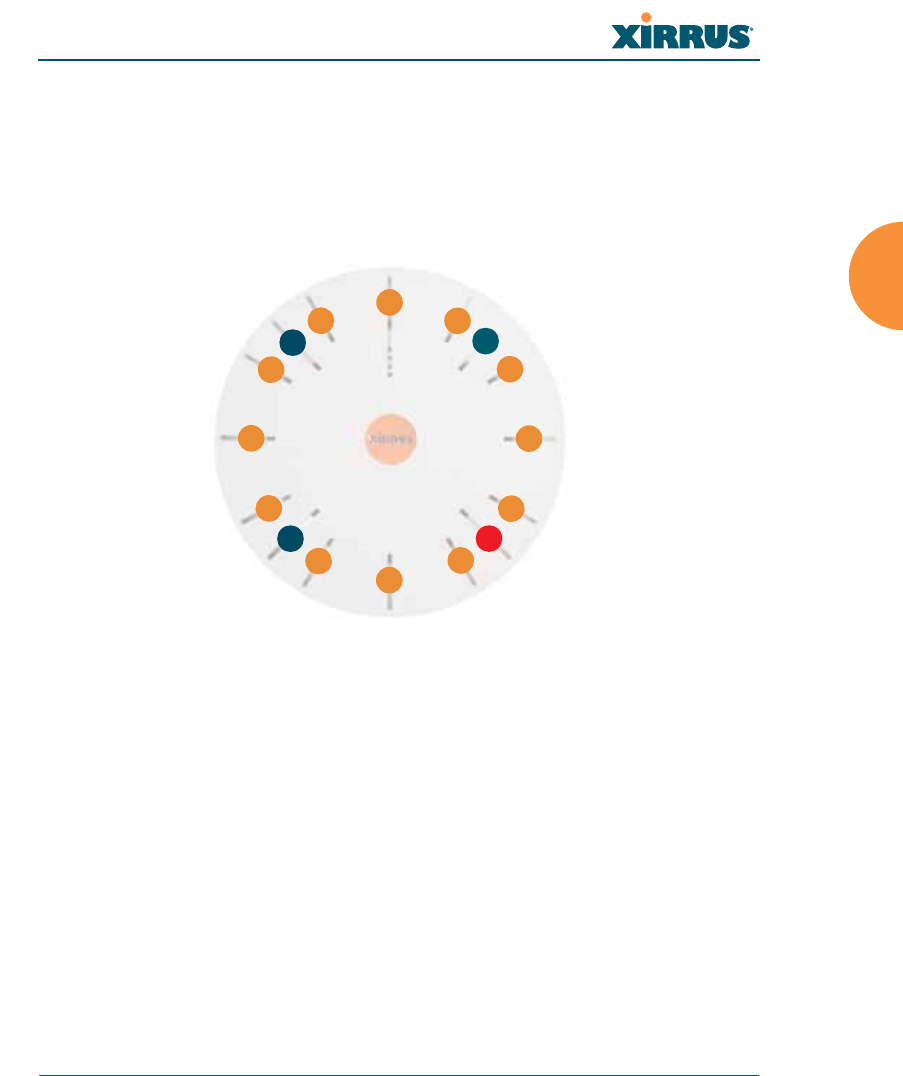
Wi-Fi Array
Installing the Wi-Fi Array 95
Dismounting the Array
To dismount the Array, place your fingers so as to increase the space between the
Array and the mounting plate at the positions indicated by the decals on the
mounting plate—these are aligned with IAPs (radios) abg(n)1 and abg(n)3, as
indicated on the clock-face of the Array.
Figure 46. IAP Positions (XS16 shown)
See Also
Installation Workflow
Installing Your Wi-Fi Array
Mounting the Wi-Fi Array on a Wall (XS4 and XS-3500)
Mounting Array on a Wall (All models except 4-port Arrays)
Mounting the Array on a Ceiling
Securing the Array
a1
abg1
a2
a3
a4
abg2
a5
a6
a7
abg3
a8
a9
a10
abg4
a11
a12

Wi-Fi Array
96 Installing the Wi-Fi Array
Mounting Array on a Wall (All models except 4-port Arrays)
This procedure is applicable to the Wi-Fi Array’s 16-radio models, 12-radio
models, and 8-radio models. If you are mounting a 4-radio model, go to
“Mounting the Wi-Fi Array on a Wall (XS4 and XS-3500)” on page 101.
The wall mounting assembly kit is used to mount the Wi-Fi Array (except for 4-
port models) on a wall, instead of the traditional ceiling mount—if mounting the
Array on the ceiling is impractical at your location.
Kit Contents (Wall Mount Assembly)
The wall mount assembly kit includes the following items:
z5 x SNAPTOGGLE™ toggle bolts (for attaching the wall bracket to the
wall)
z4 x 1/4 inch bolt assemblies (for attaching the mounting plate to the wall
bracket)
zWall Mounting Bracket
Tools Required
zPower drill
z1/2 inch (13mm) drill bit
zCross head screwdriver
z1/4 inch nut wrench
zPencil
zLevel
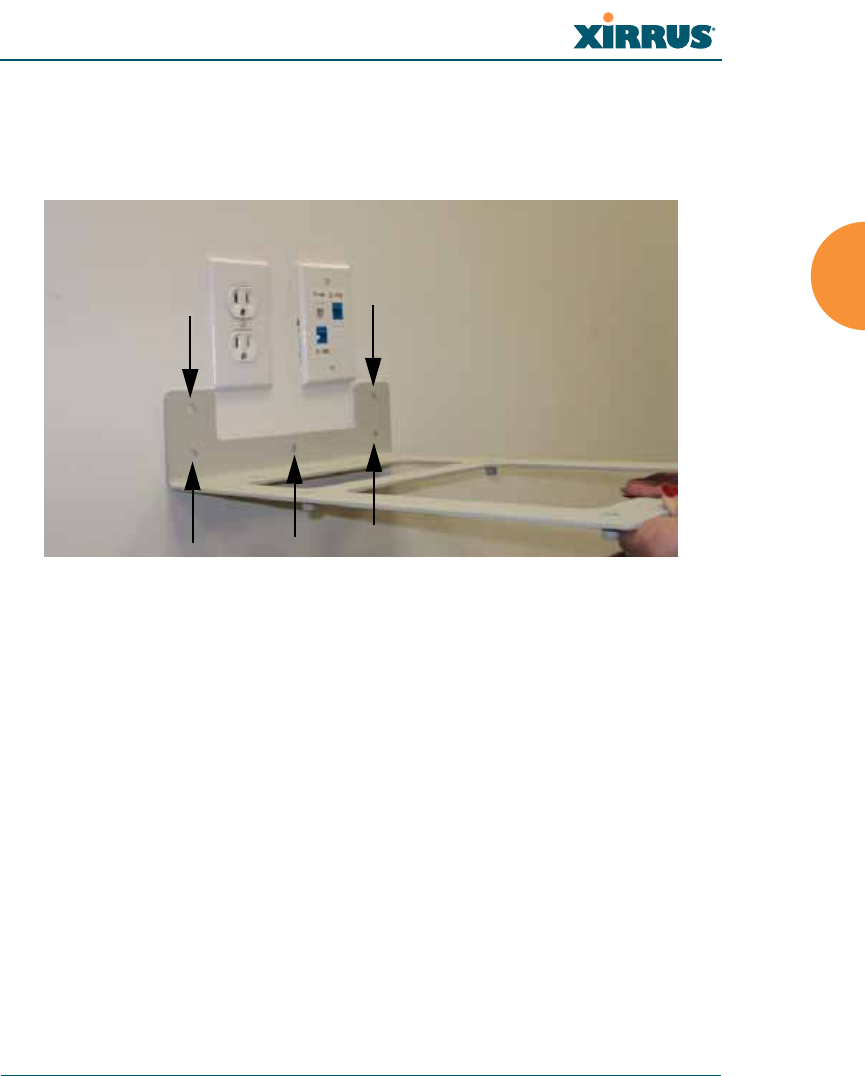
Wi-Fi Array
Installing the Wi-Fi Array 97
Mark the Wall Position
1. Use the Wall Mounting Bracket as a template and mark the locations on
the wall for the mounting holes.
Figure 47. Wall Mount—Marking the Holes
When marking the holes, ensure that the mounting plate is level—you
may need assistance.
#The bracket must be secured to the wall in 5 places, using the 2 holes at the
top and the 3 holes at the bottom (5 toggle bolts are provided).
Mark holes (5 places)
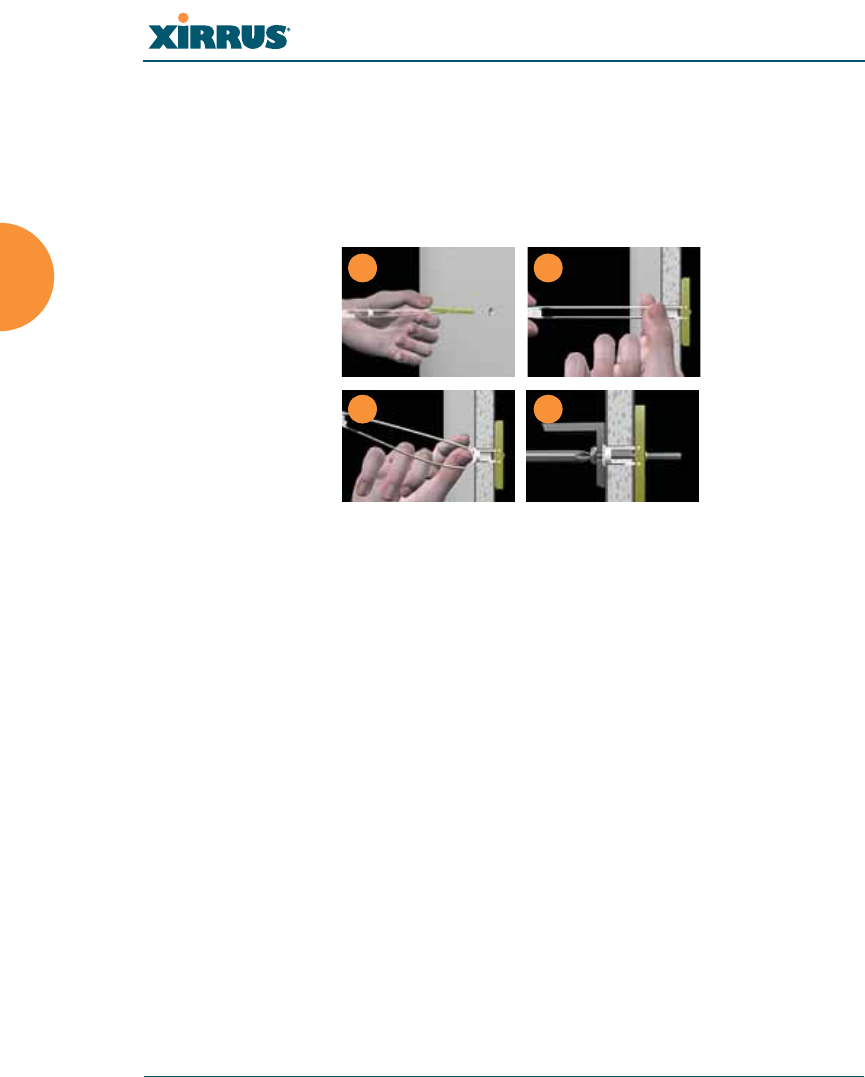
Wi-Fi Array
98 Installing the Wi-Fi Array
Install the SNAPTOGGLE™ Toggle Bolts
2. At the locations you marked in Step 1, drill a 1/2 inch (13mm) hole (there
must be a minimum clearance behind the wall of 1 7/8 inches—48mm).
3. (Refer to Figure 48, graphic A) Hold the metal channel flat alongside the
plastic straps and slide the channel through the hole.
Figure 48. Installing the Toggle Bolts
4. (Refer to Figure 48, graphic B) Hold the strap handle between your
thumb and forefinger and pull towards you until the metal channel rests
flush behind the wall.
Using your other hand, now slide the plastic cap along the straps until the
flange of the cap is flush with wall.
The straps provide a one-way ratcheting mechanism (similar to a cable tie).
Ensure that the toggle bolt assembly is oriented correctly (as shown) before
sliding the plastic cap along the straps.
5. (Refer to Figure 48, graphic C) Break the straps at the wall, flush with the
flange of the cap. The straps can be broken by pushing them from side-to-
side and simply snapping them off.
Figure 48, Graphic D shows a cutaway example of how the toggle bolt is
used to secure an item to the wall (in our case, the item is the Wall
Mounting Bracket—secured to the wall with 5 toggle bolts.
Do not attach the Wall Mounting Bracket to the wall at this time.
AB
C D
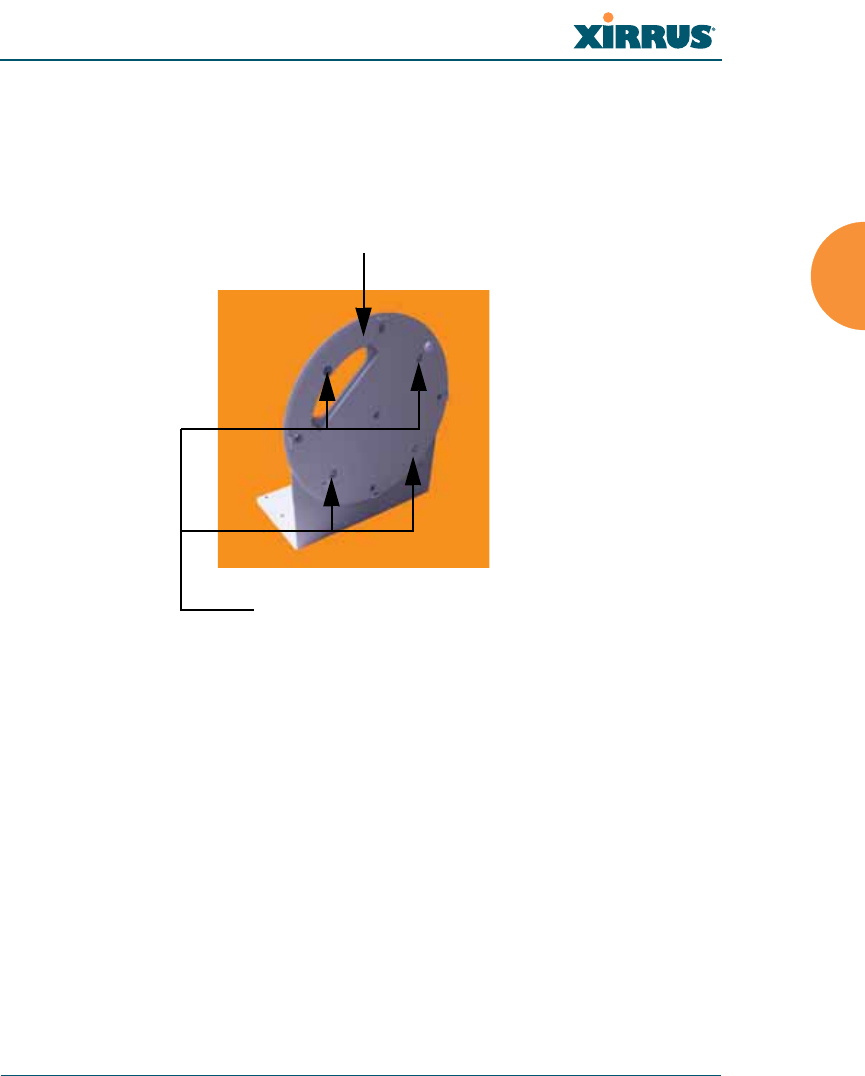
Wi-Fi Array
Installing the Wi-Fi Array 99
Attach the Mounting Plate to the Wall Mounting Bracket
6. Secure the Wi-Fi Array’s mounting plate to the Wall Mounting Bracket, in
4 places. Tighten the bolts to a torque of 10–12 lbf.ft (1.38–1.66 kgf.m).
Do not overtighten the bolts.
Figure 49. Attaching the Wall Mounting Plate
Attach the Wall Mounting Bracket/Plate Assembly to the Wall
7. Secure the Wall Mounting Bracket (with attached Mounting Plate) to the
wall at the 5 toggle bolt anchors you created in Steps 1 through 5—using
all 5 places.
Mounting Plate
Secure (x4 bolt assemblies)
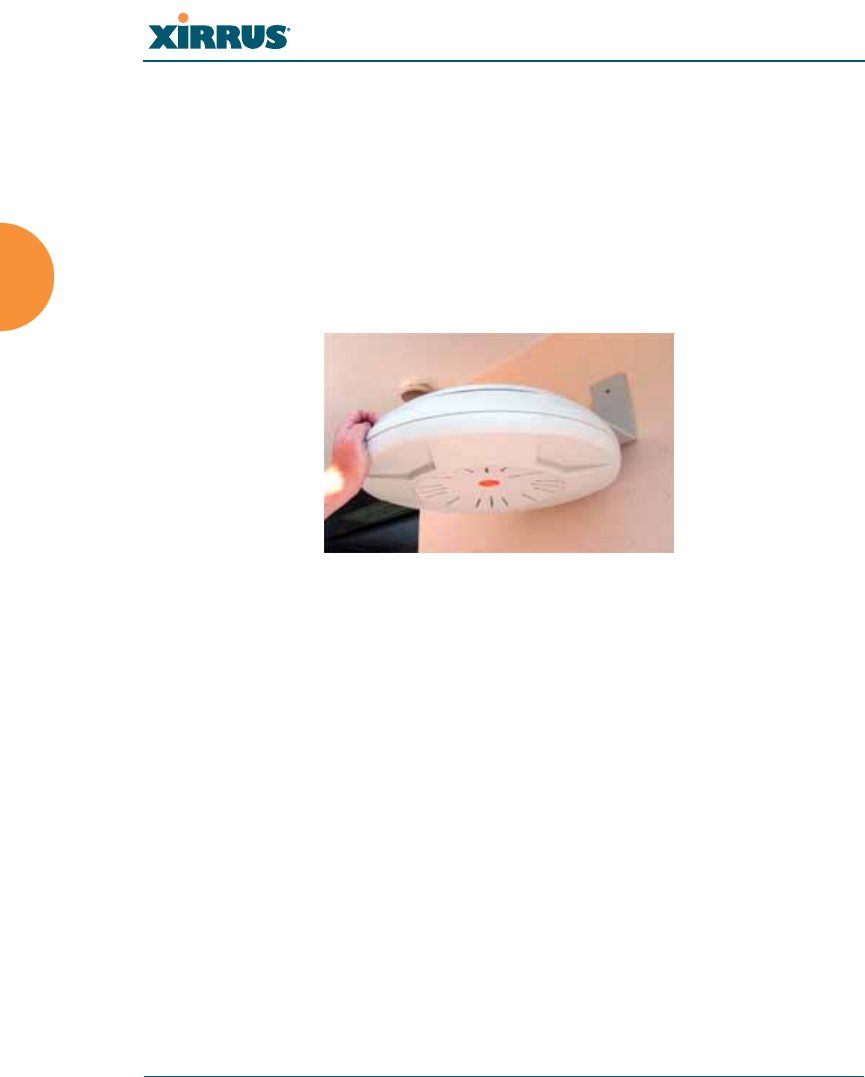
Wi-Fi Array
100 Installing the Wi-Fi Array
Mount the Array
8. Mount the Wi-Fi Array to the Wall Mounting Bracket in the same way
that you would mount the Array to a ceiling mount (the procedure is
identical). See “Attaching the Array to the Mounting Plate” on page 92 or
“Attaching the XS-3900/XS-3700” on page 93.
Figure 50. Mounting the Array on a Wall
See Also
Installation Workflow
Installing Your Wi-Fi Array
Mounting the Wi-Fi Array on a Wall (XS4 and XS-3500)
Mounting the Array on a Ceiling
Securing the Array
#Figure 50 shows the orientation of the Wi-Fi Array when mounted on a wall.
It is not intended to show a fully installed Array.

Wi-Fi Array
Installing the Wi-Fi Array 101
Mounting the Wi-Fi Array on a Wall (XS4 and XS-3500)
This procedure is applicable to the 4 radio models of the Wi-Fi Array (XS4 and
XS-3500). If you are mounting a 16-, 12-, or 8-radio model, go to “Mounting Array
on a Wall (All models except 4-port Arrays)” on page 96.
The wall mounting assembly kit is used to mount a 4-port Wi-Fi Array on a wall,
instead of the traditional ceiling mount—where mounting the Array on the
ceiling may be impractical at your location.
Kit Contents (Wall Mount Assembly)
The wall mount assembly kit includes the following items:
z5 x SNAPTOGGLE™ toggle bolts (for attaching the wall bracket to the
wall)
z4 x 1/4 inch bolt assemblies (for attaching the mounting plate to the wall
bracket)
zWall Mounting Bracket
Tools Required
zPower drill
z1/2 inch (13mm) drill bit
zCross head screwdriver
z1/4 inch nut wrench
zPencil
zLevel
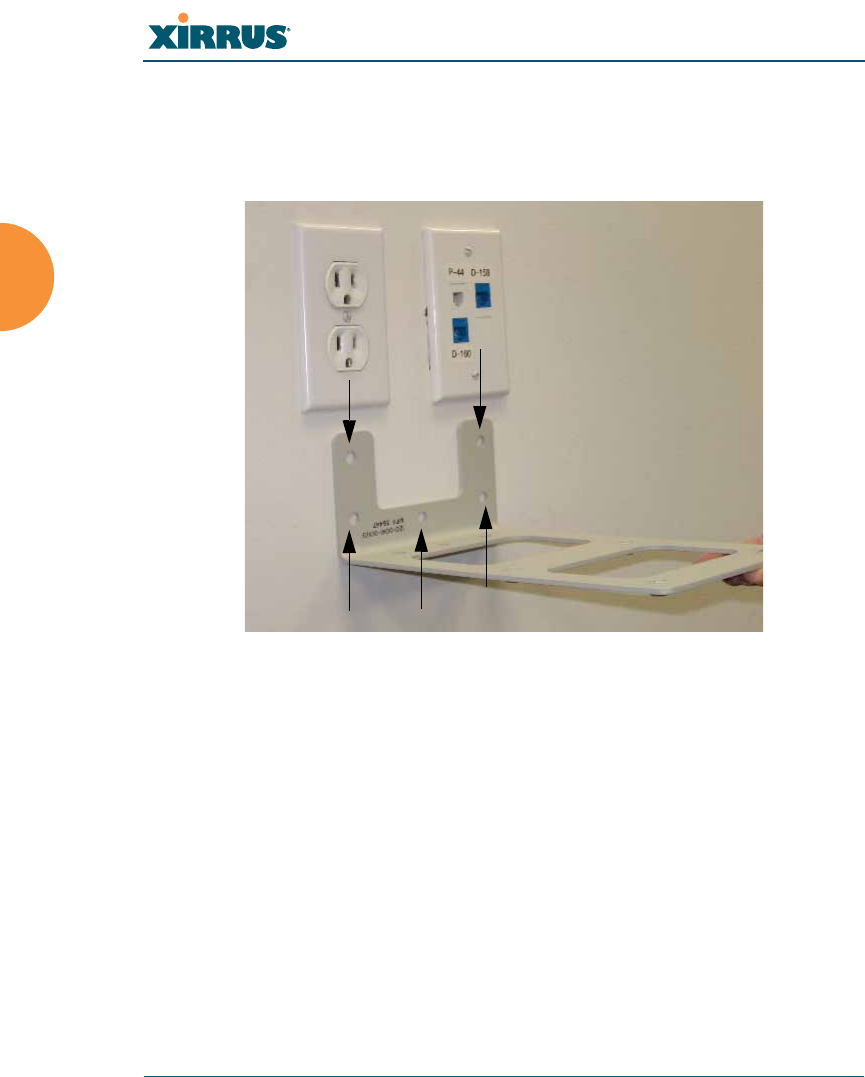
Wi-Fi Array
102 Installing the Wi-Fi Array
Mark the Wall Position
1. Use the Wall Mounting Bracket as a template and mark the locations on
the wall for the mounting holes.
Figure 51. Wall Mount—Marking the Holes
The bracket must be secured to the wall in 5 places, using the top 2 holes
and the bottom 3 holes (5 toggle bolts are provided).
When marking the holes, ensure that the mounting plate is level—you
may need assistance.
Install the SNAPTOGGLE™ Toggle Bolts
2. At the locations you marked in Step 1, drill a 1/2 inch (13mm) hole (there
must be a minimum clearance behind the wall of 1 7/8 inches—48mm).
Mark holes (5 places)
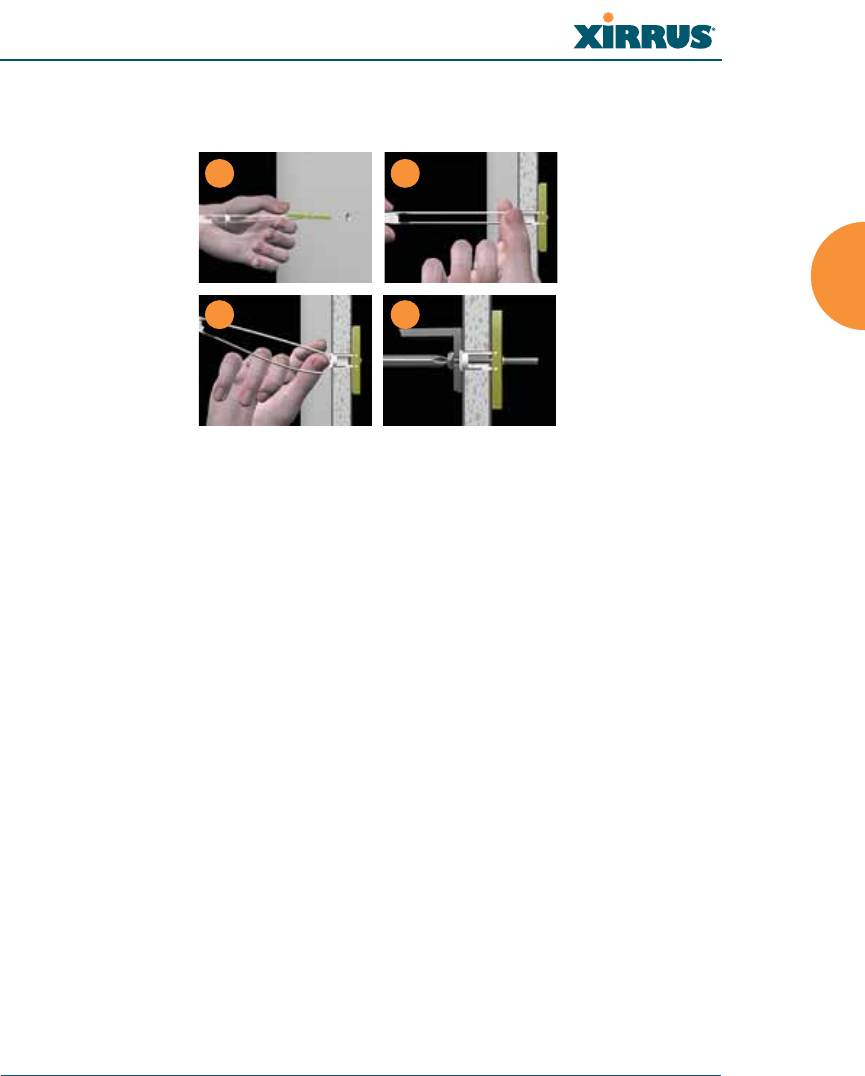
Wi-Fi Array
Installing the Wi-Fi Array 103
3. (Refer to Figure 52, graphic A) Hold the metal channel flat alongside the
plastic straps and slide the channel through the hole.
Figure 52. Installing the Toggle Bolts
4. (Refer to Figure 52, graphic B) Hold the strap handle between your
thumb and forefinger and pull towards you until the metal channel rests
flush behind the wall.
Using your other hand, now slide the plastic cap along the straps until the
flange of the cap is flush with wall.
The straps provide a one-way ratcheting mechanism (similar to a cable tie).
Ensure that the toggle bolt assembly is oriented correctly (as shown) before
sliding the plastic cap along the straps.
5. (Refer to Figure 52, graphic C) Break the straps at the wall, flush with the
flange of the cap. The straps can be broken by pushing them from side-to-
side and simply snapping them off.
Figure 52, Graphic D shows a cutaway example of how the toggle bolt is
used to secure an item to the wall (in our case, the item is the Wall
Mounting Bracket—secured to the wall with 5 toggle bolts).
Do not attach the Wall Mounting Bracket to the wall at this time.
AB
C D
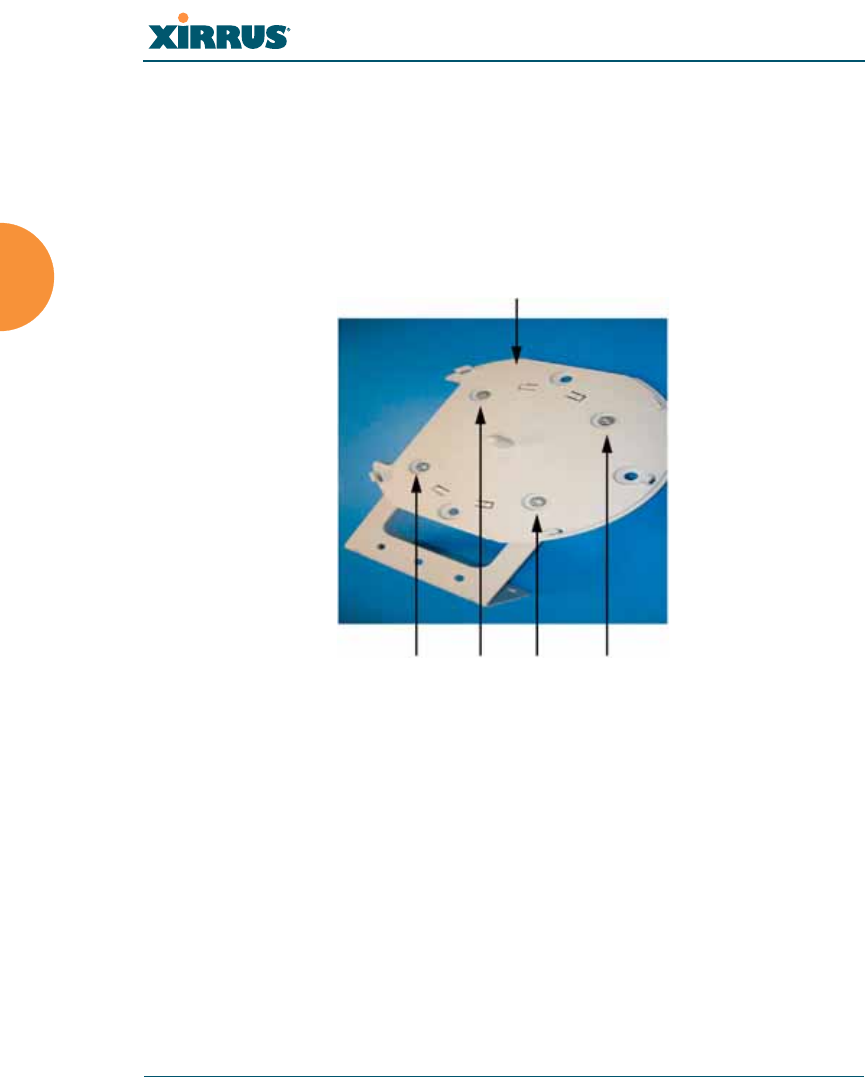
Wi-Fi Array
104 Installing the Wi-Fi Array
Attach the Mounting Plate to the Wall Mounting Bracket
6. Secure the Wi-Fi Array’s mounting plate to the Wall Mounting Bracket, in
4 places.
Tighten the bolts to a torque of 10–12 ft-lb (1.38–1.66 kg.m).
Do not overtighten the bolts.
Figure 53. Attaching the Array Mounting Plate
Secure (x4 bolt assemblies)
Mounting Plate
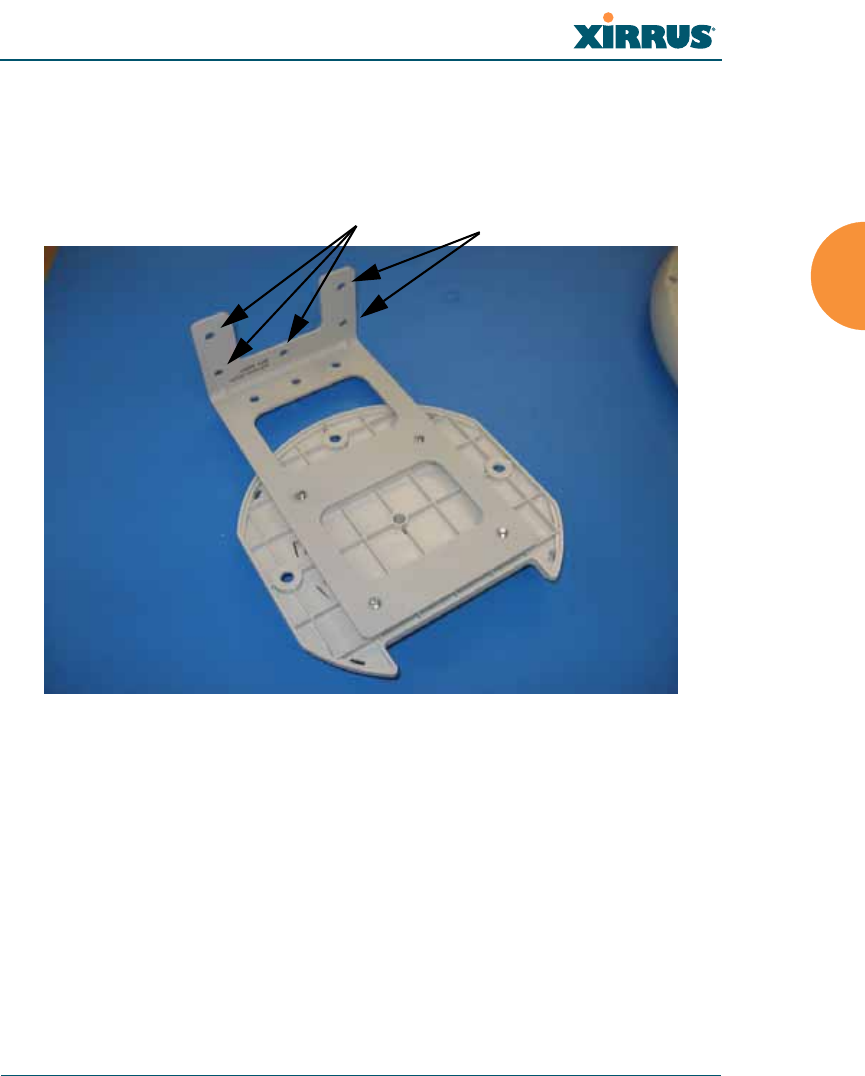
Wi-Fi Array
Installing the Wi-Fi Array 105
Attach the Wall Mounting Bracket/Plate Assembly to the Wall
7. Secure the Wall Mounting Bracket (with attached Mounting Plate) to the
wall at the 5 toggle bolt anchors you created in Steps 2 through 5—using
all 5 places.
Figure 54. Attaching the Wall Mounting Bracket to the Wall
Secure with 5 toggle bolts